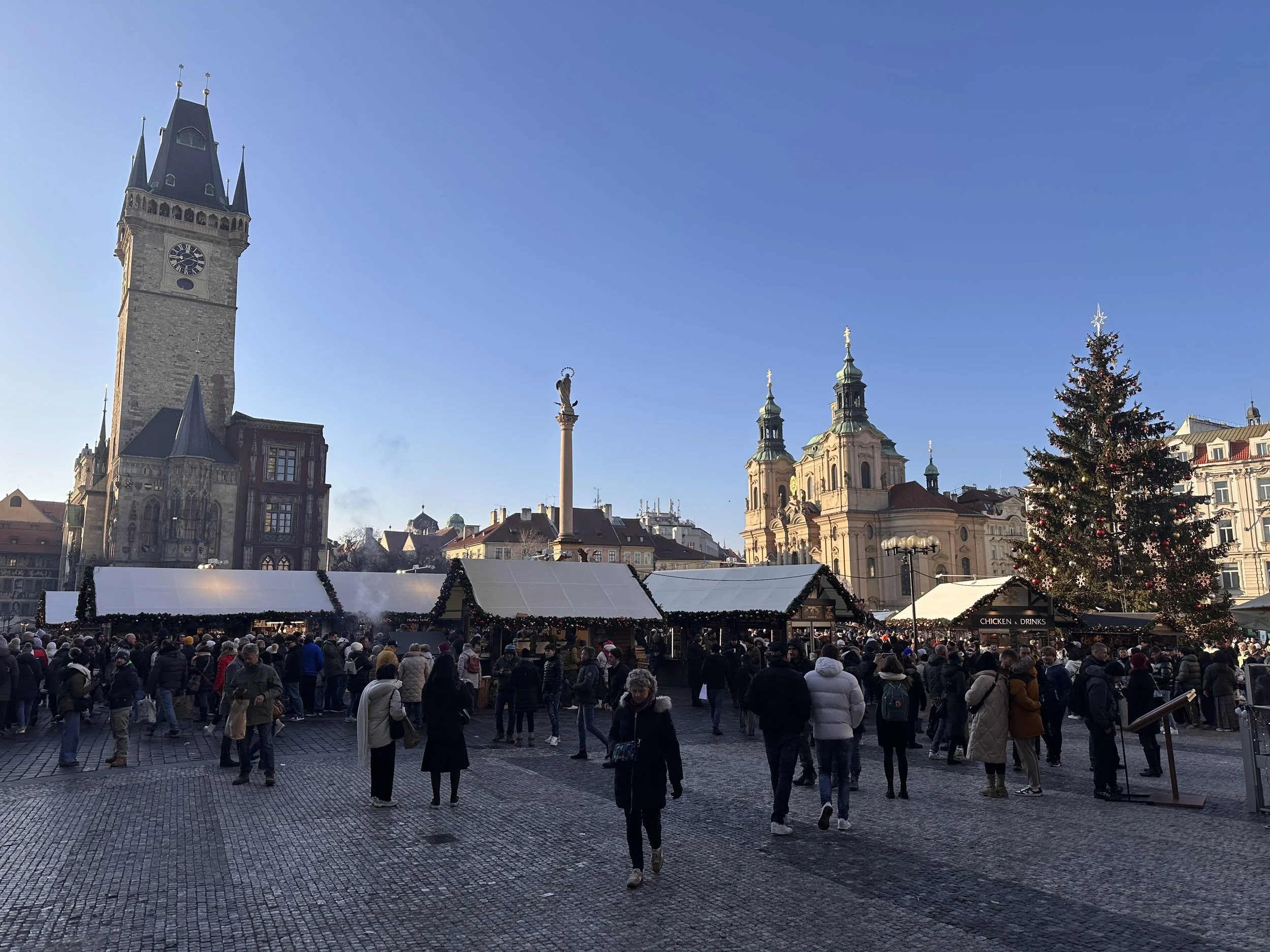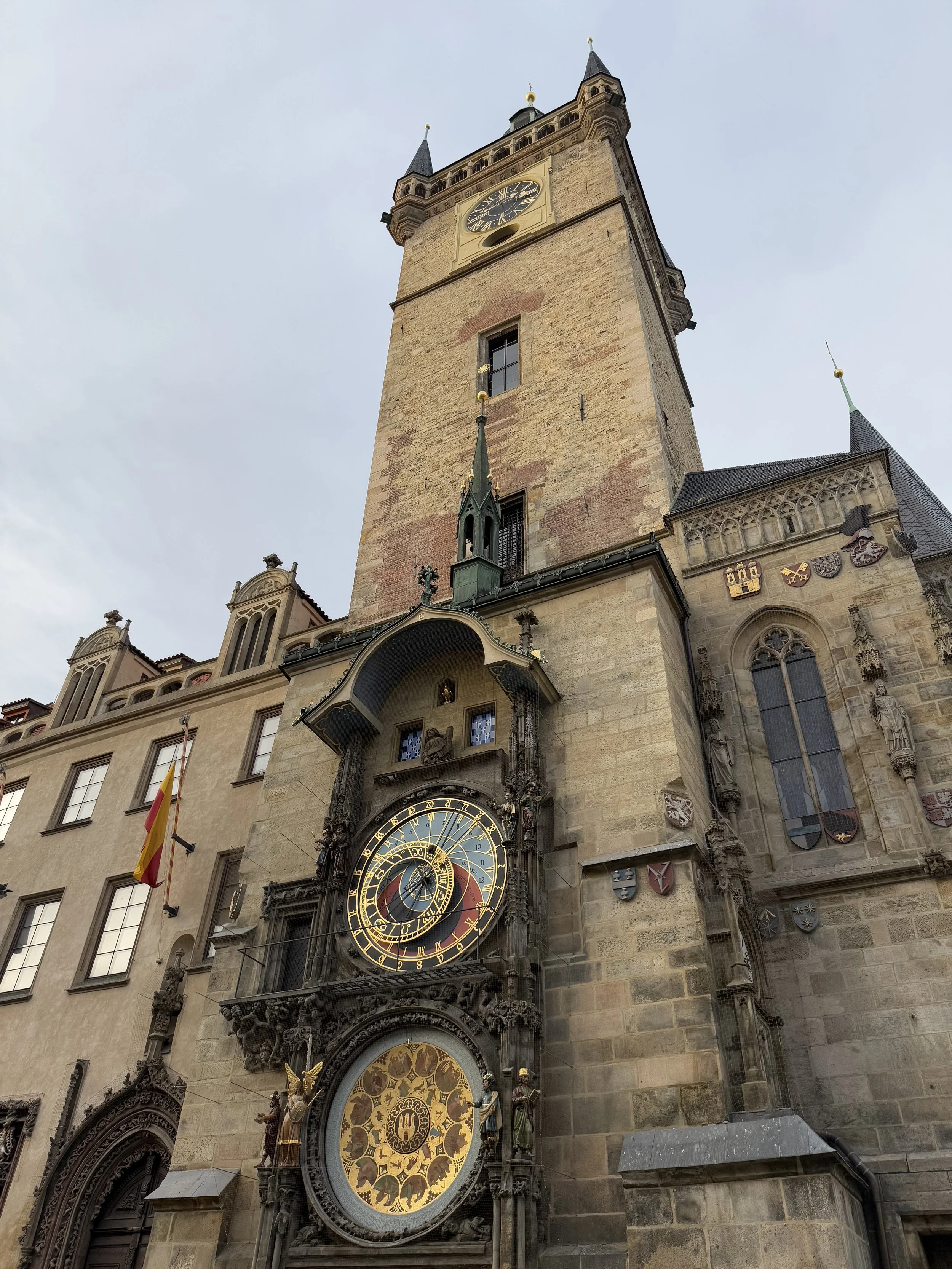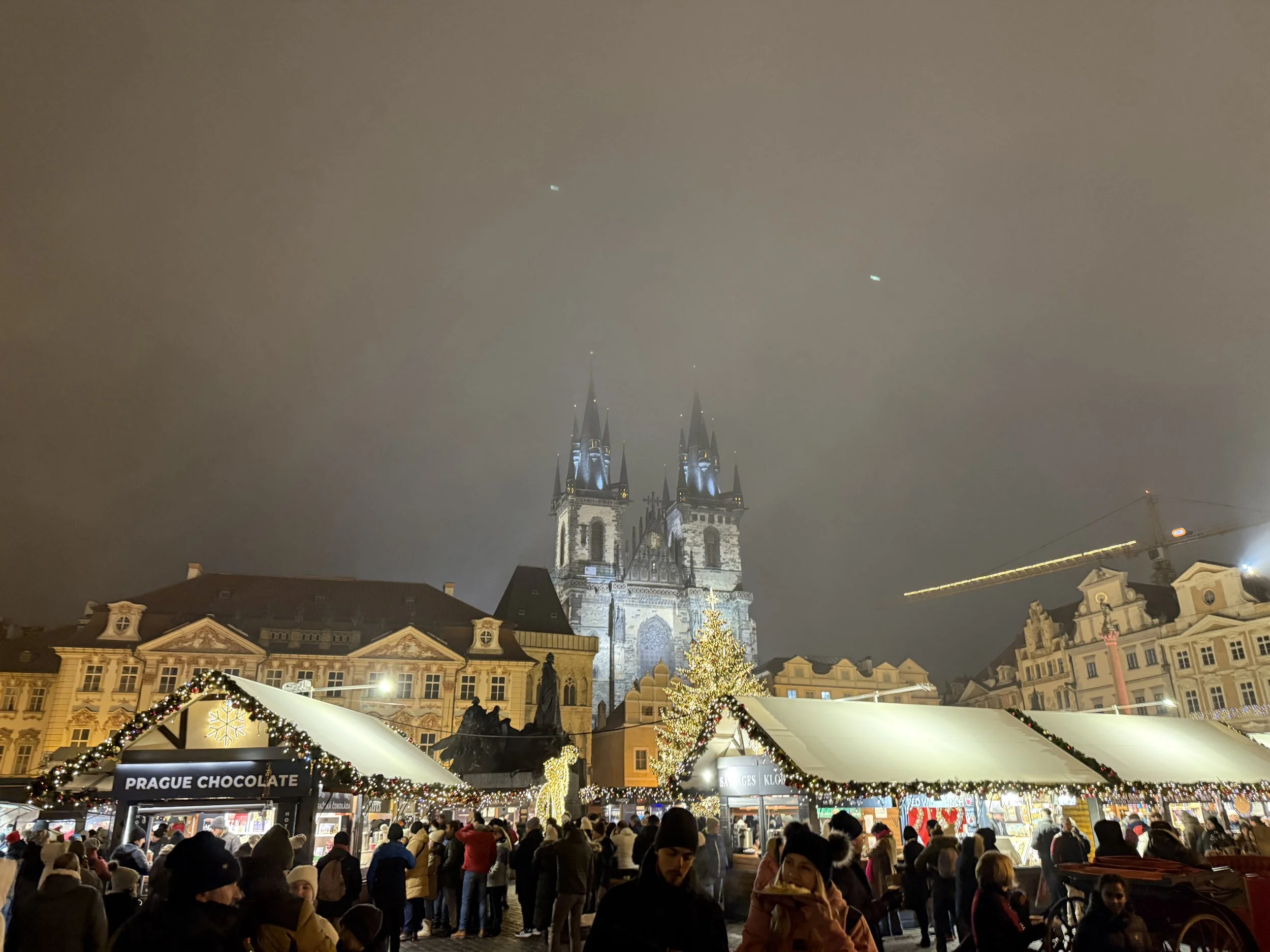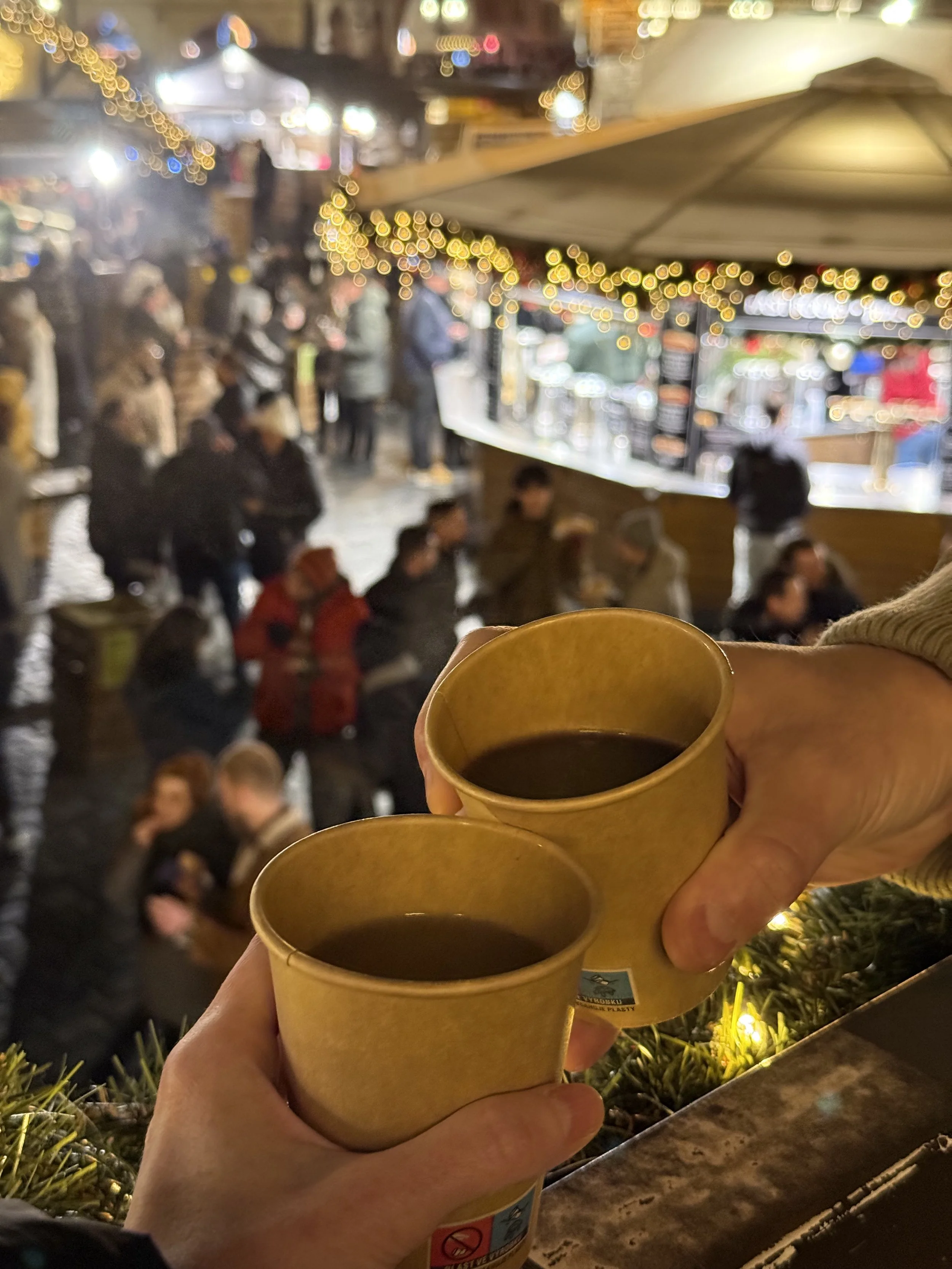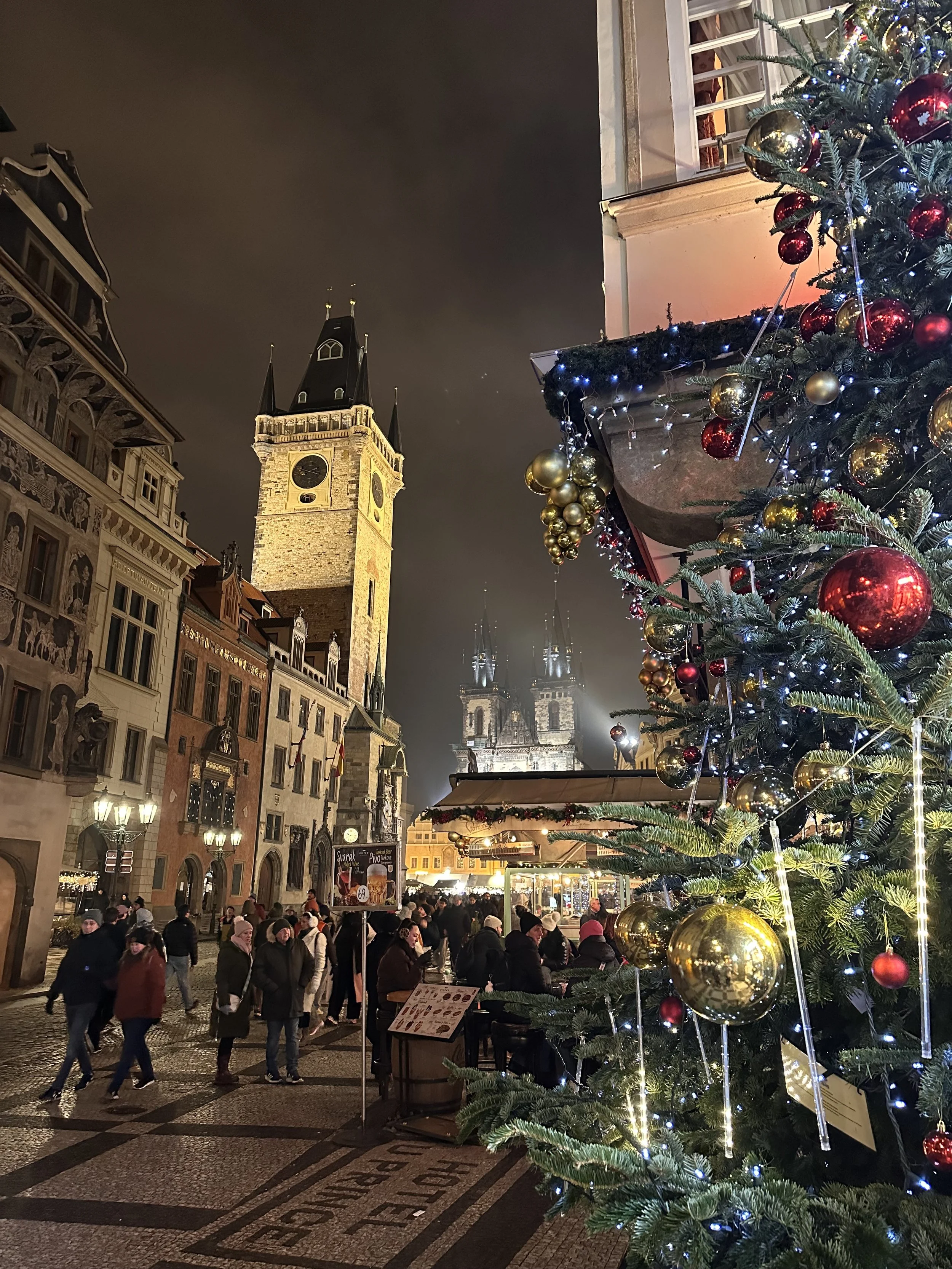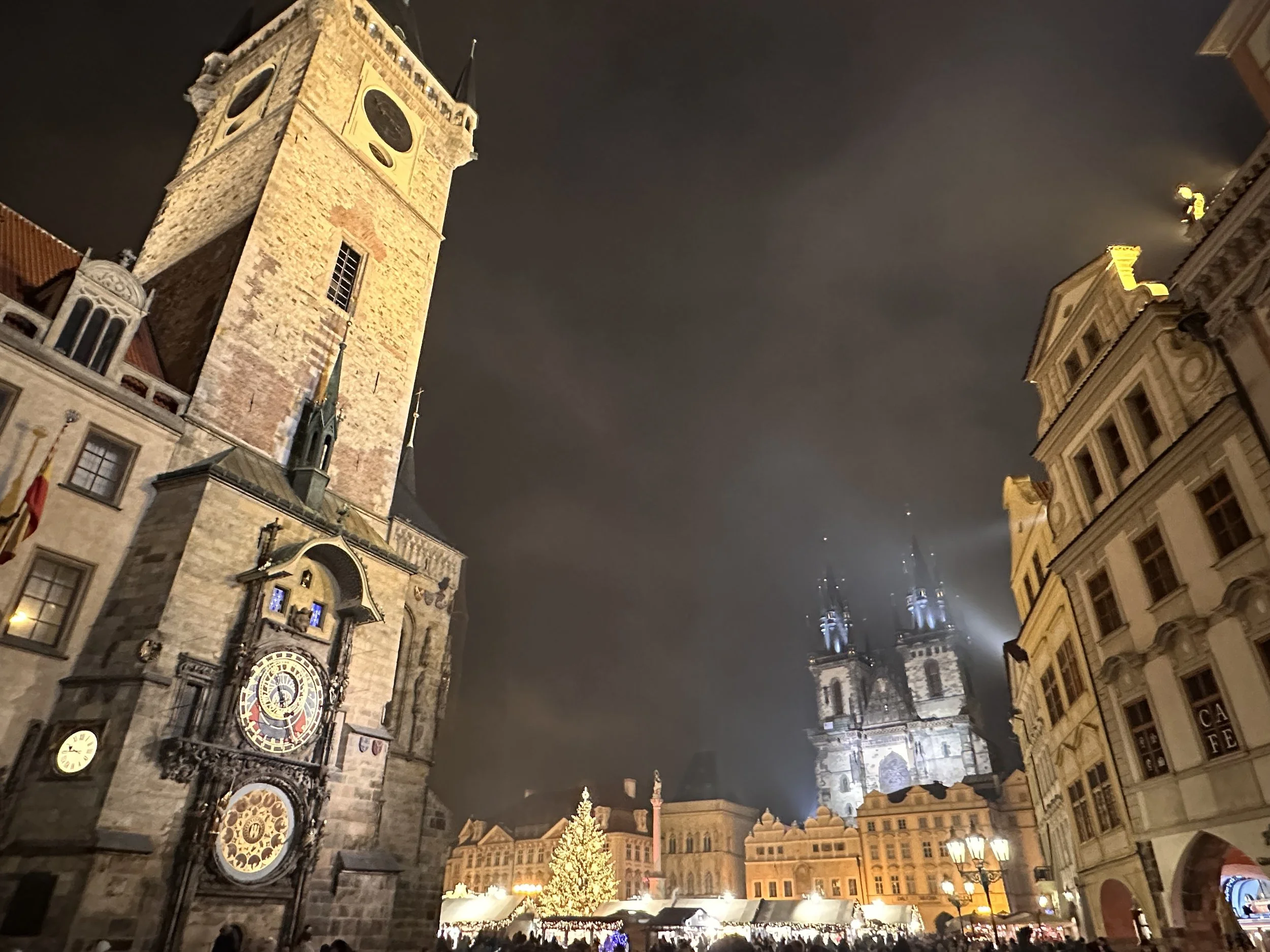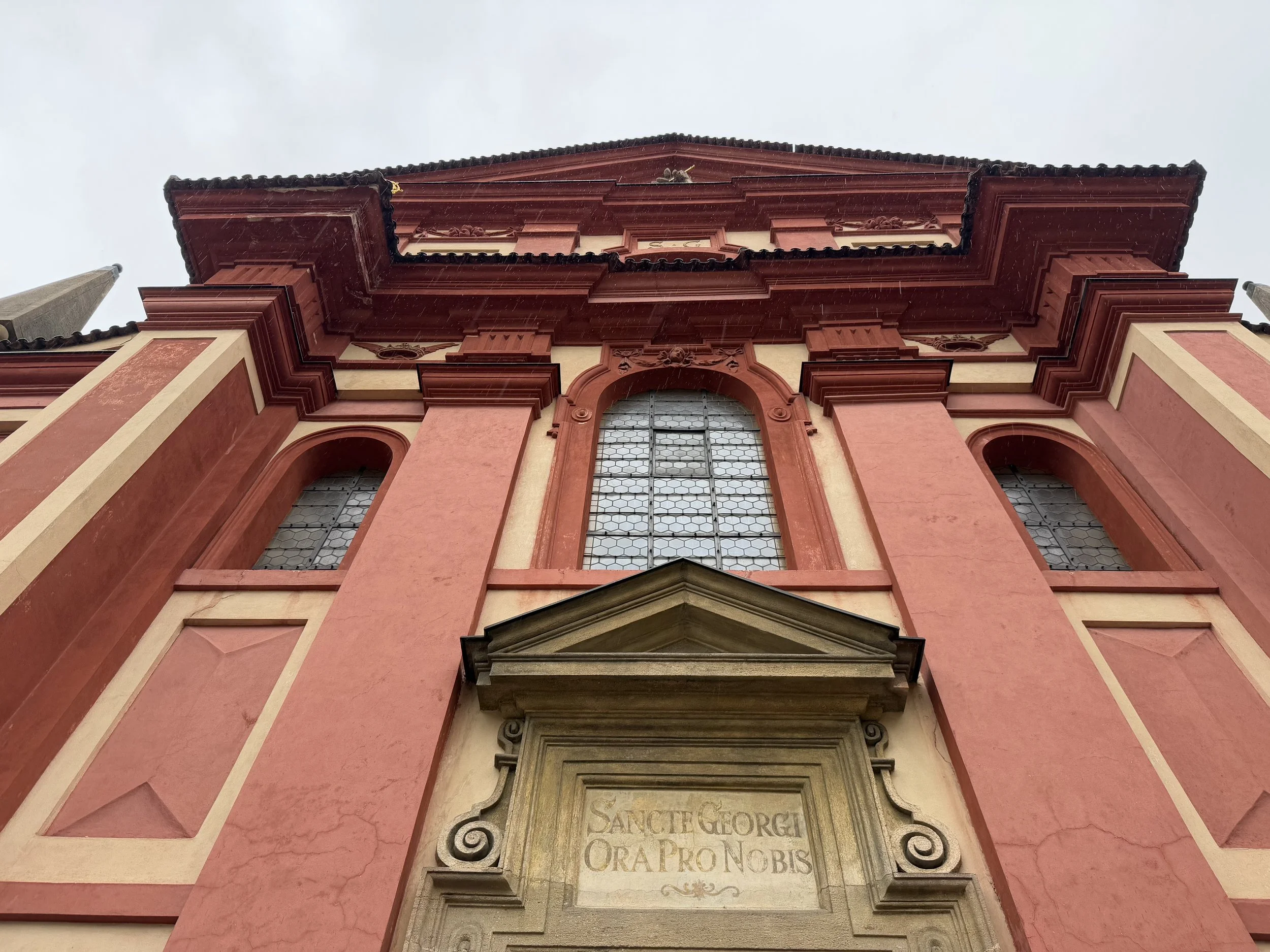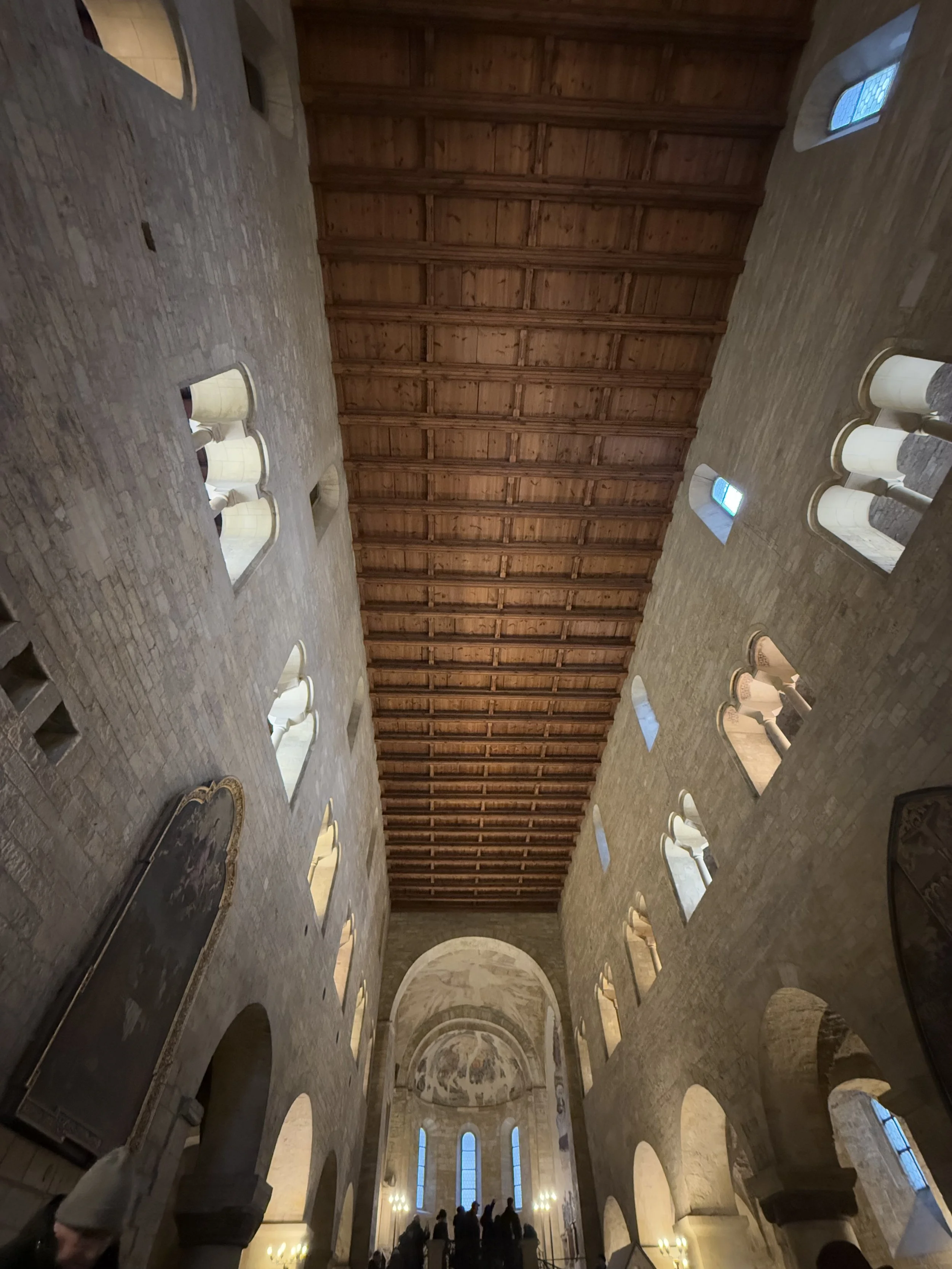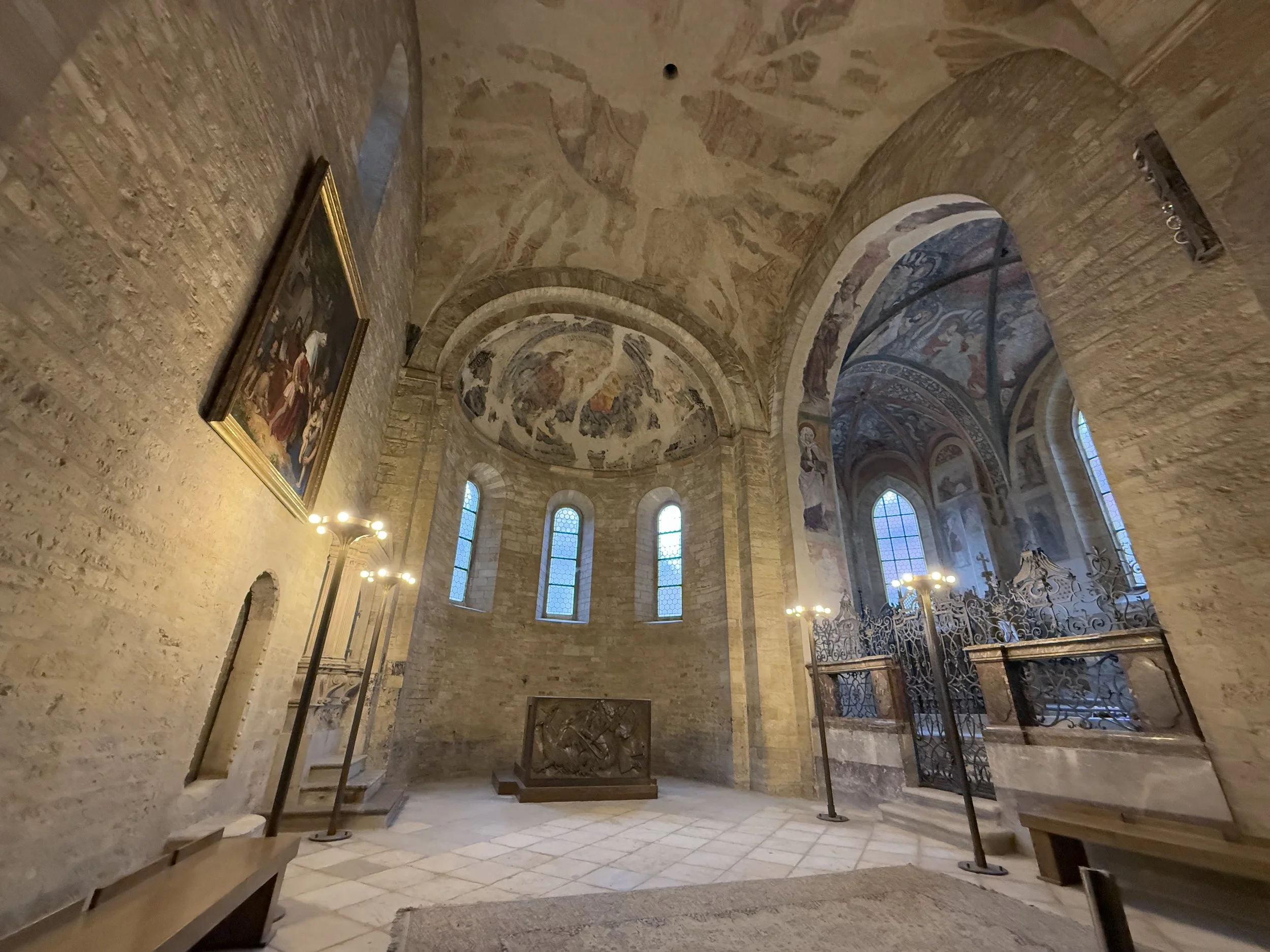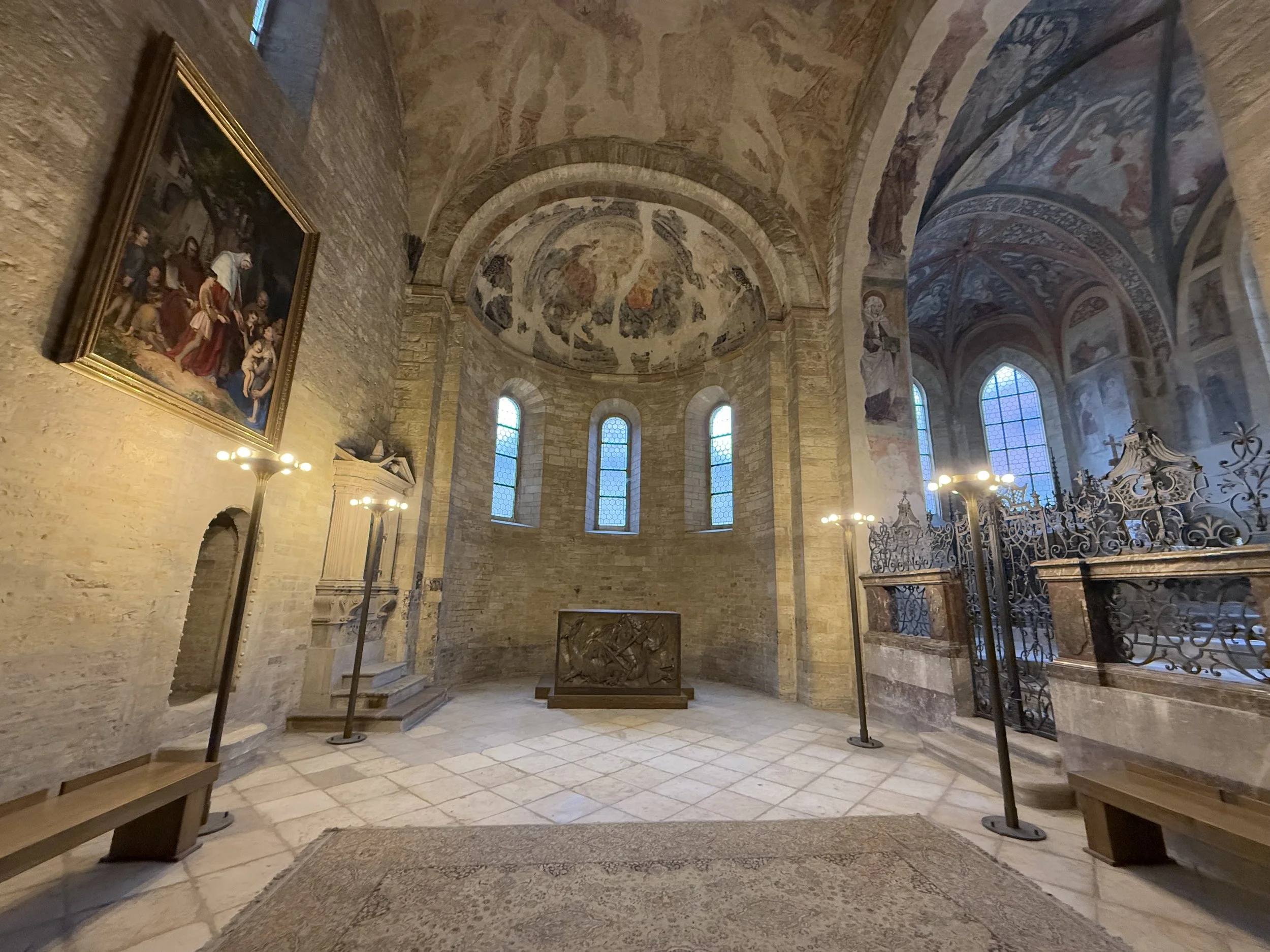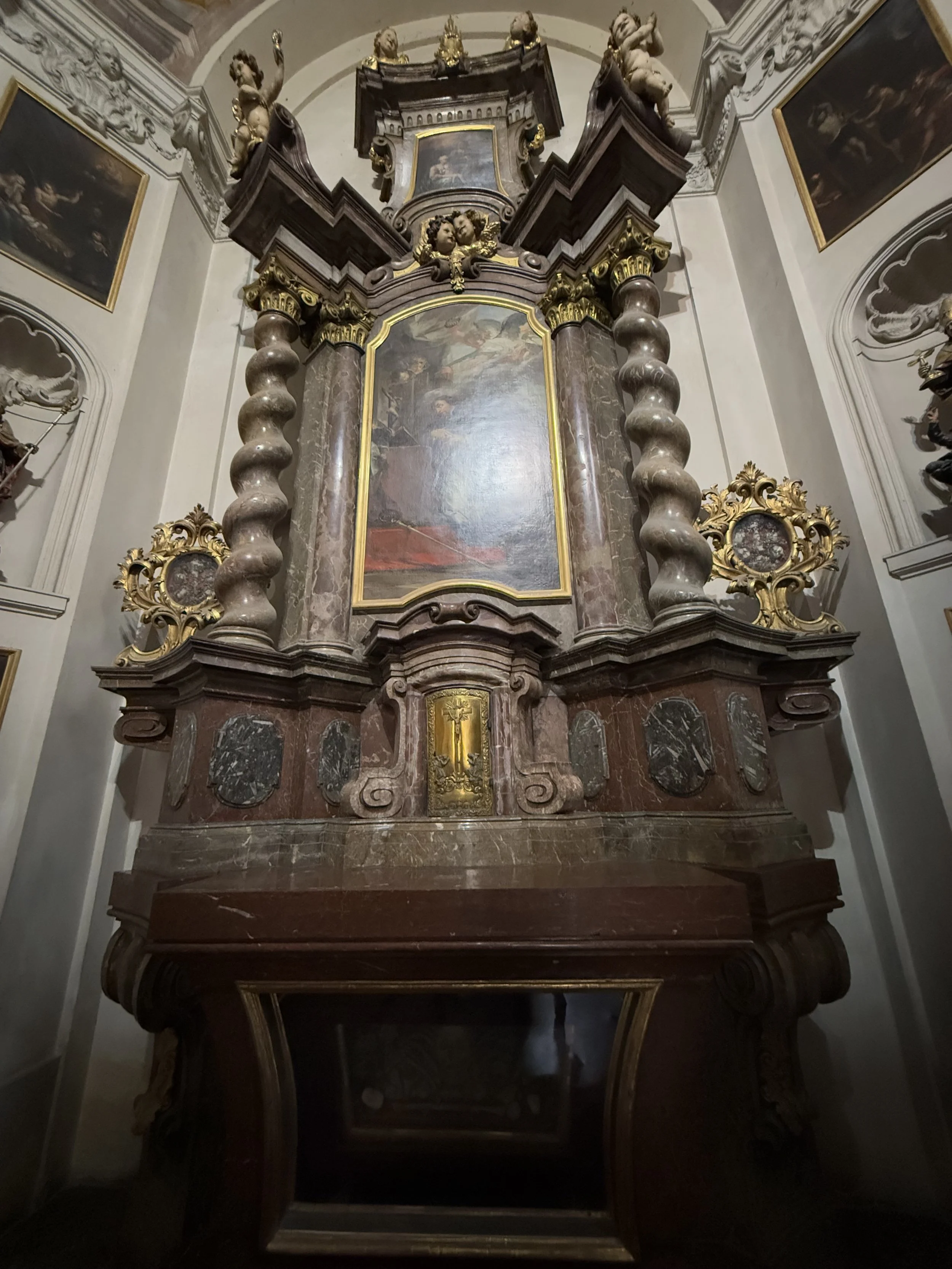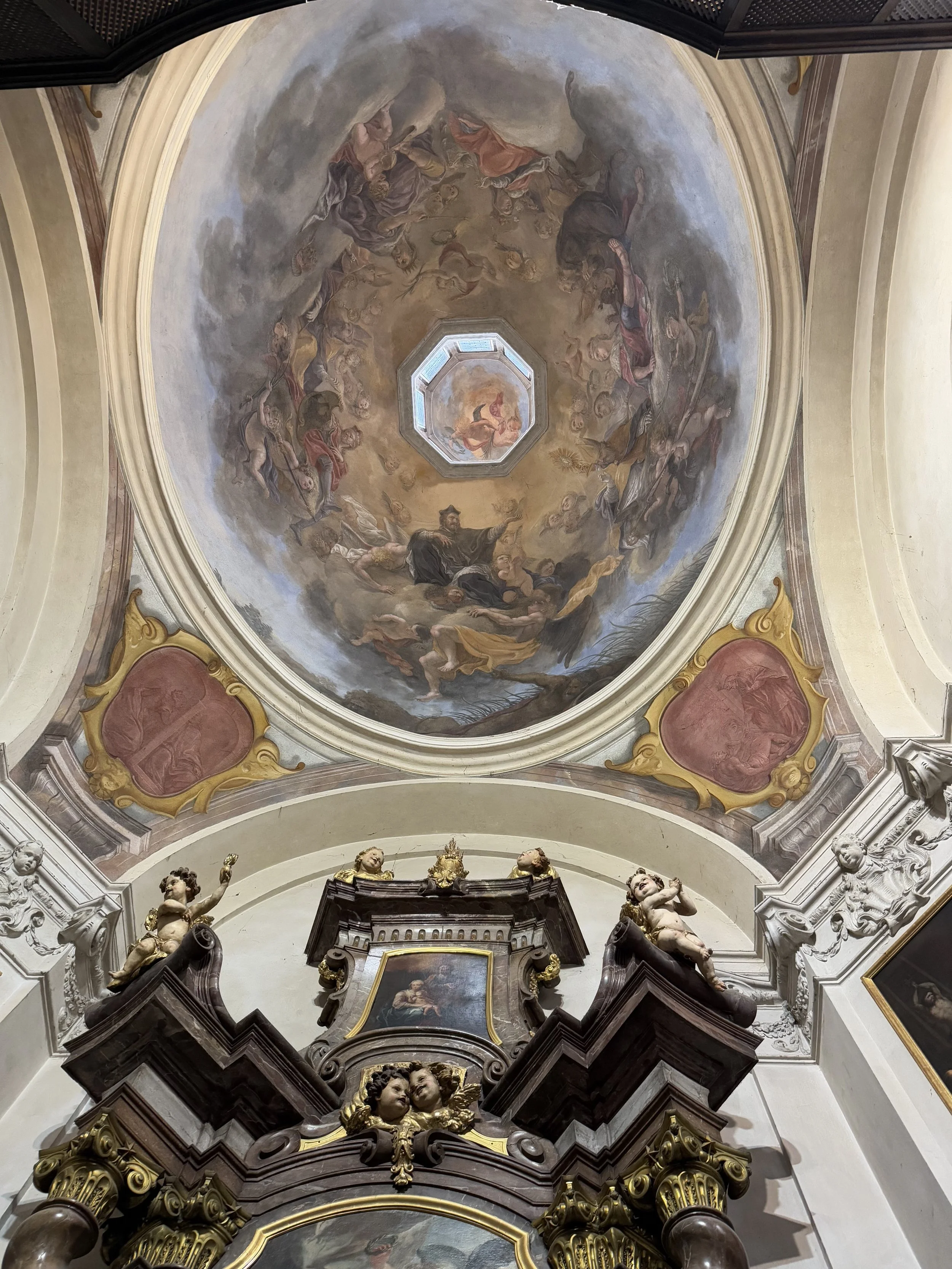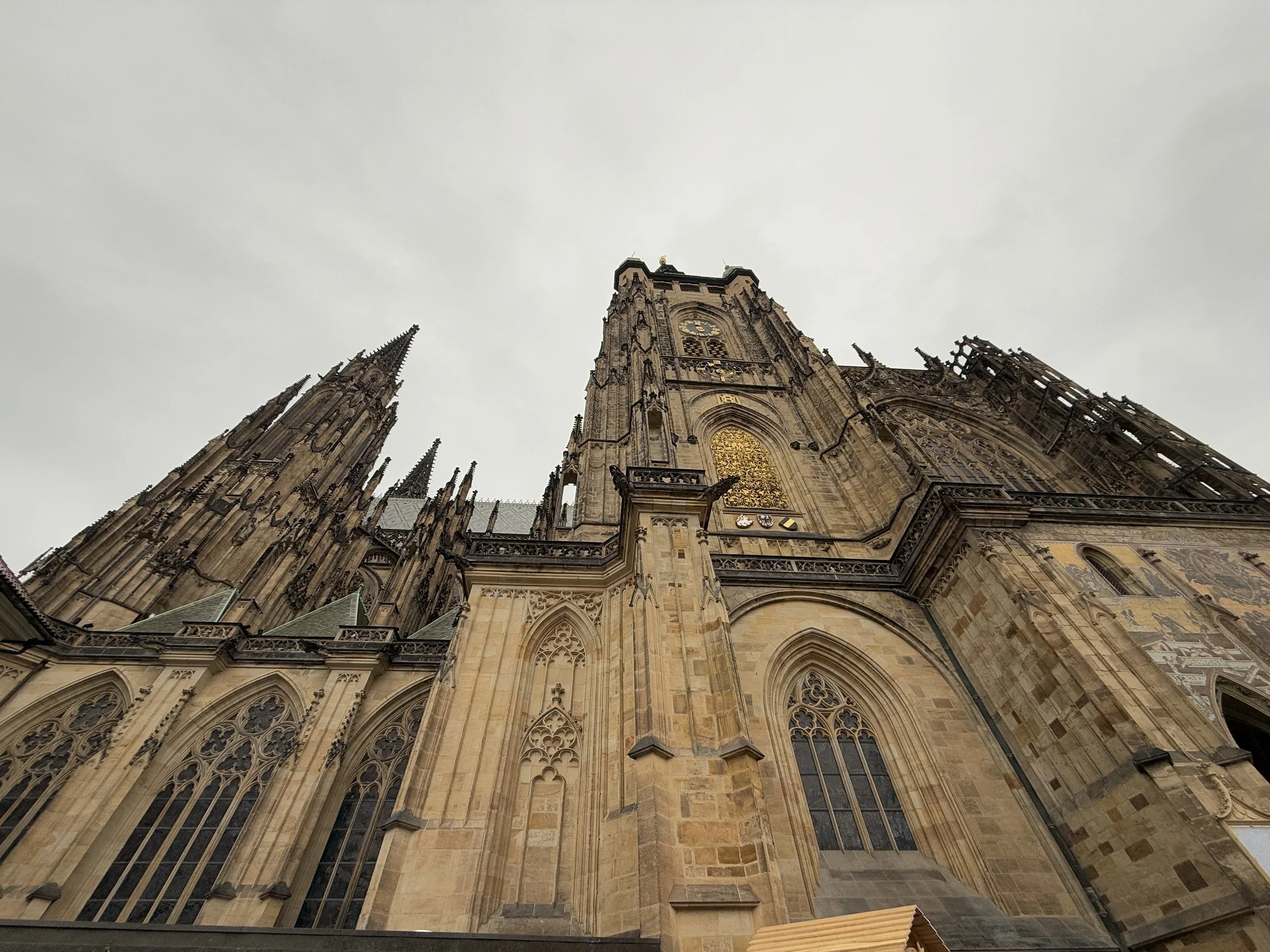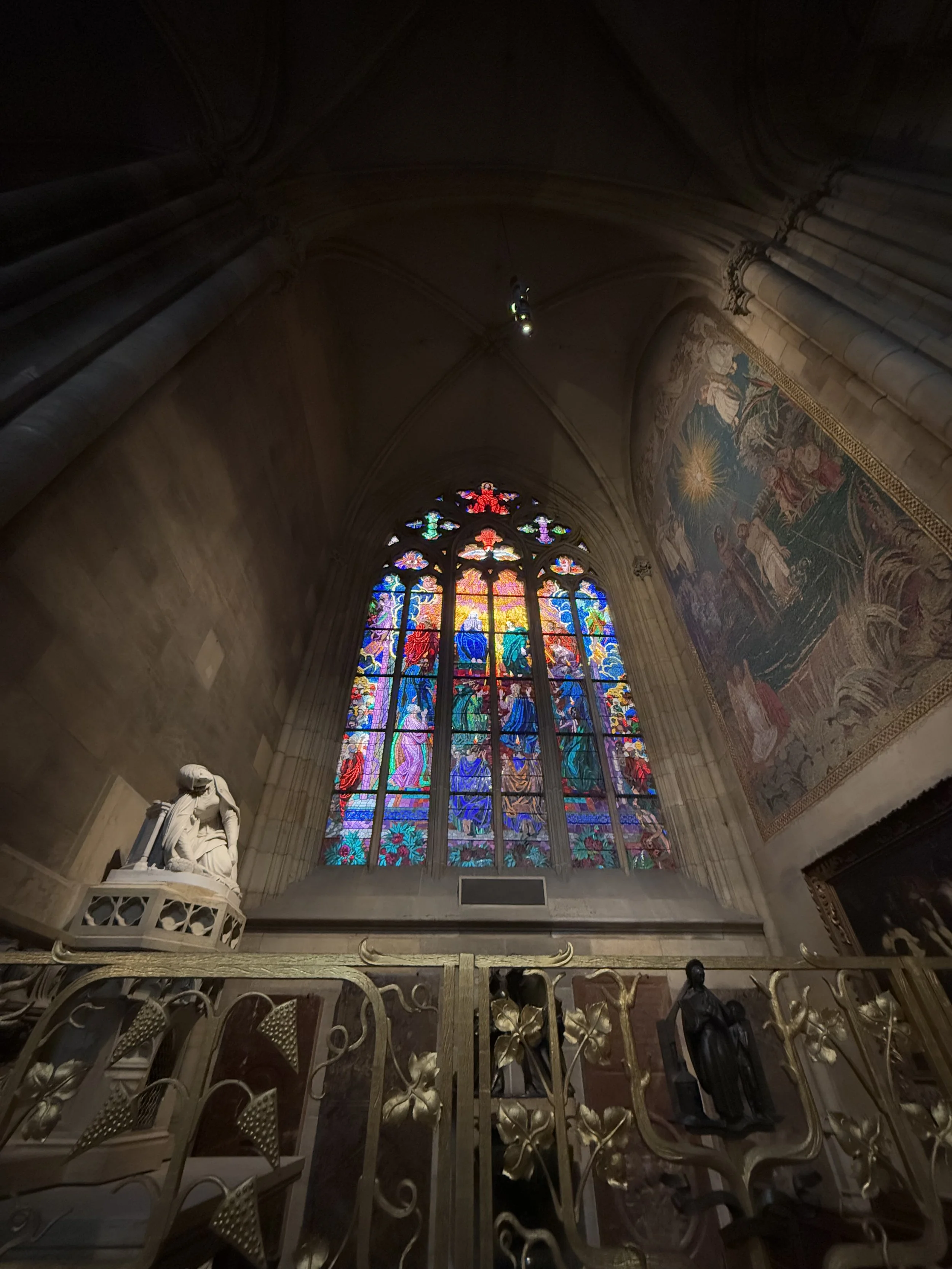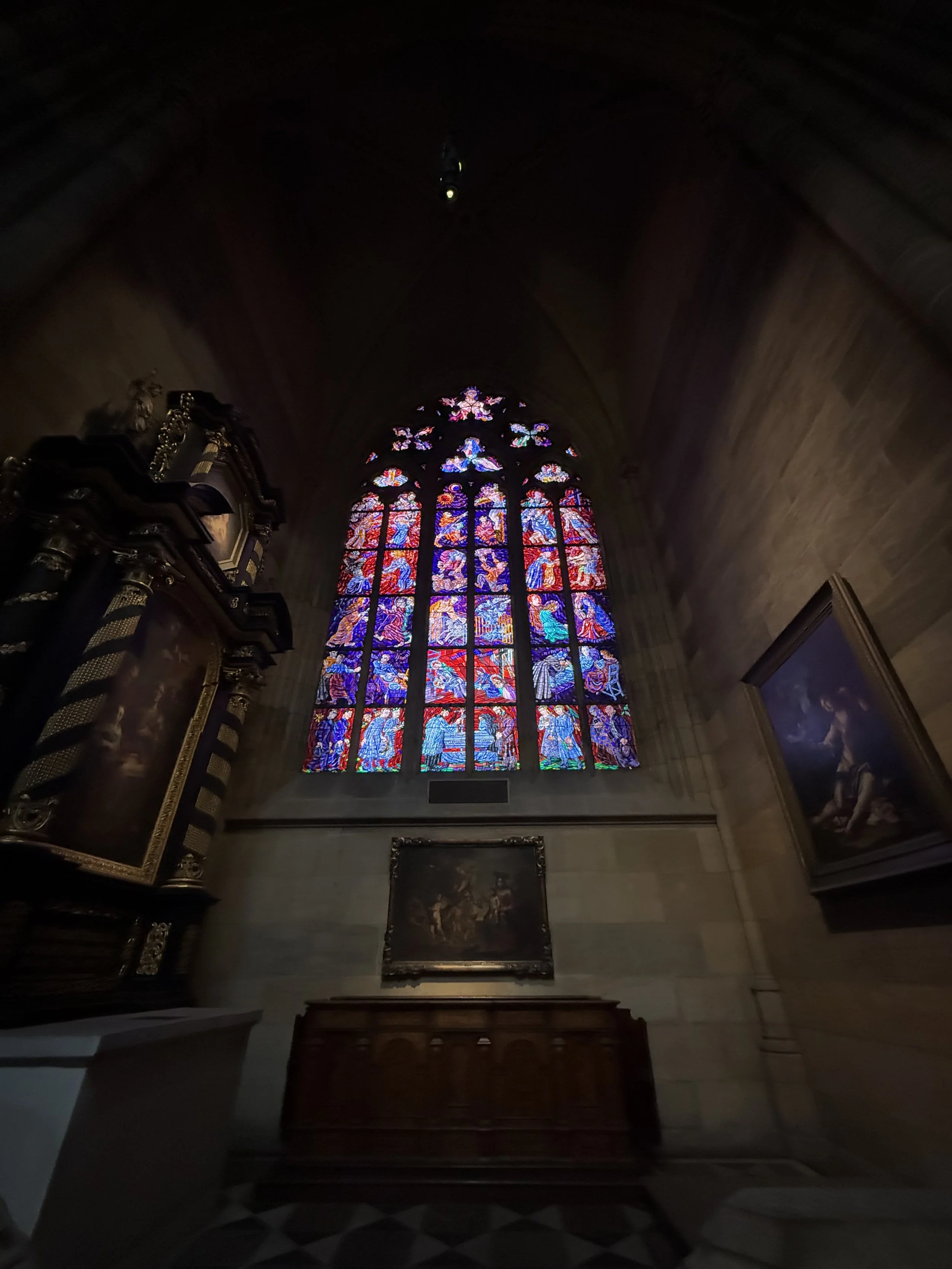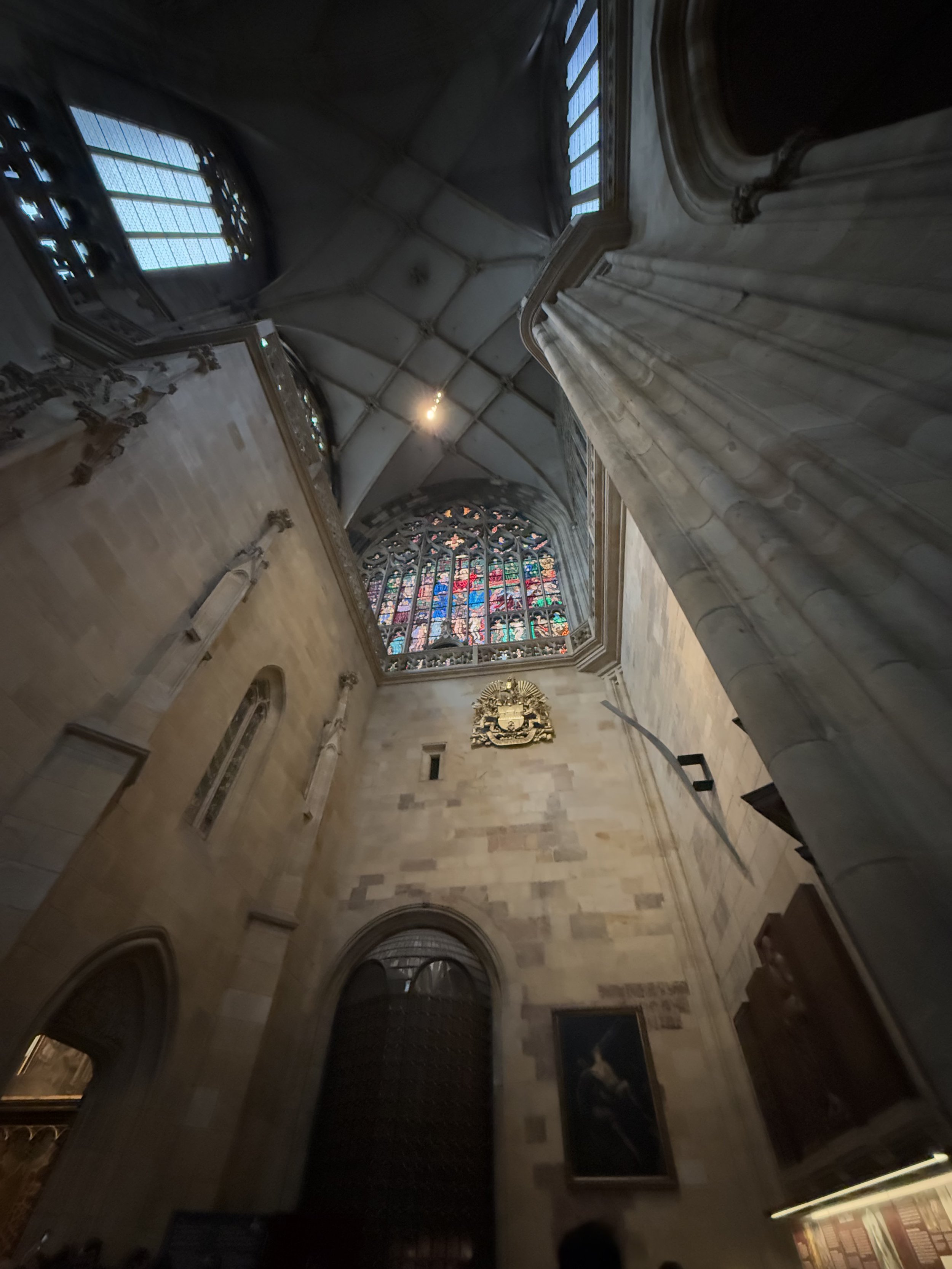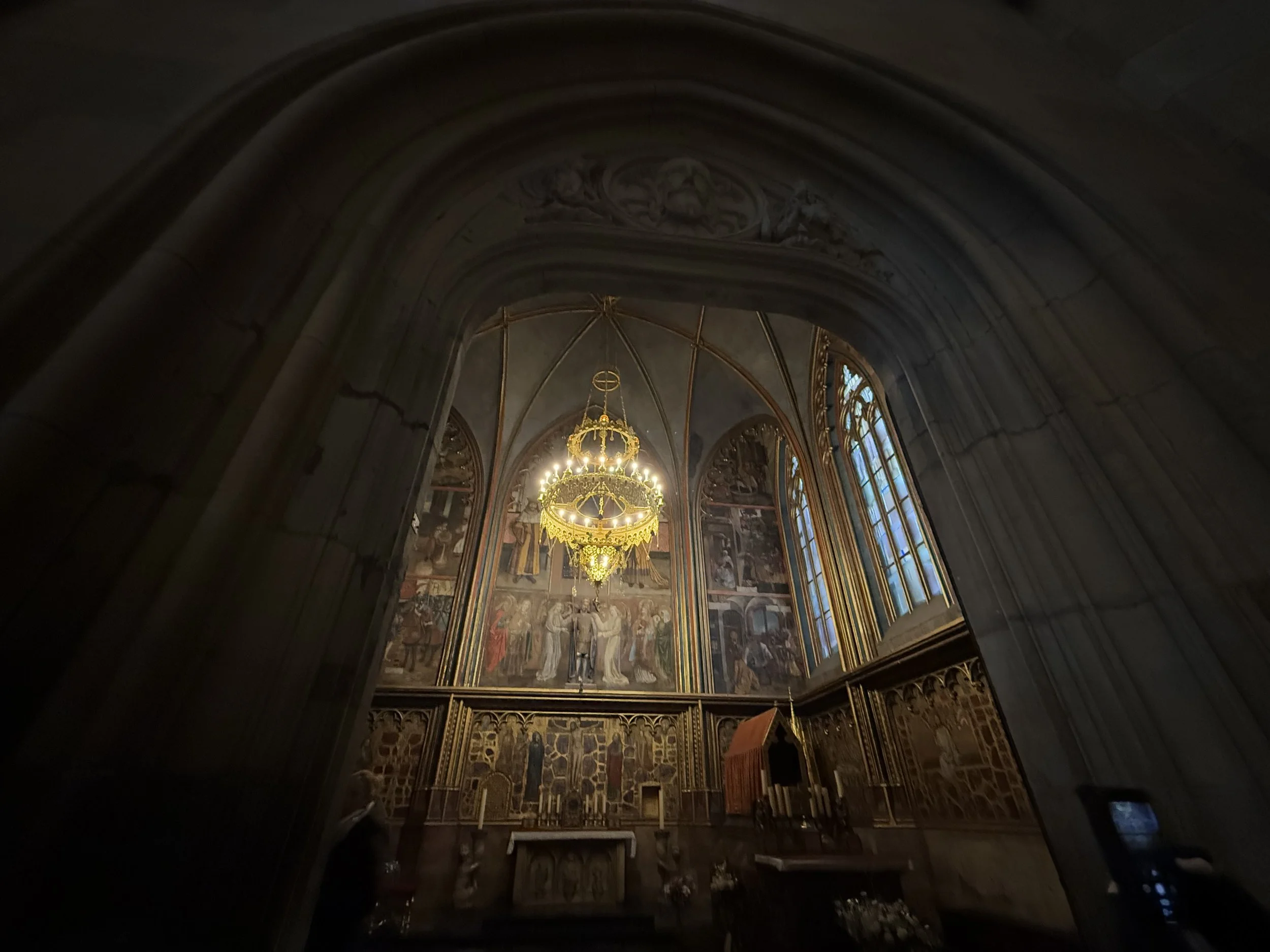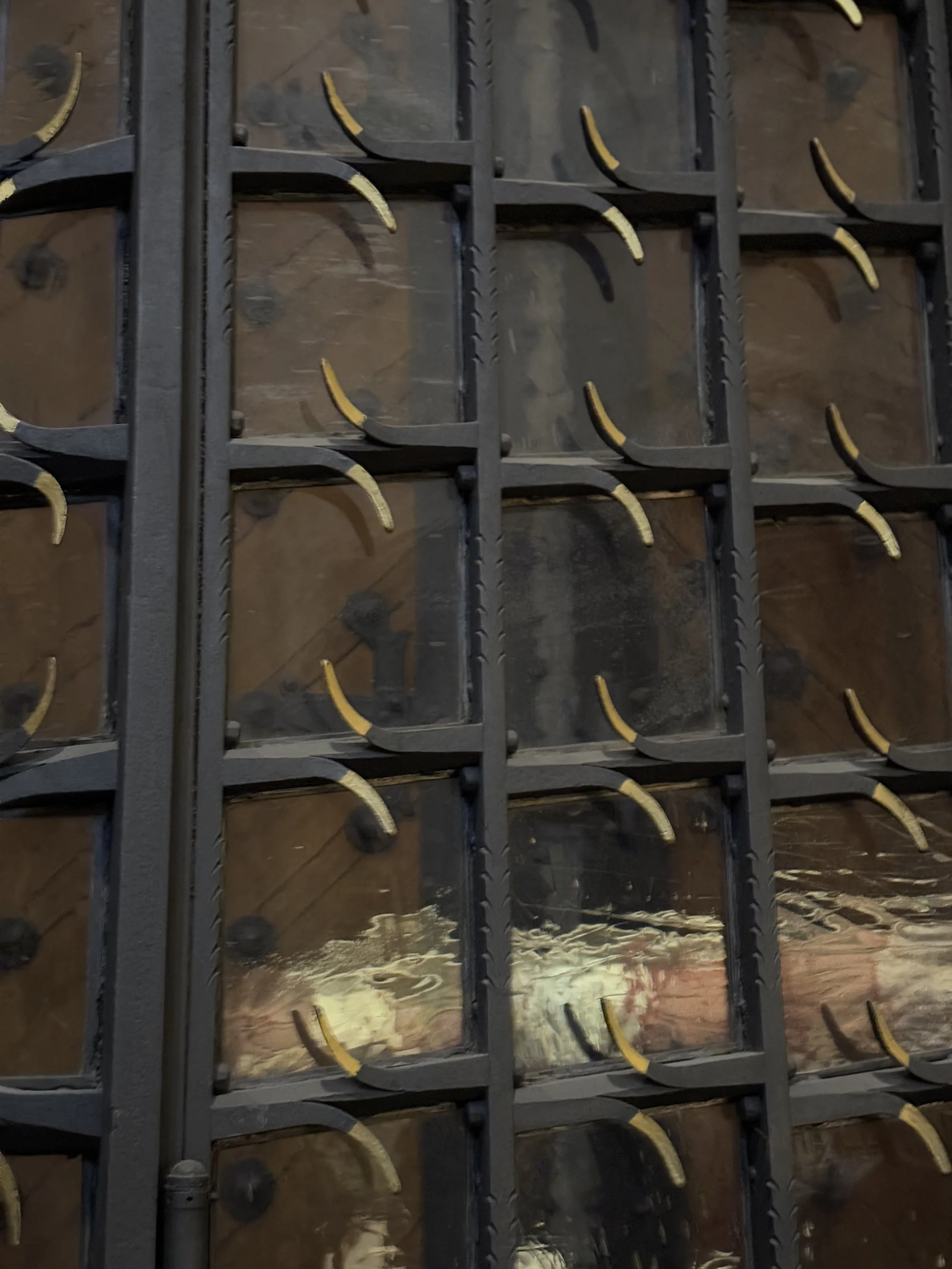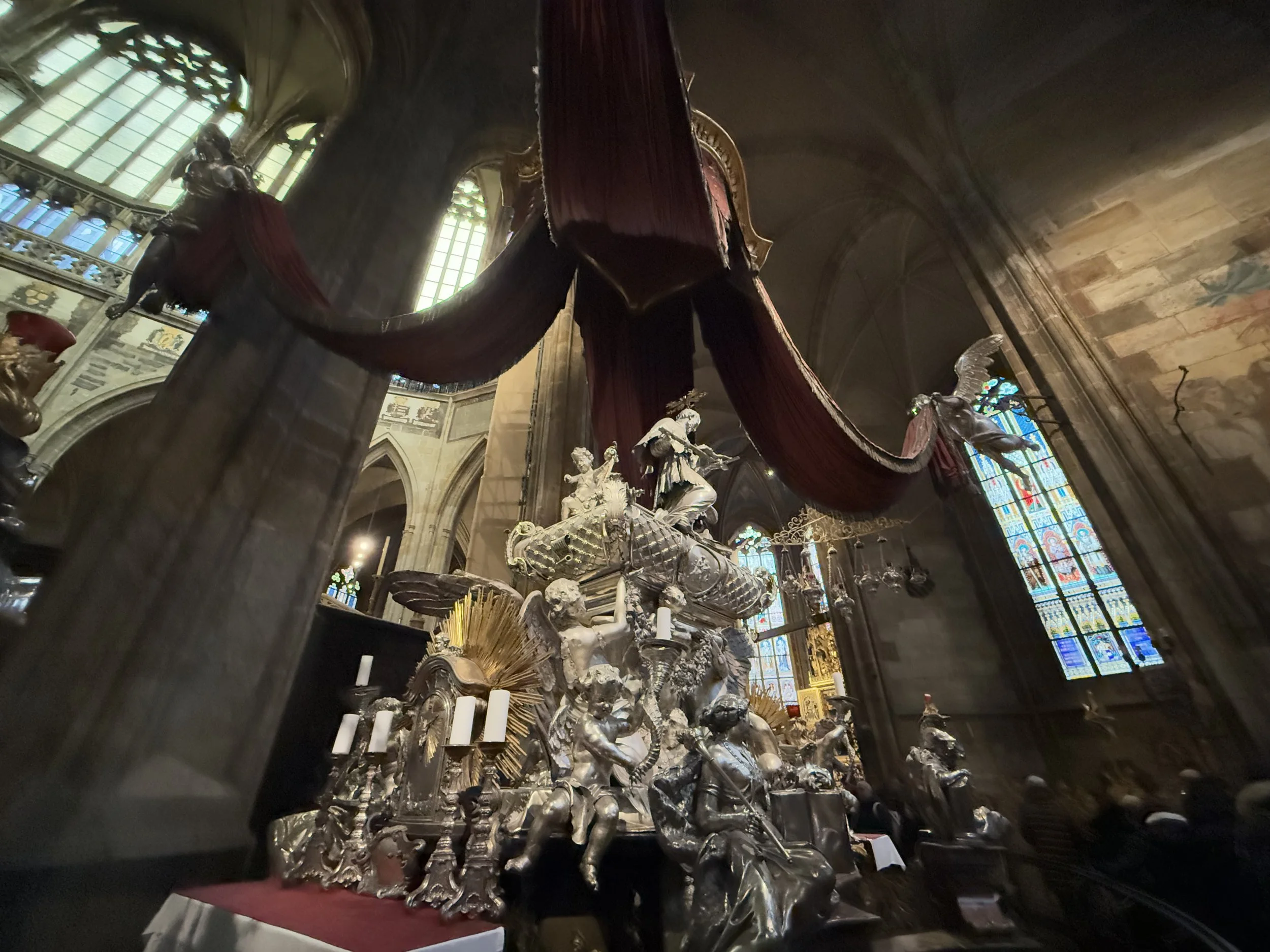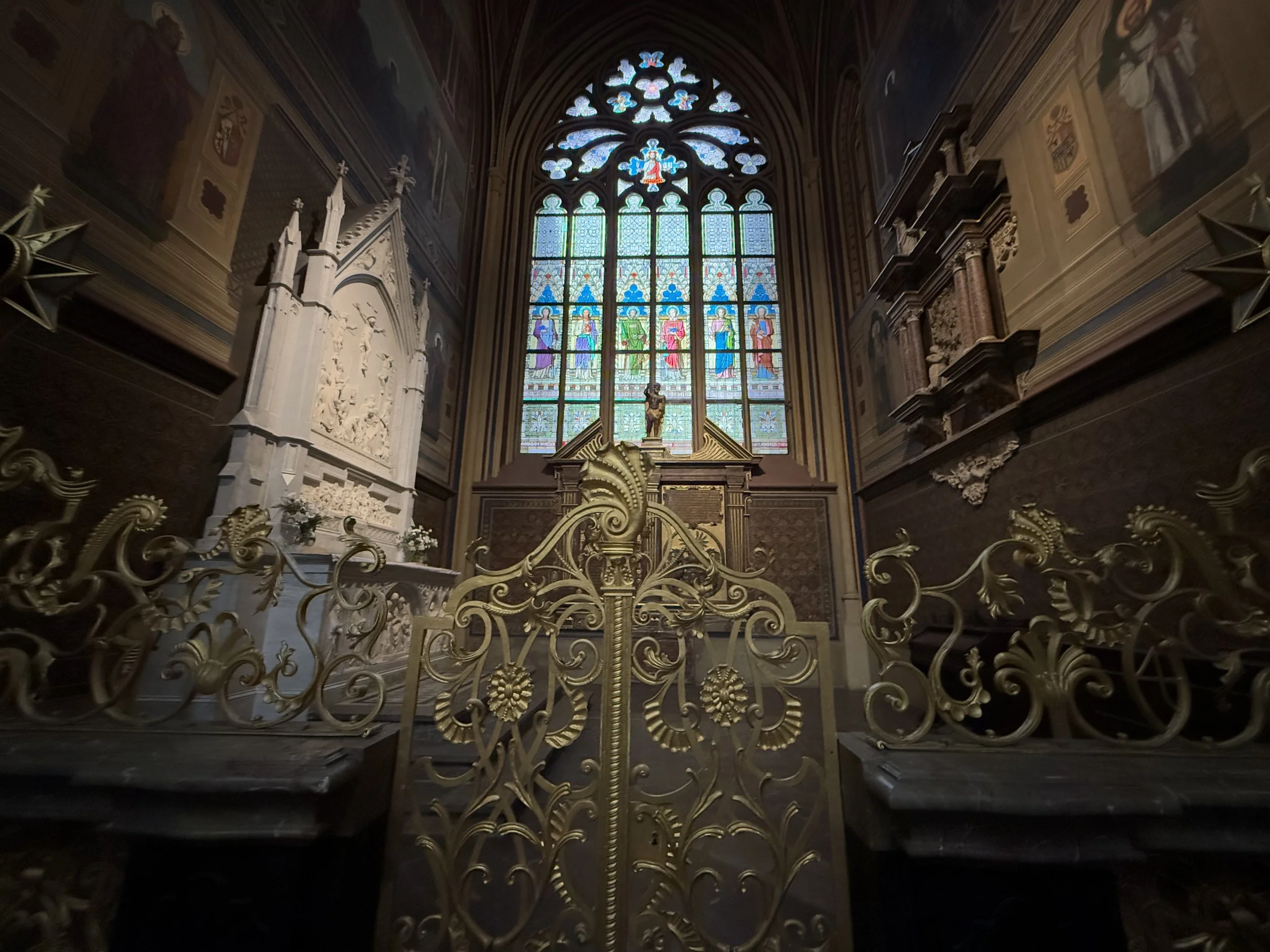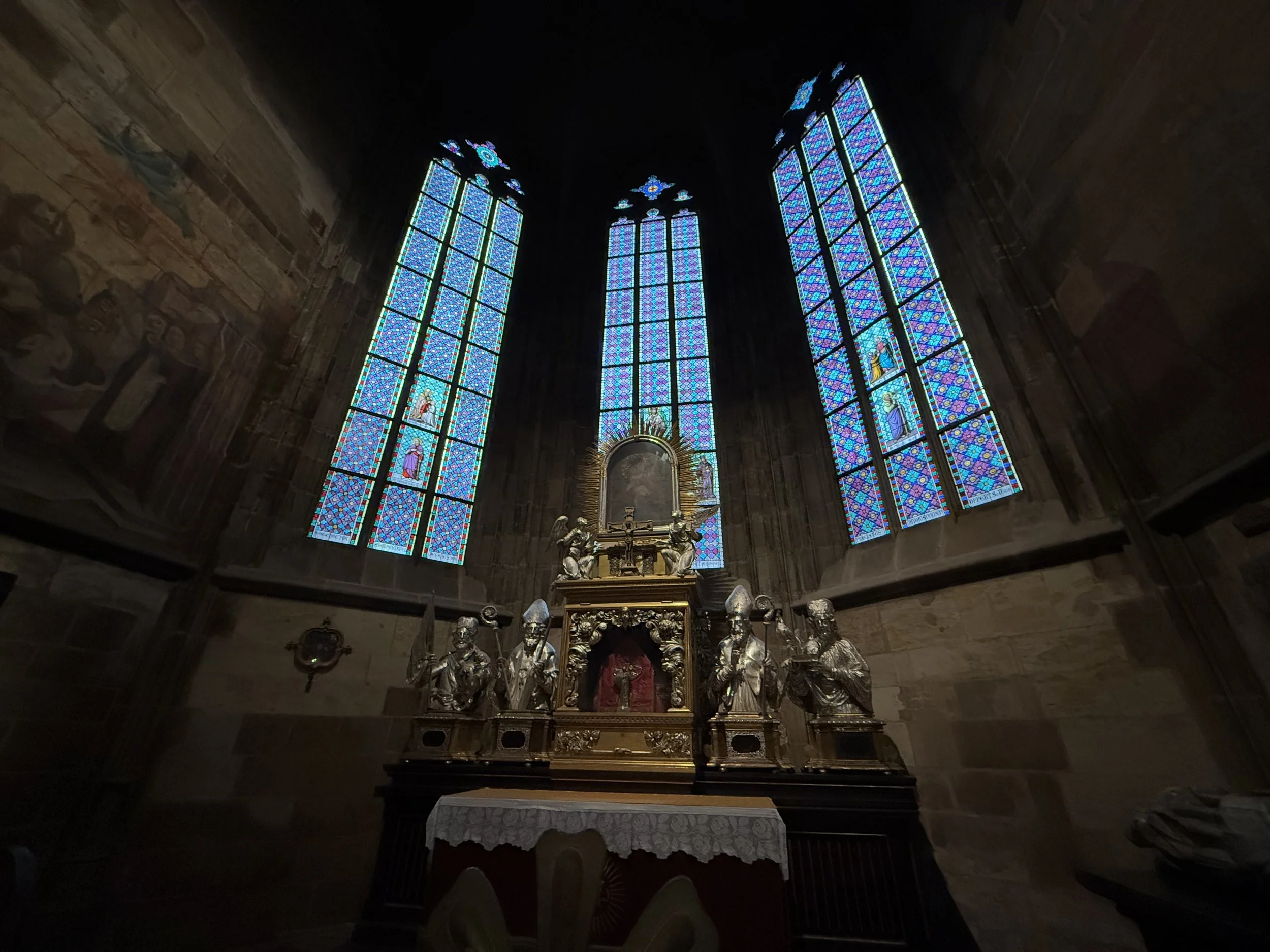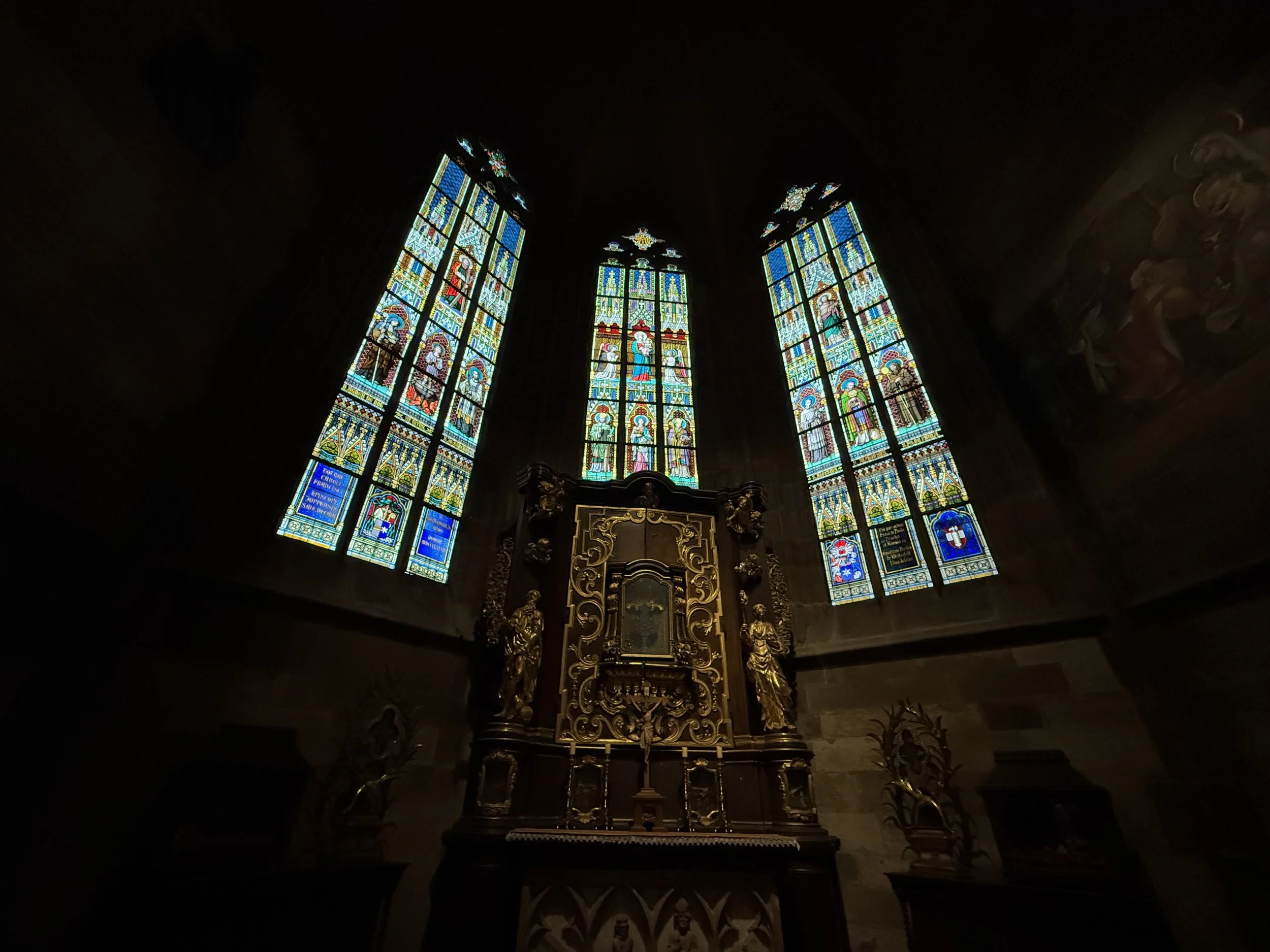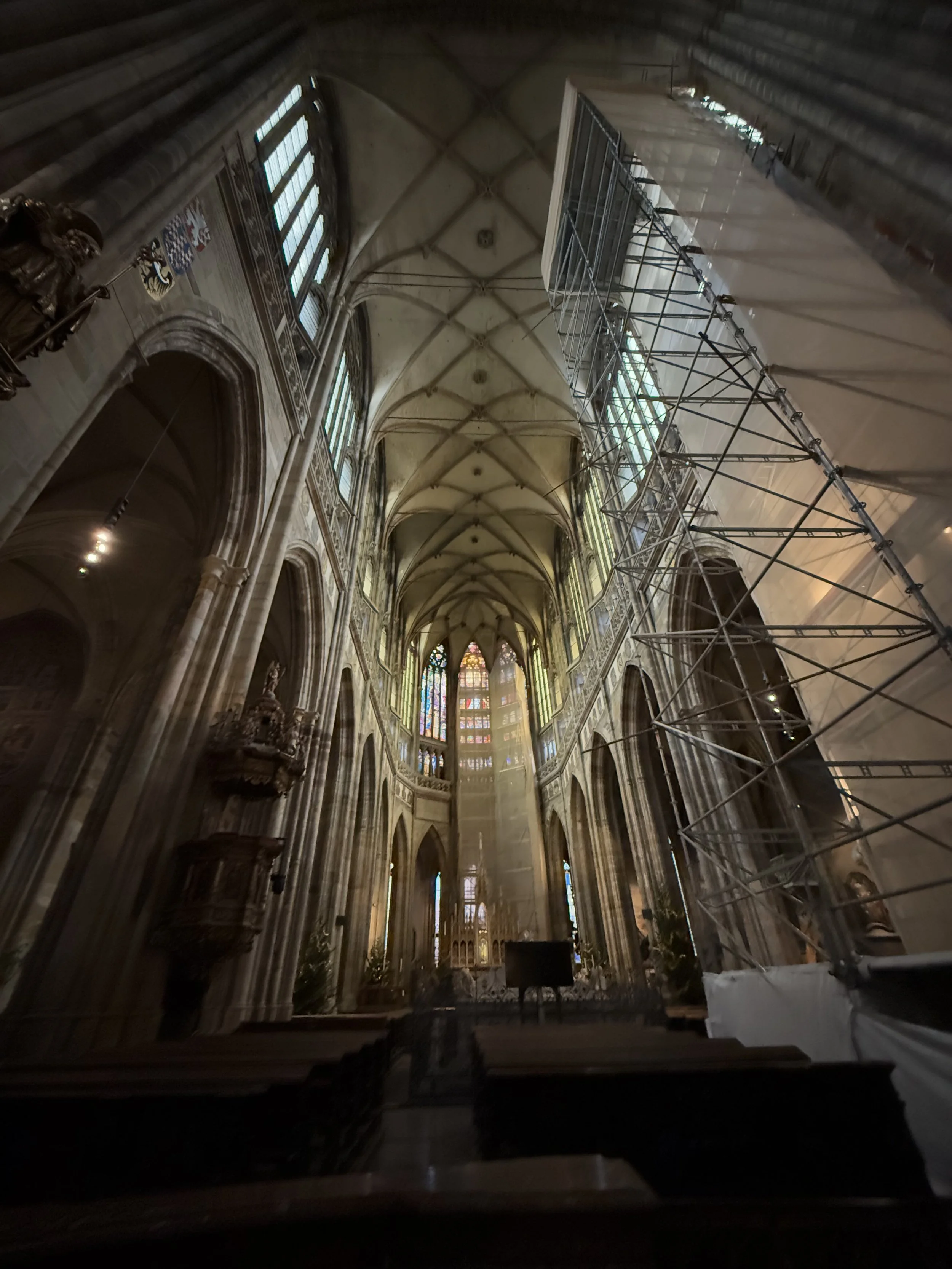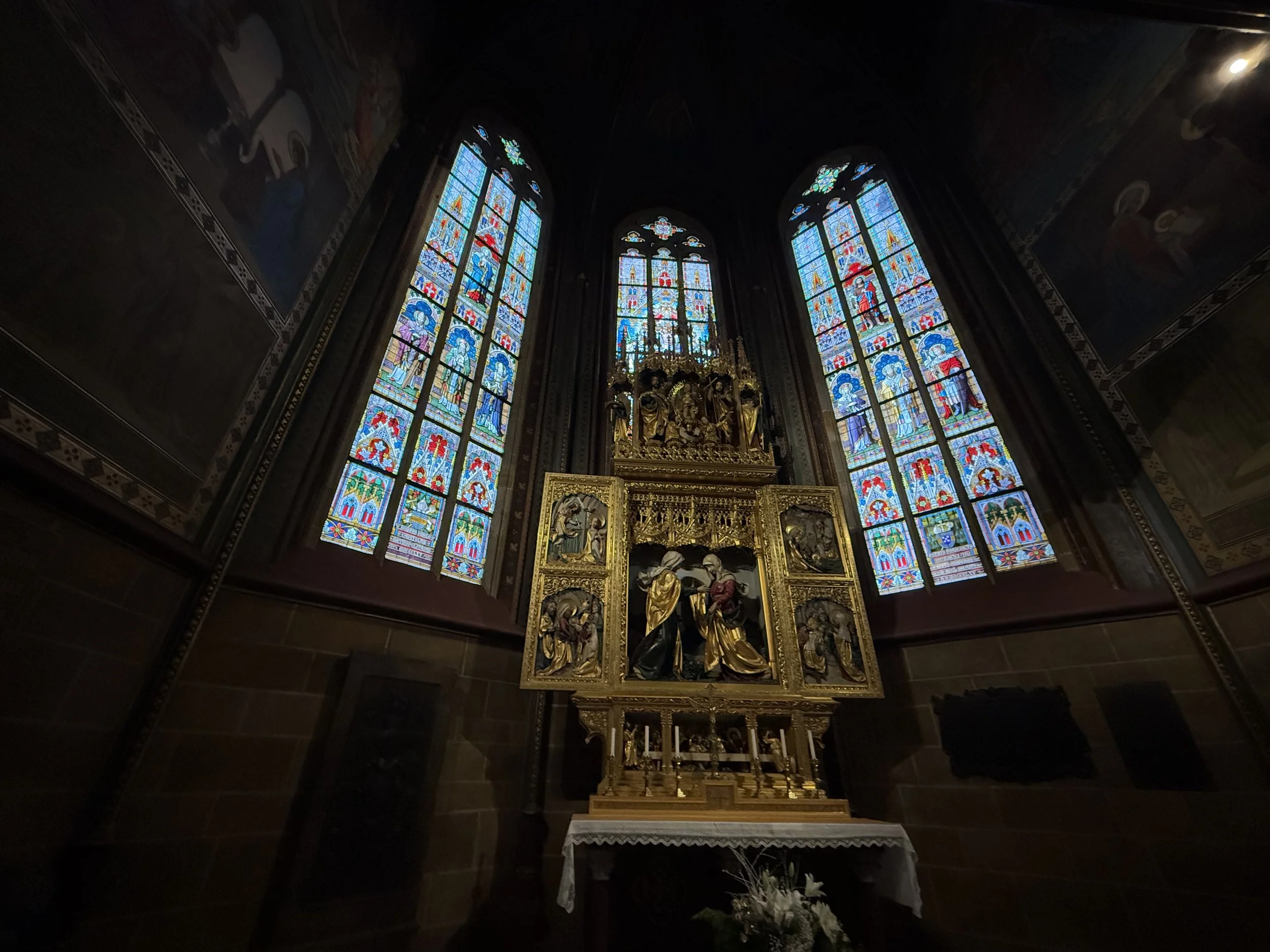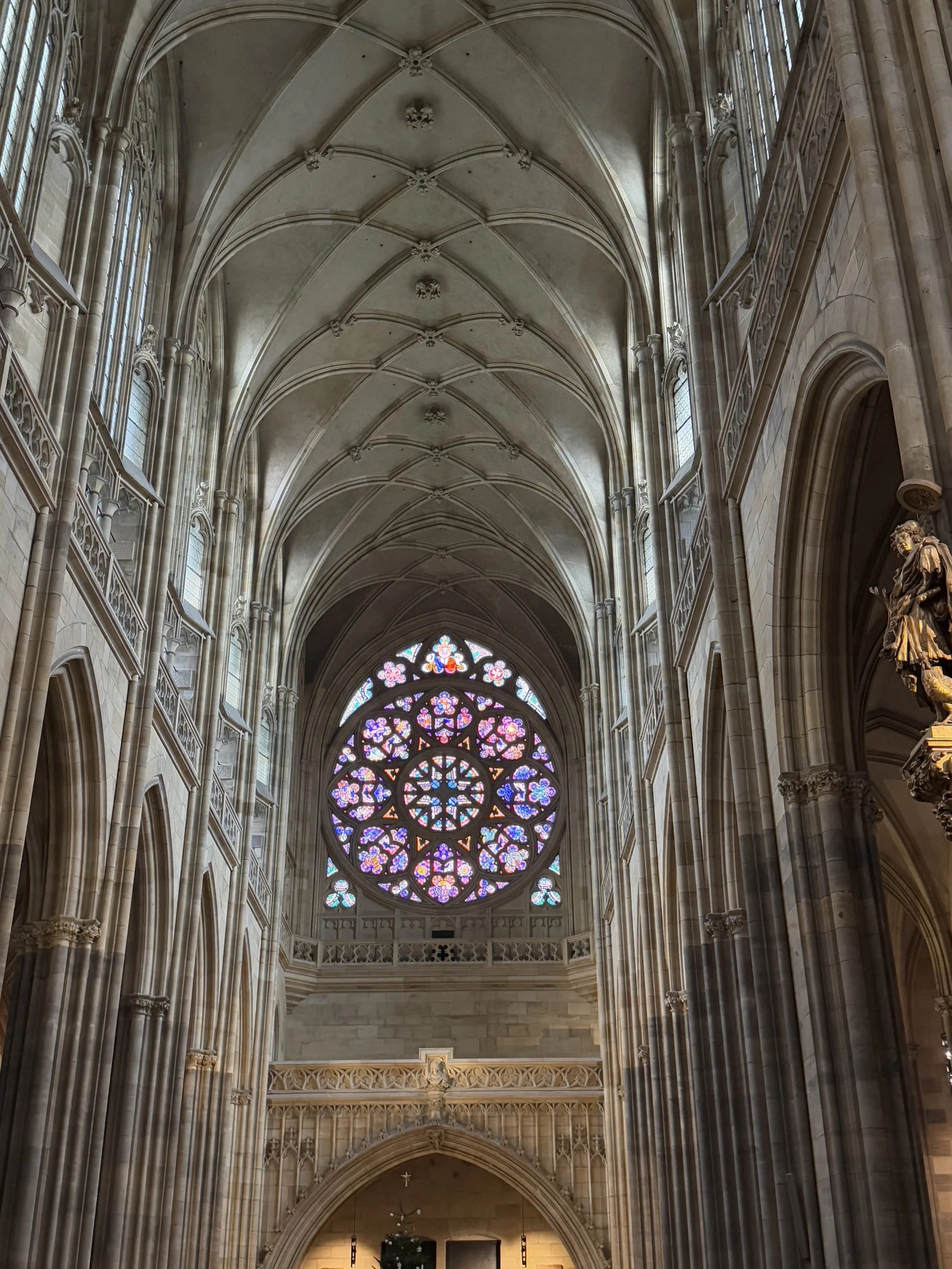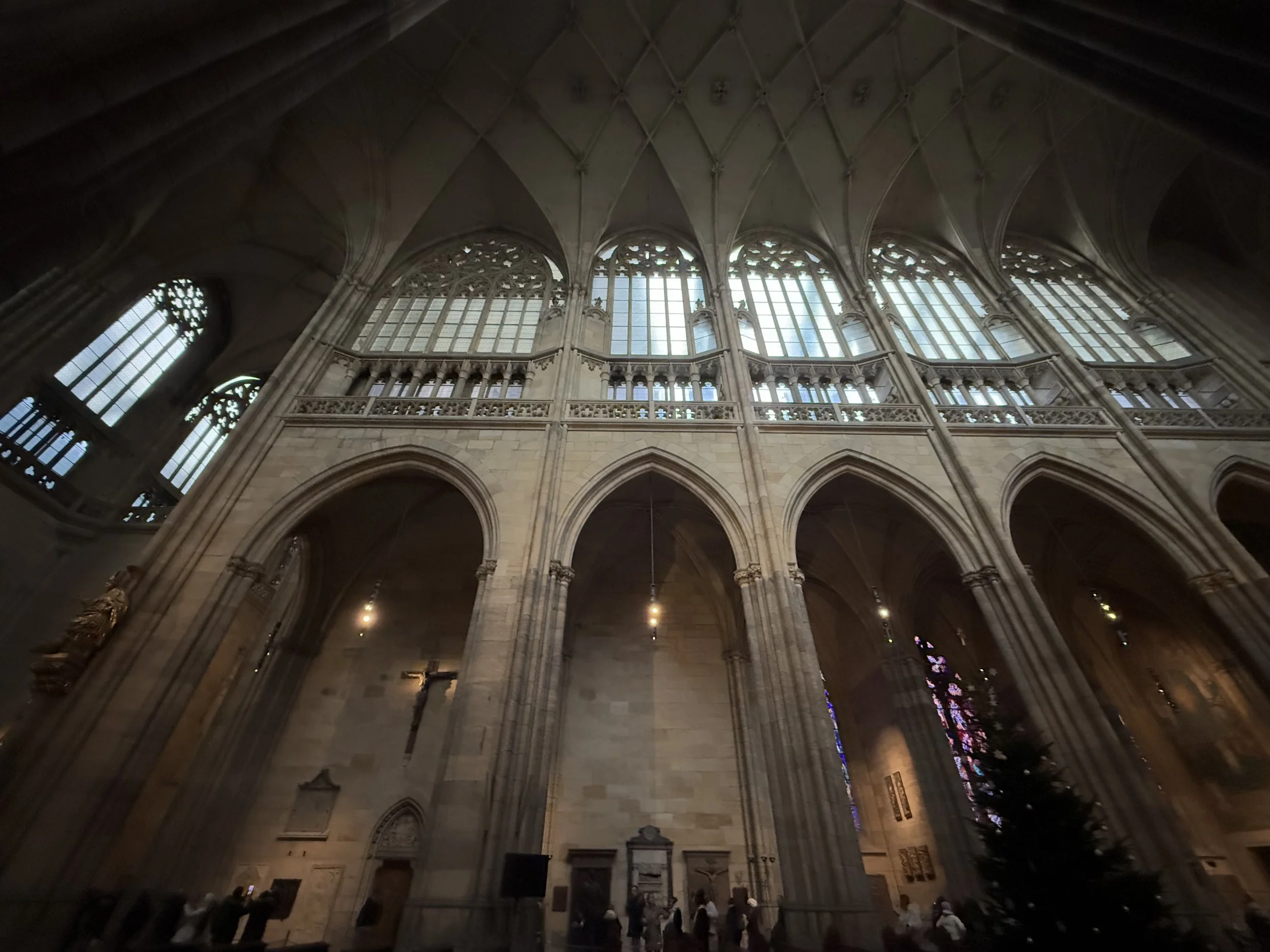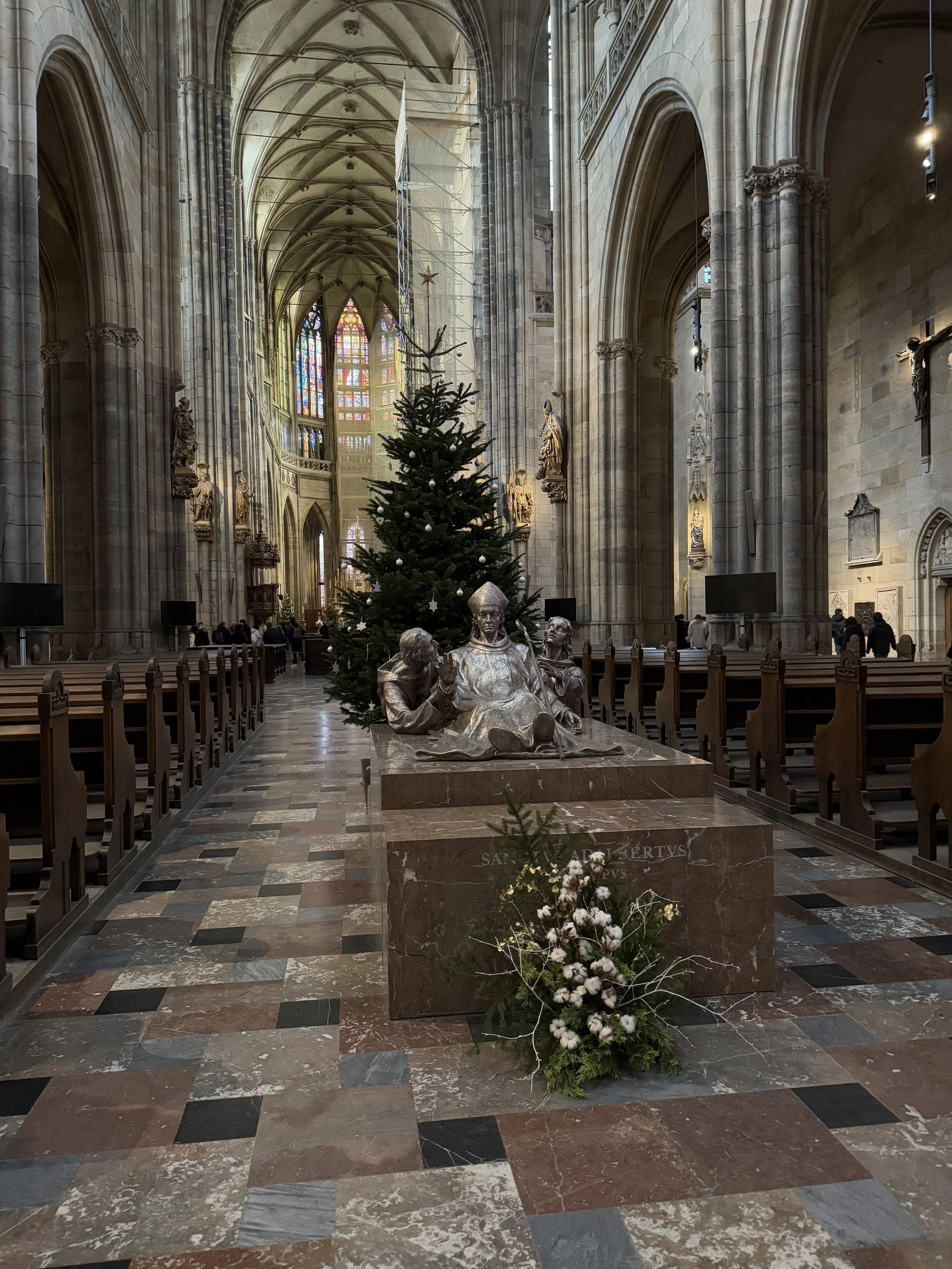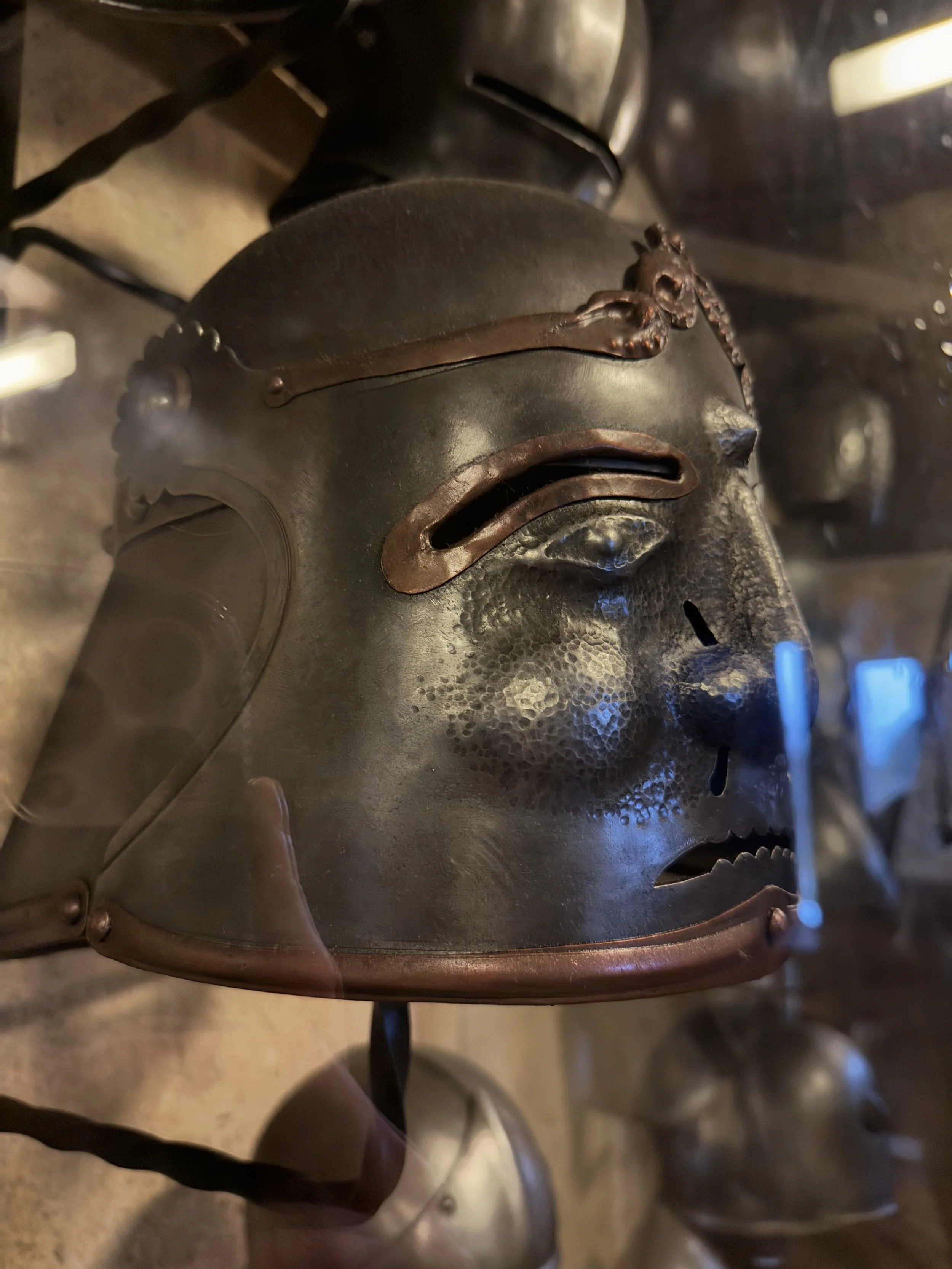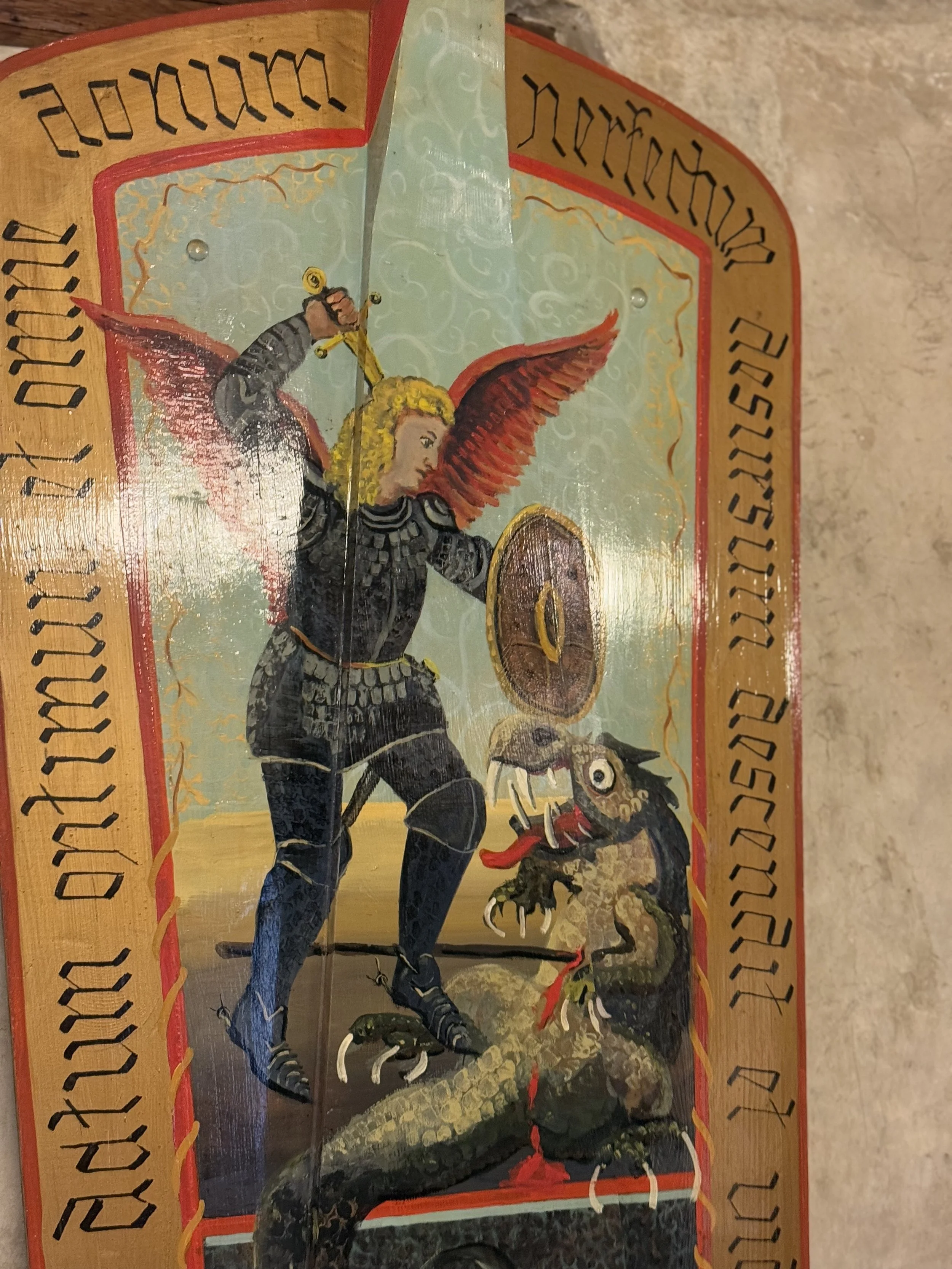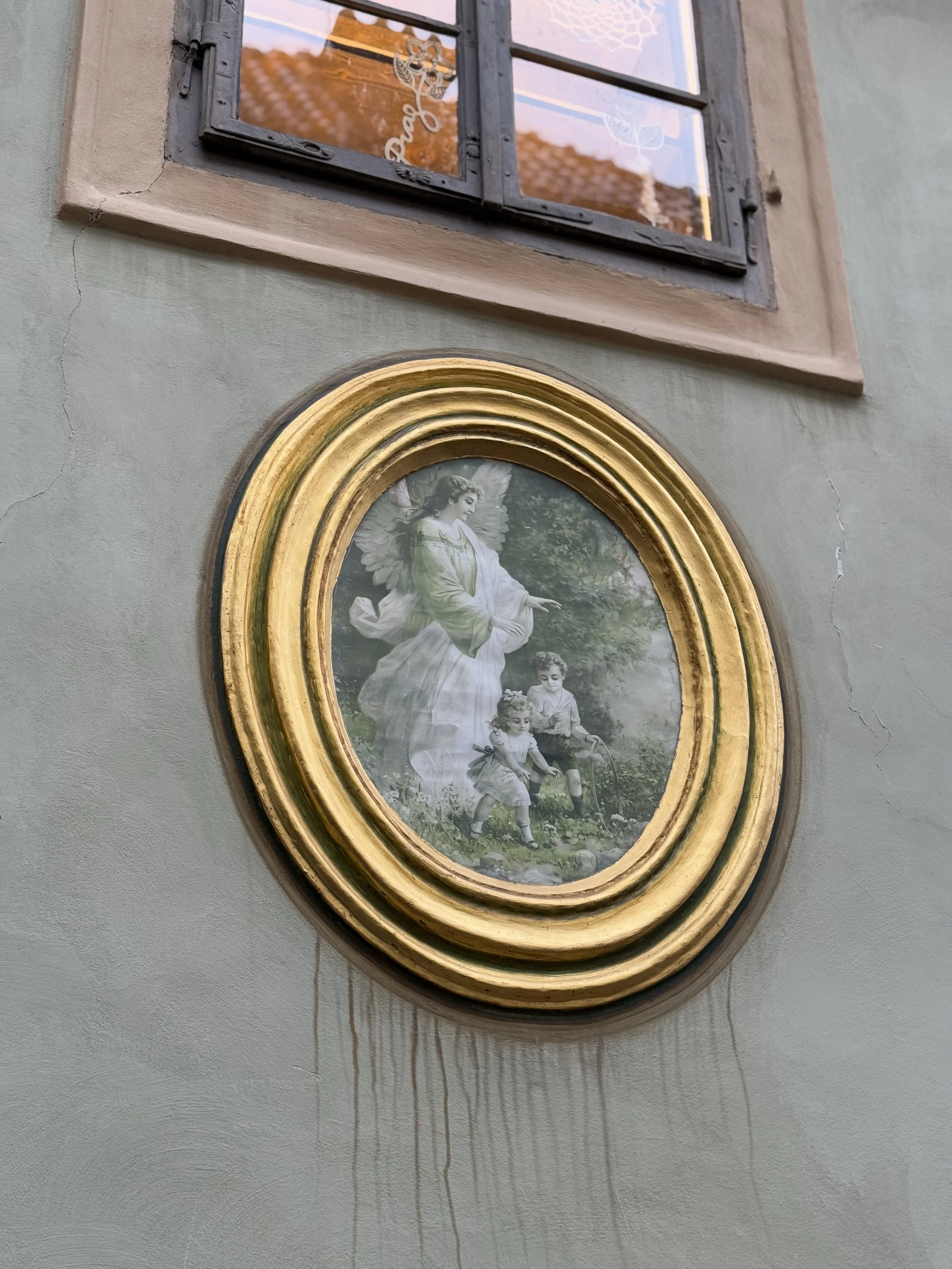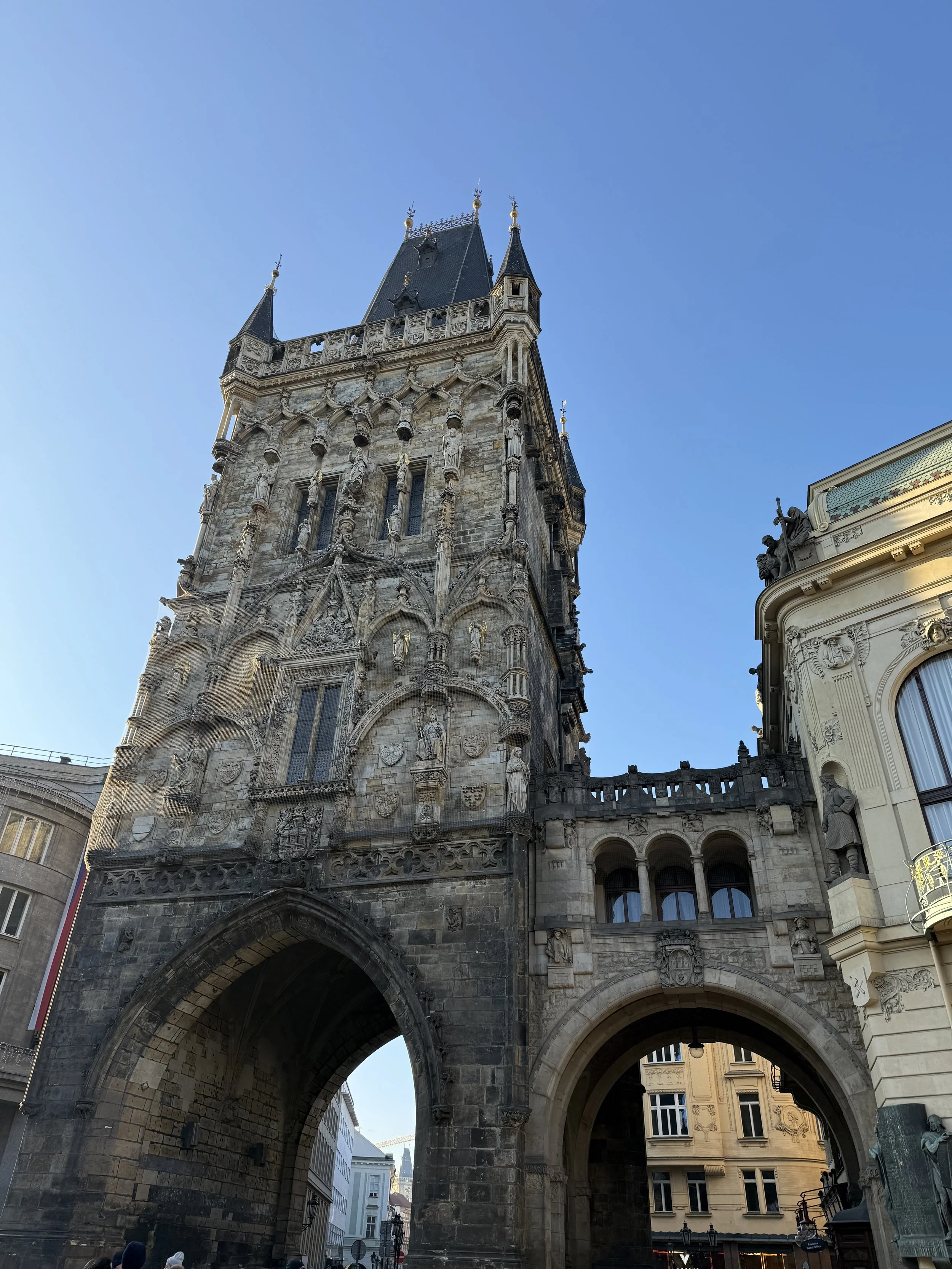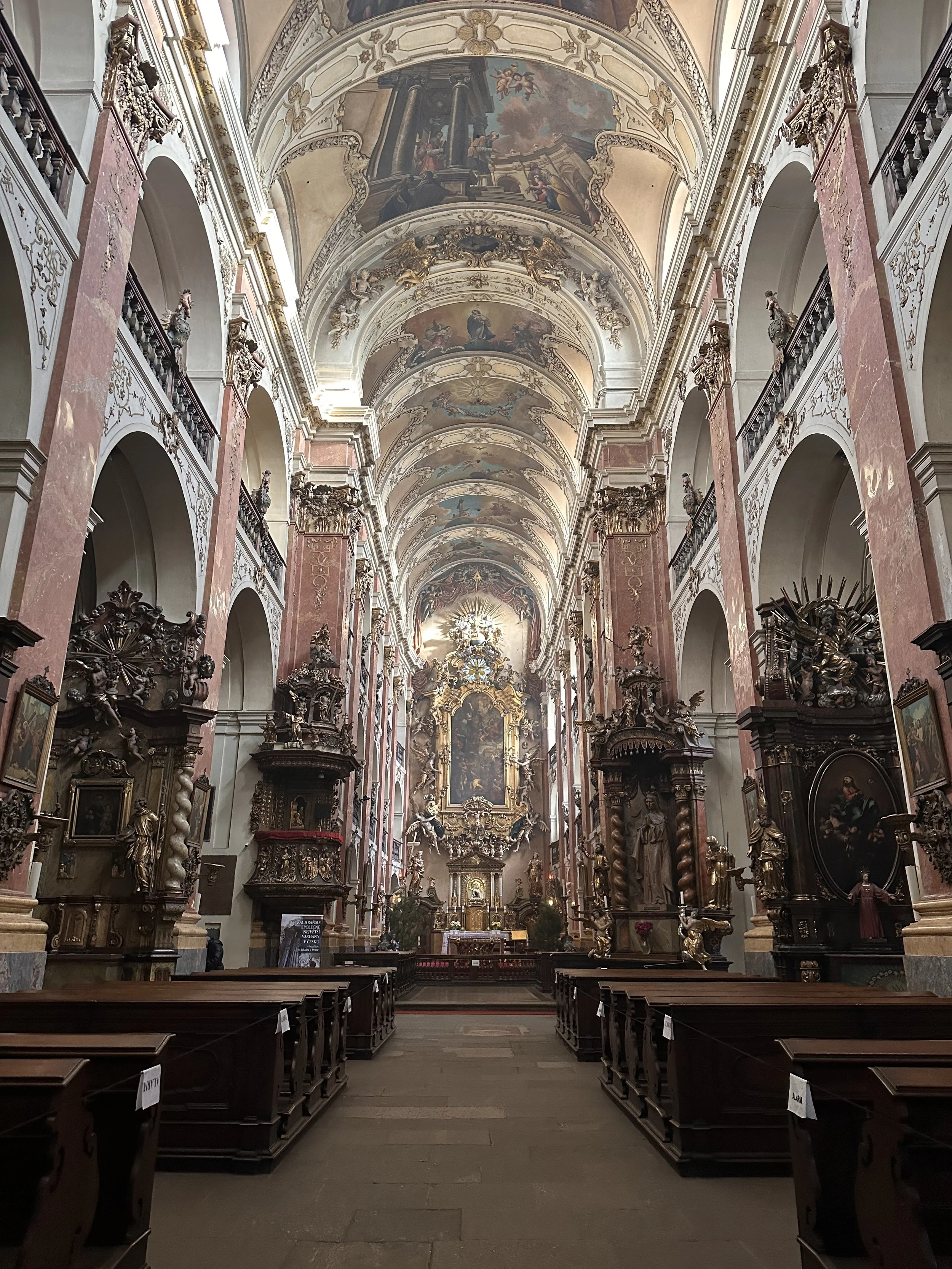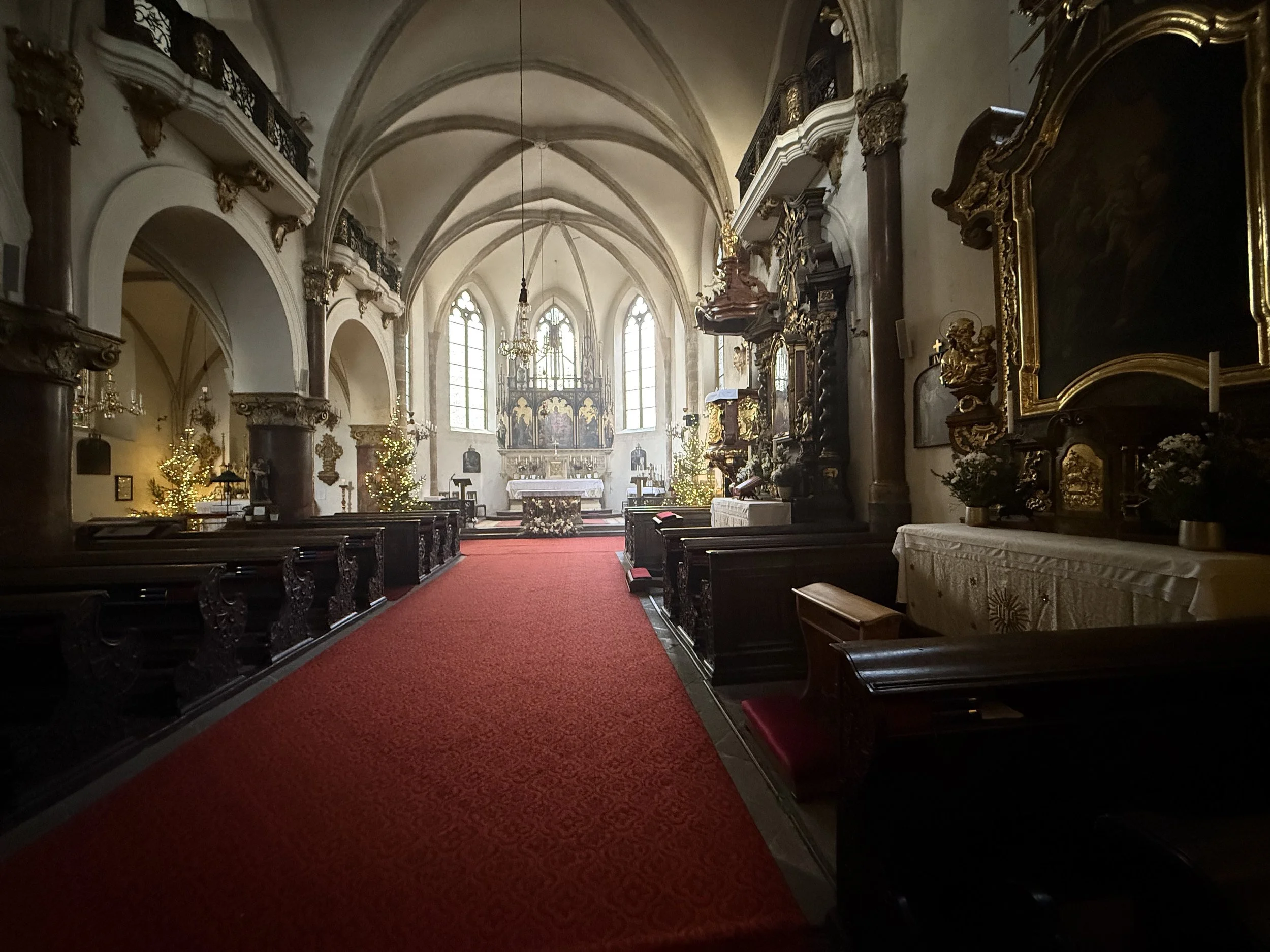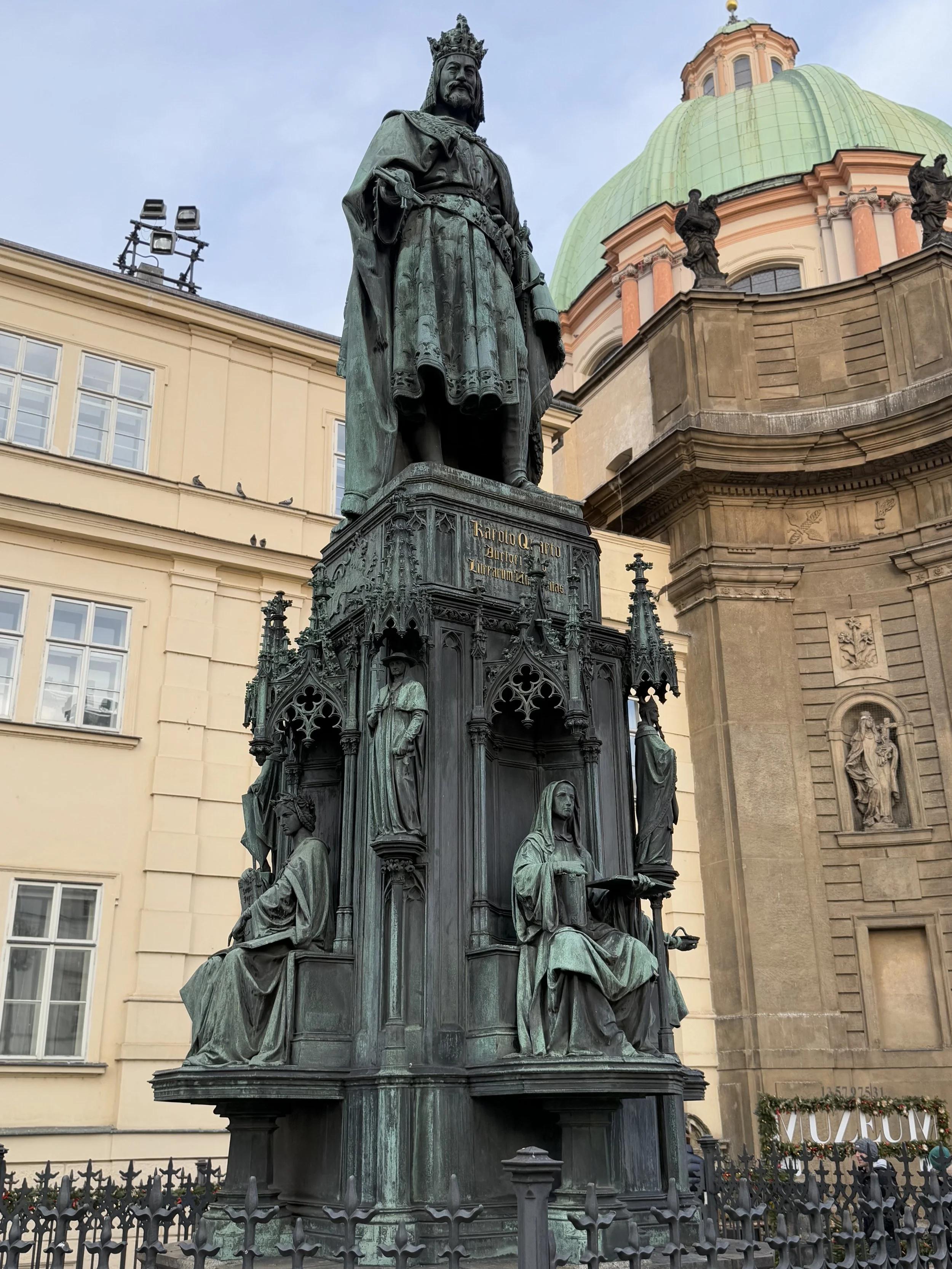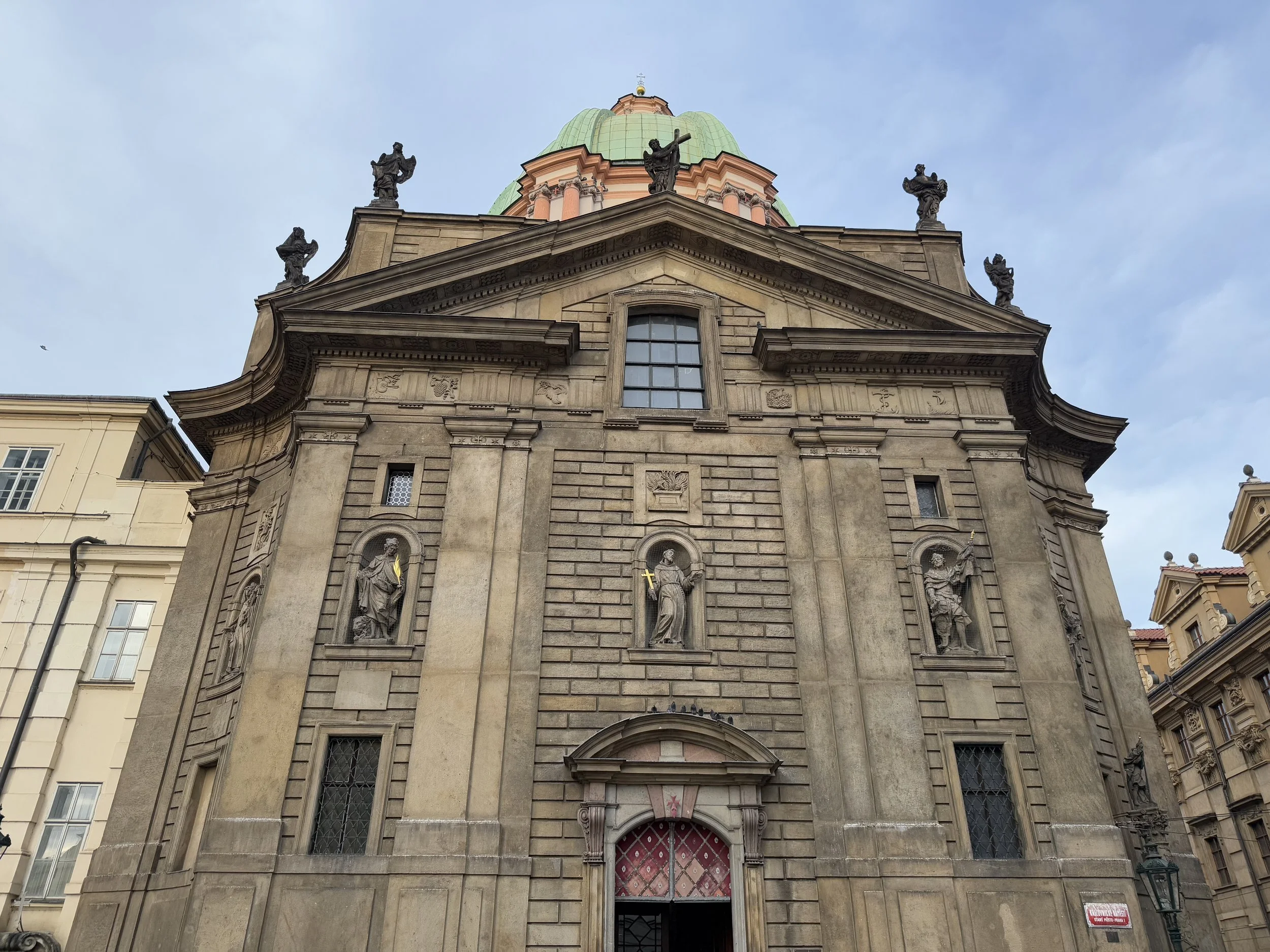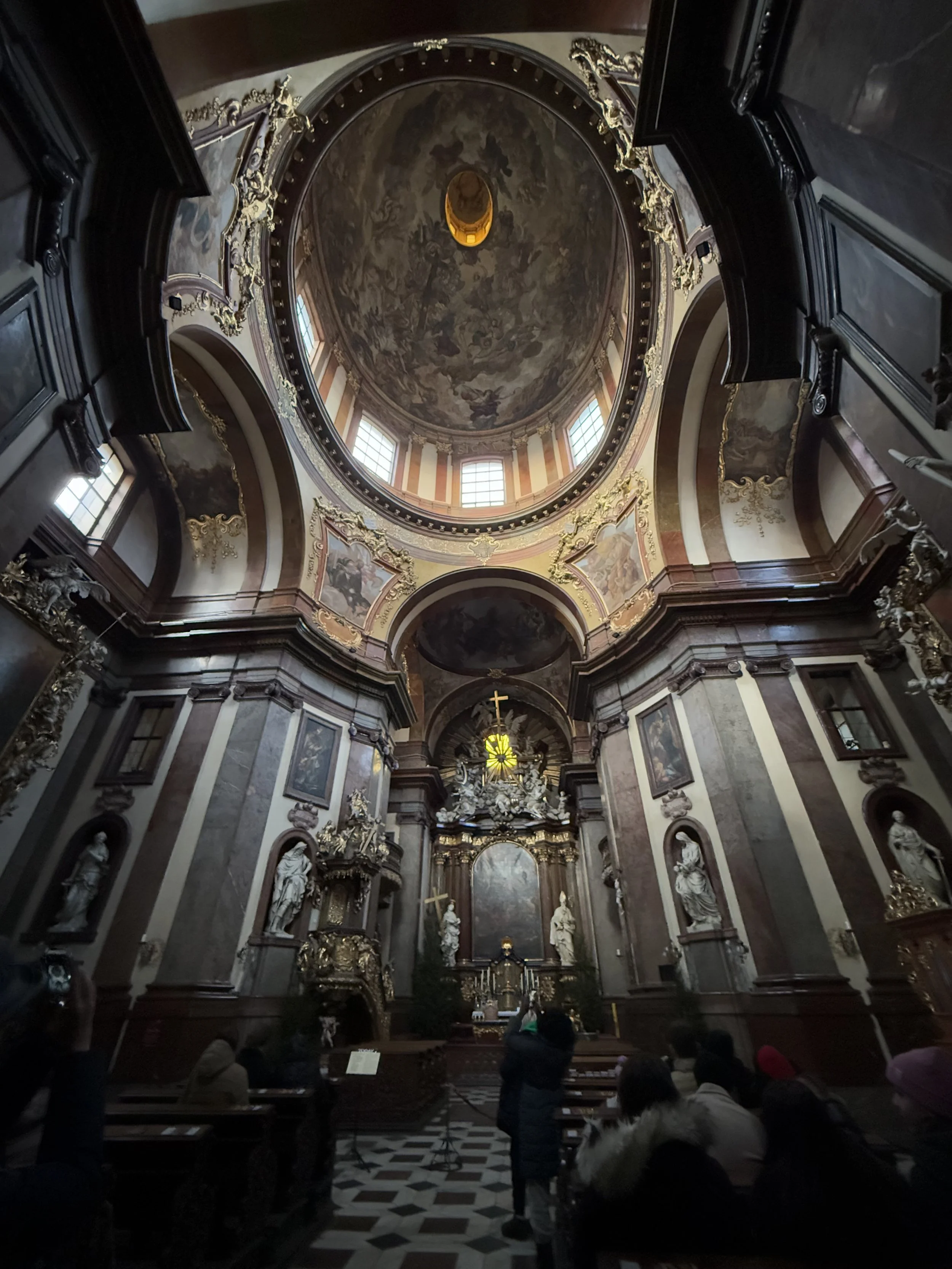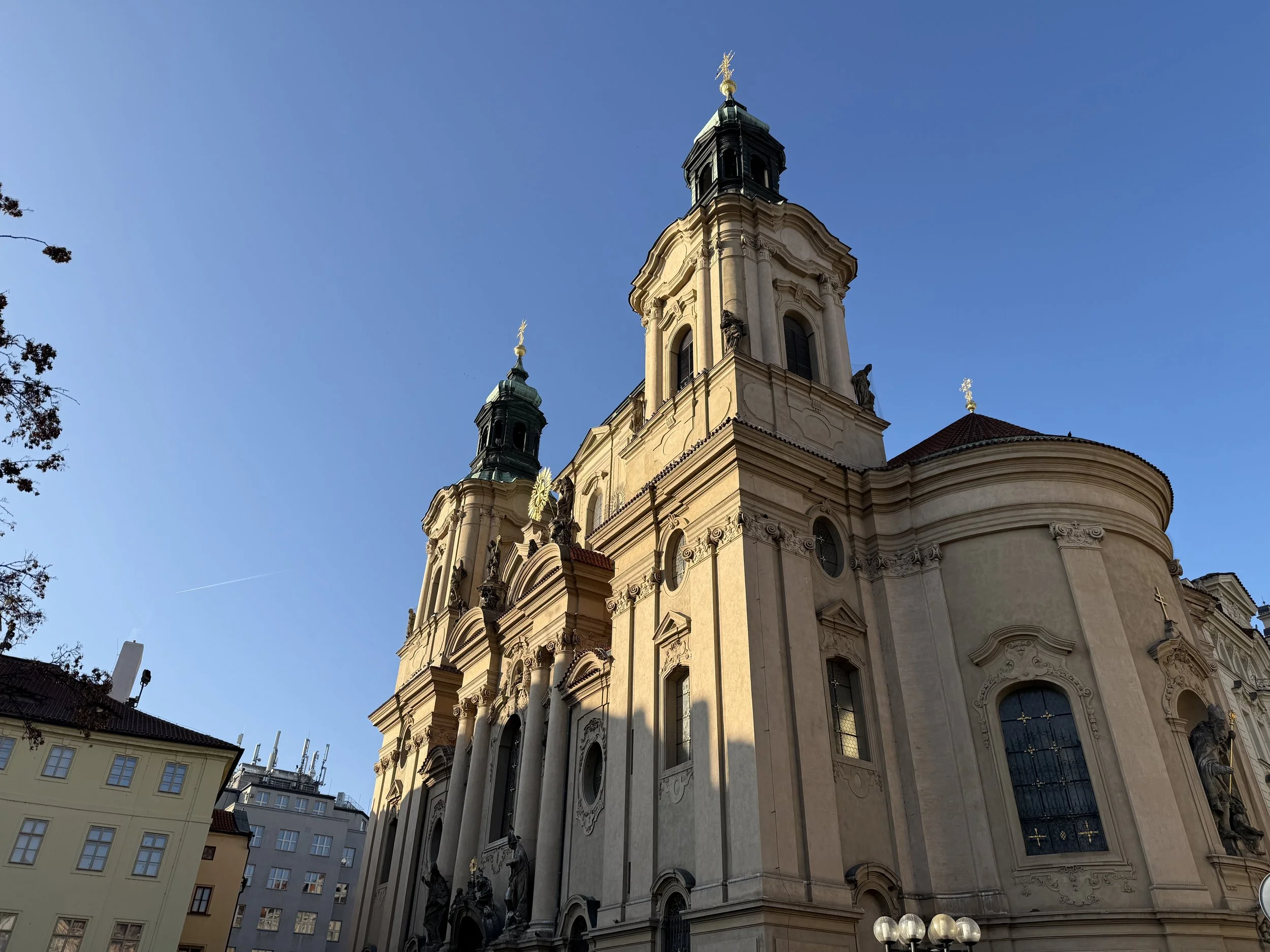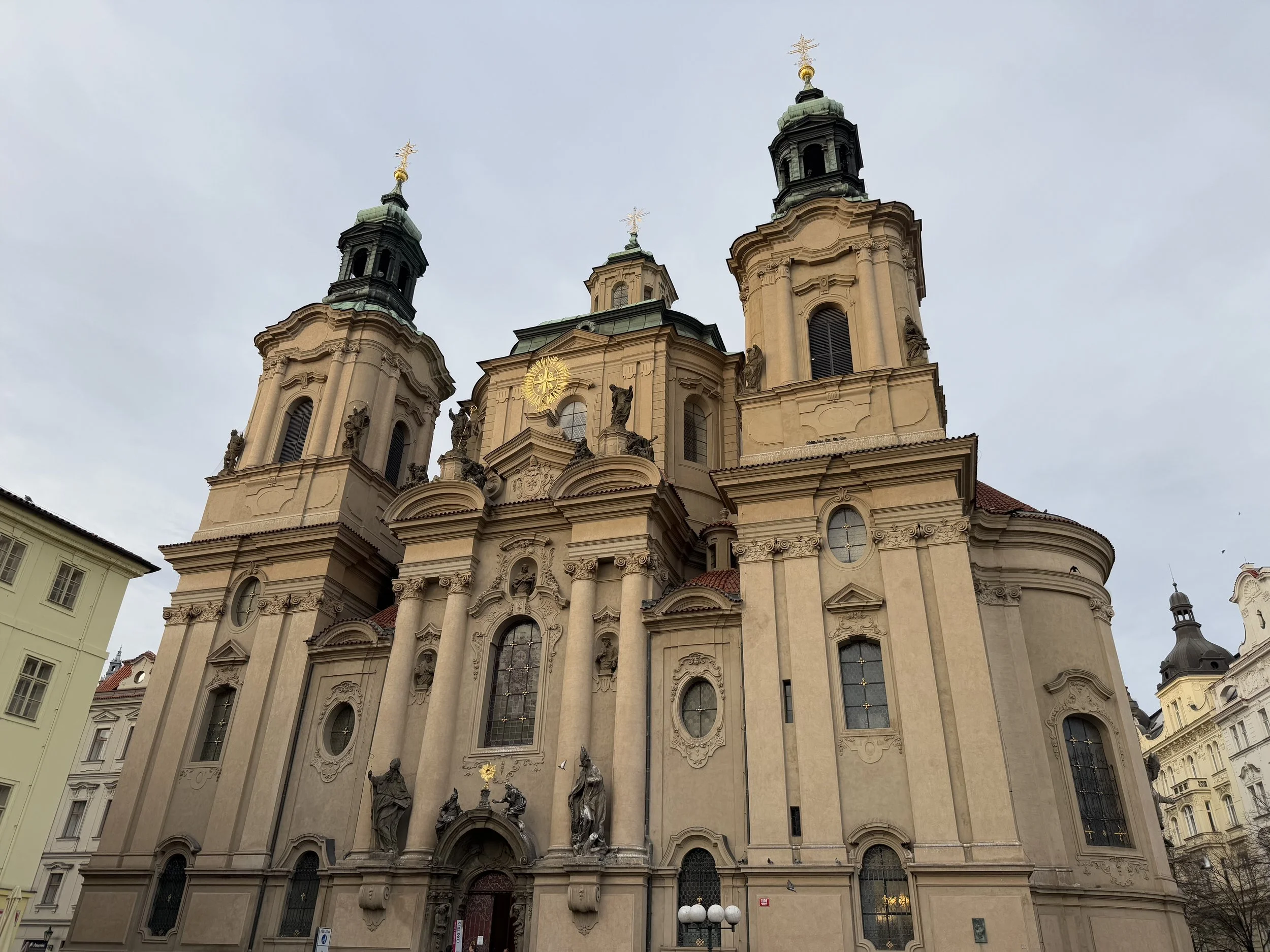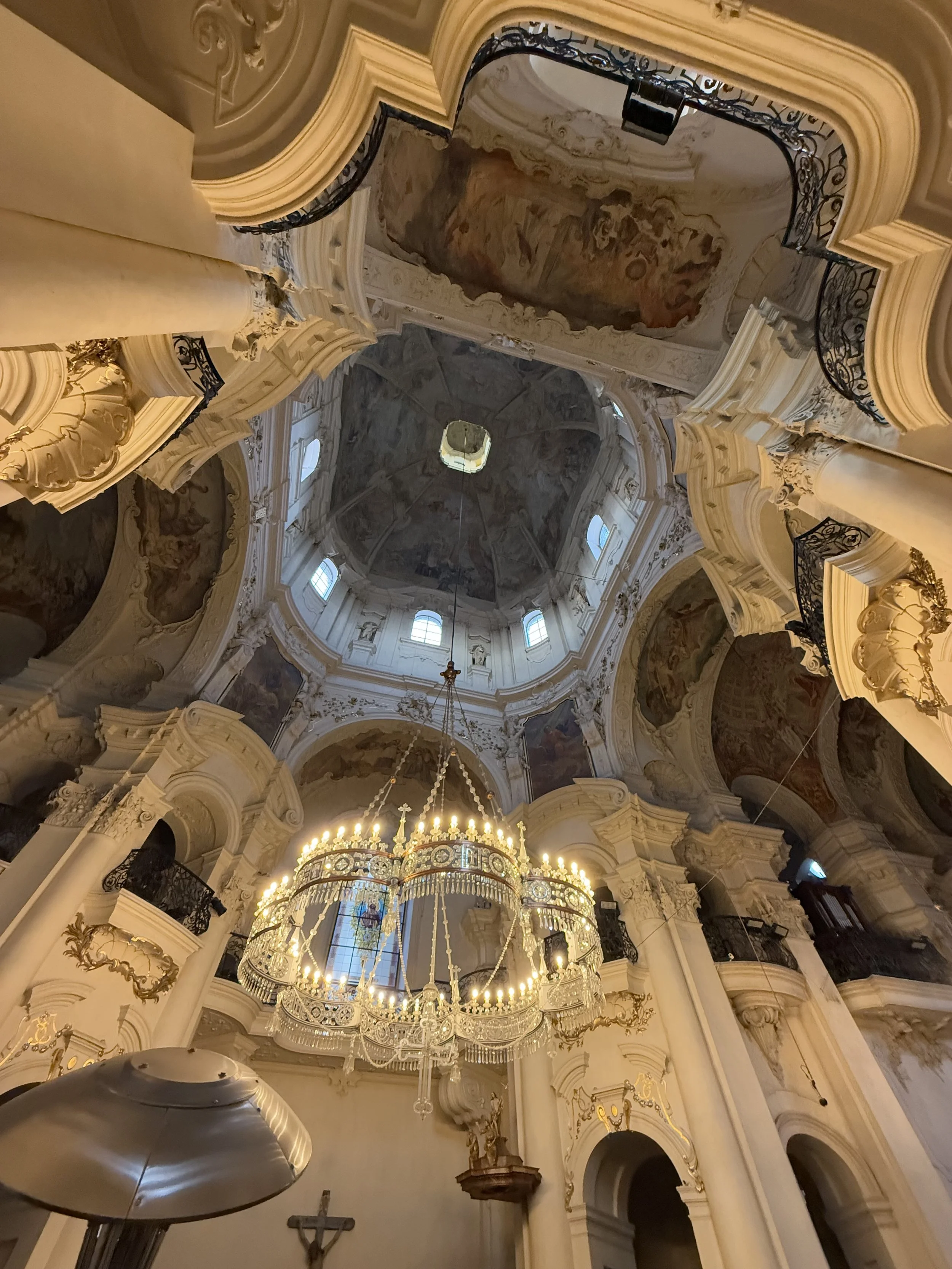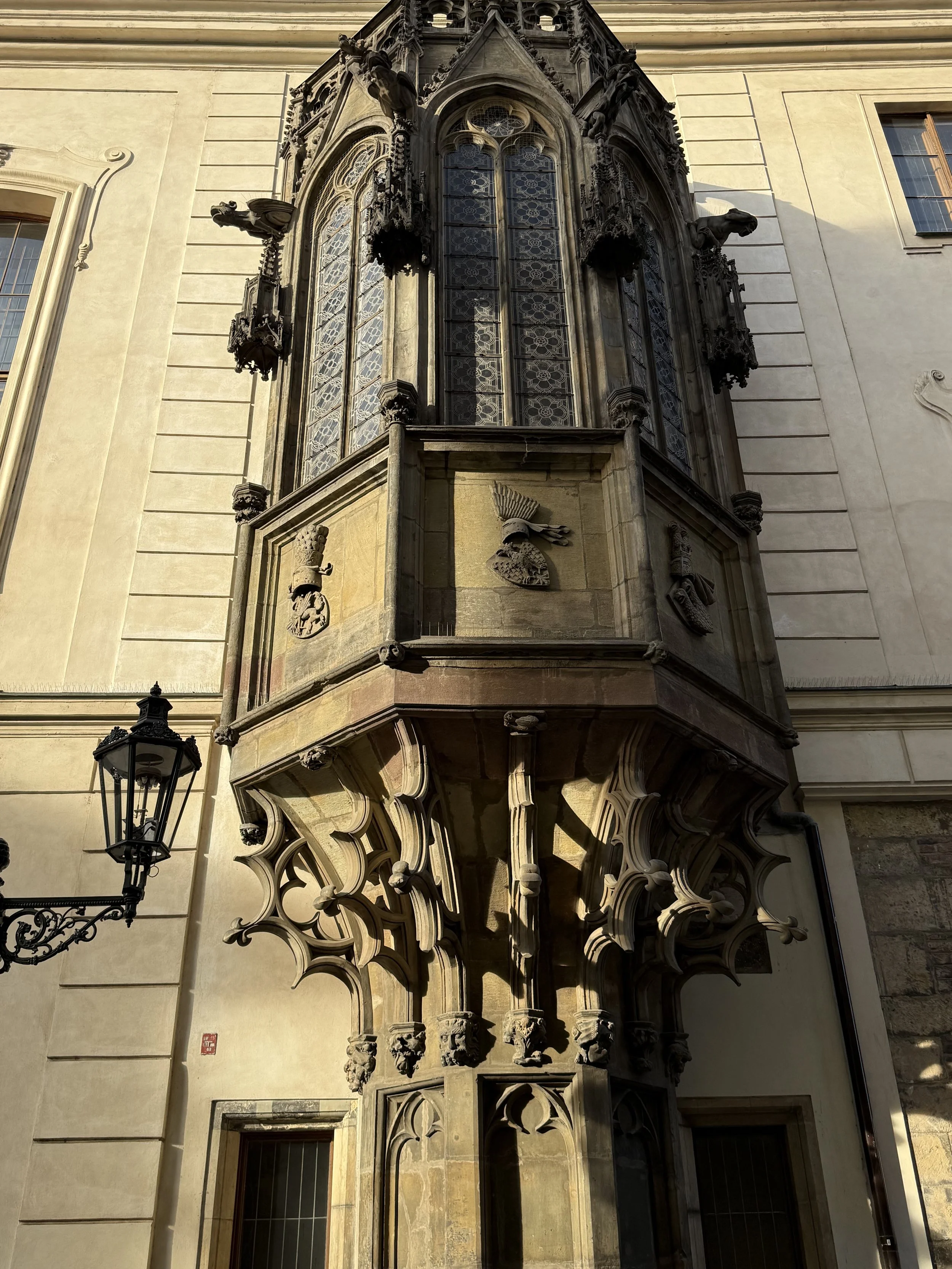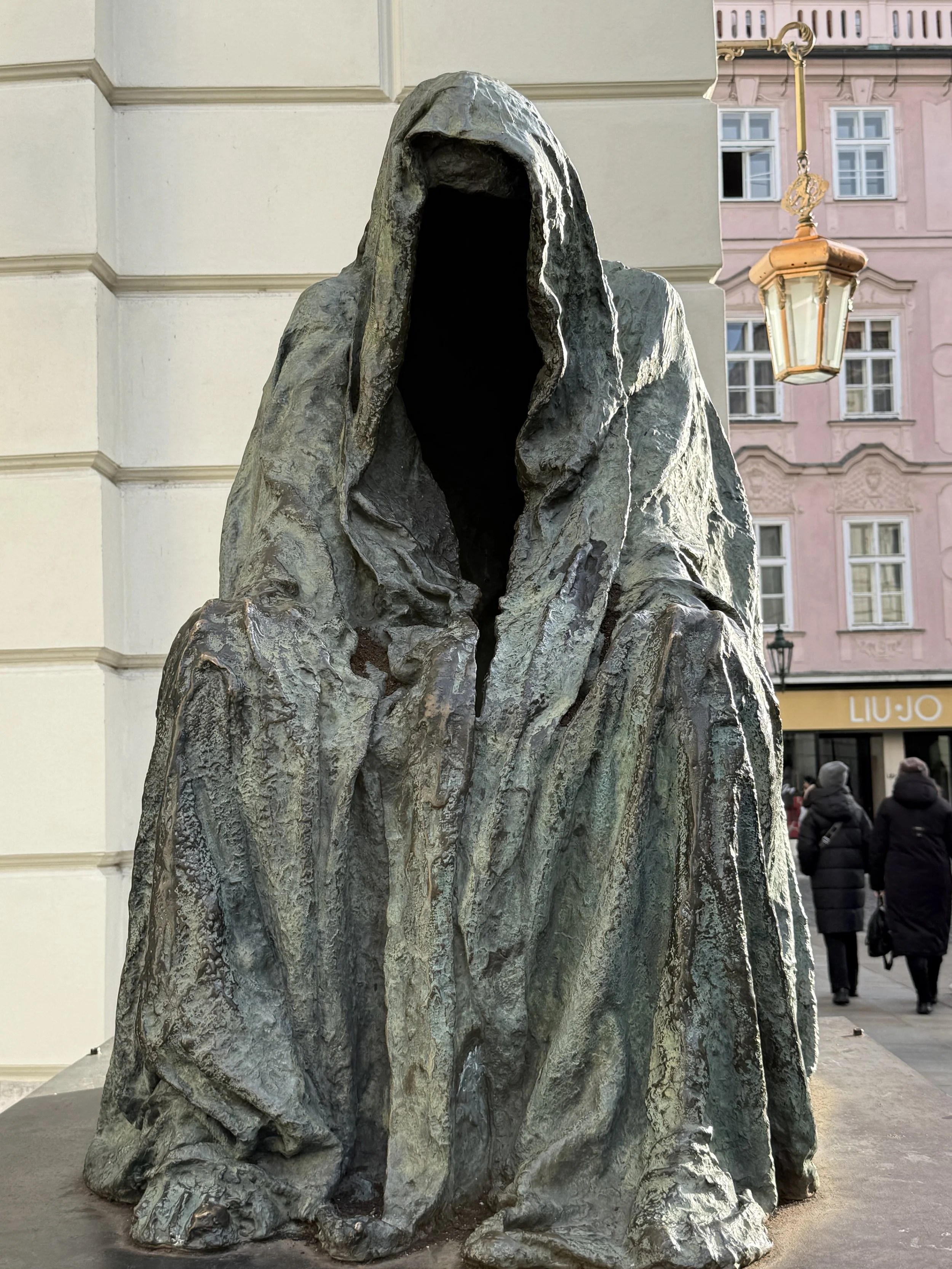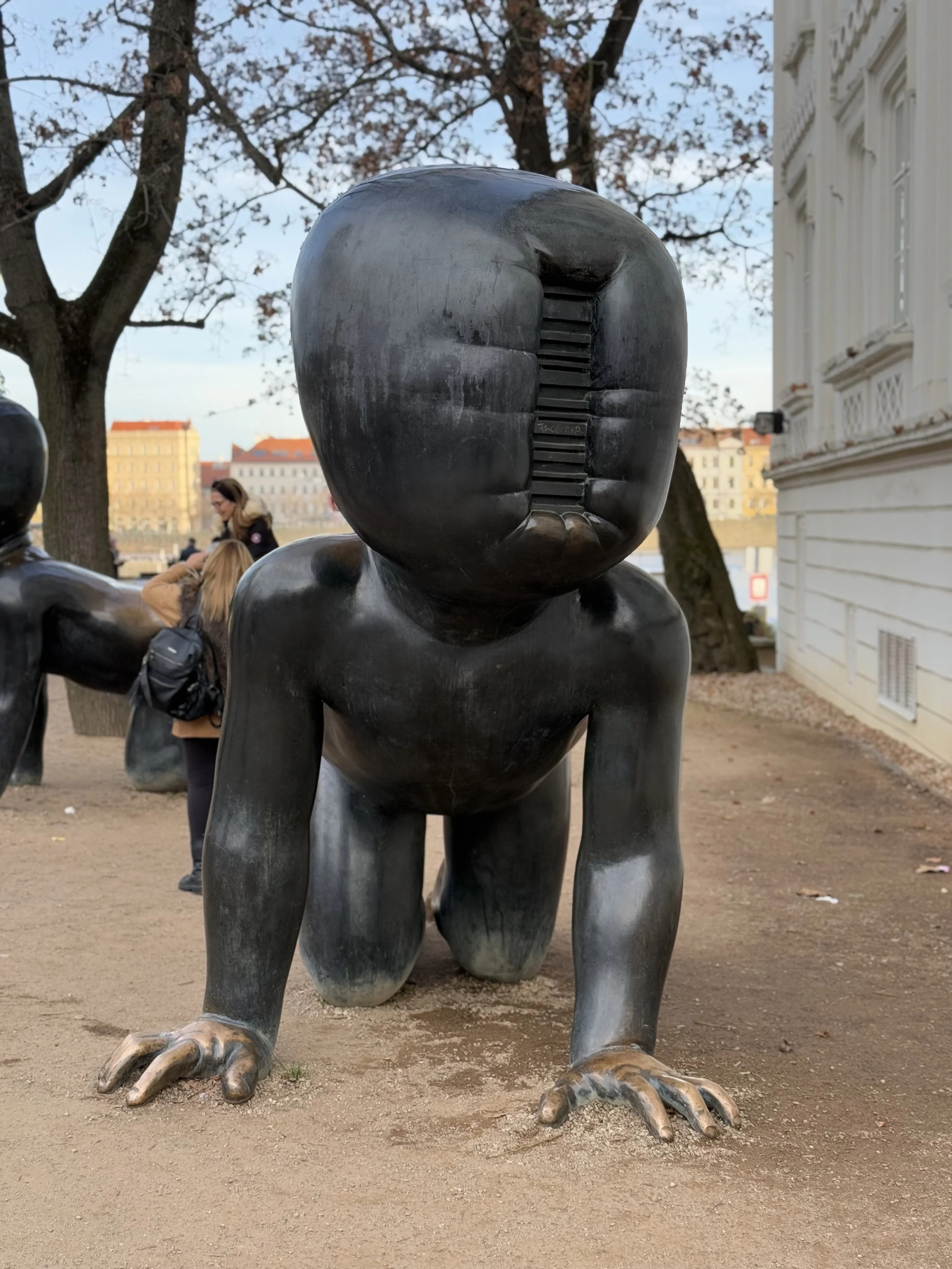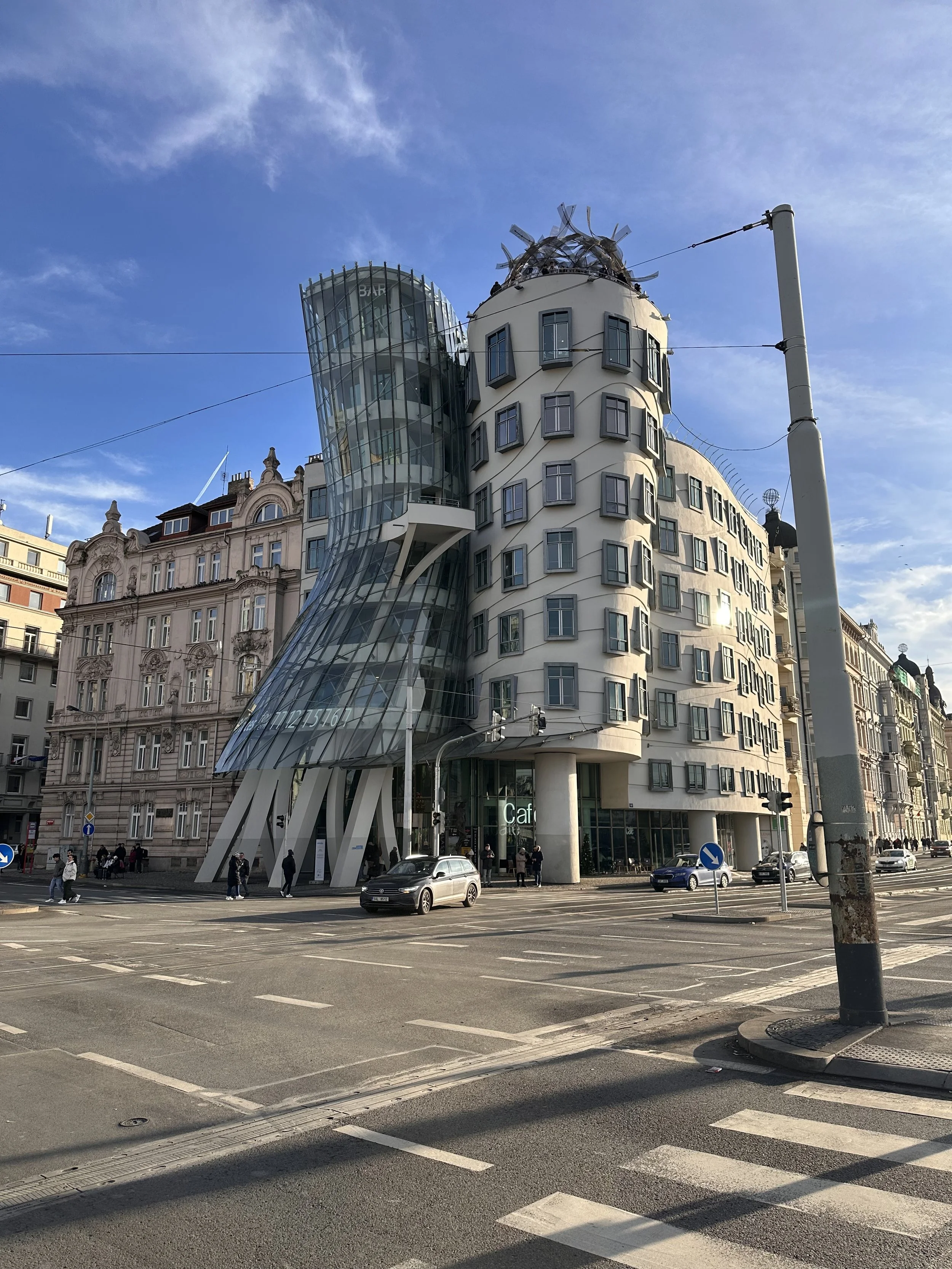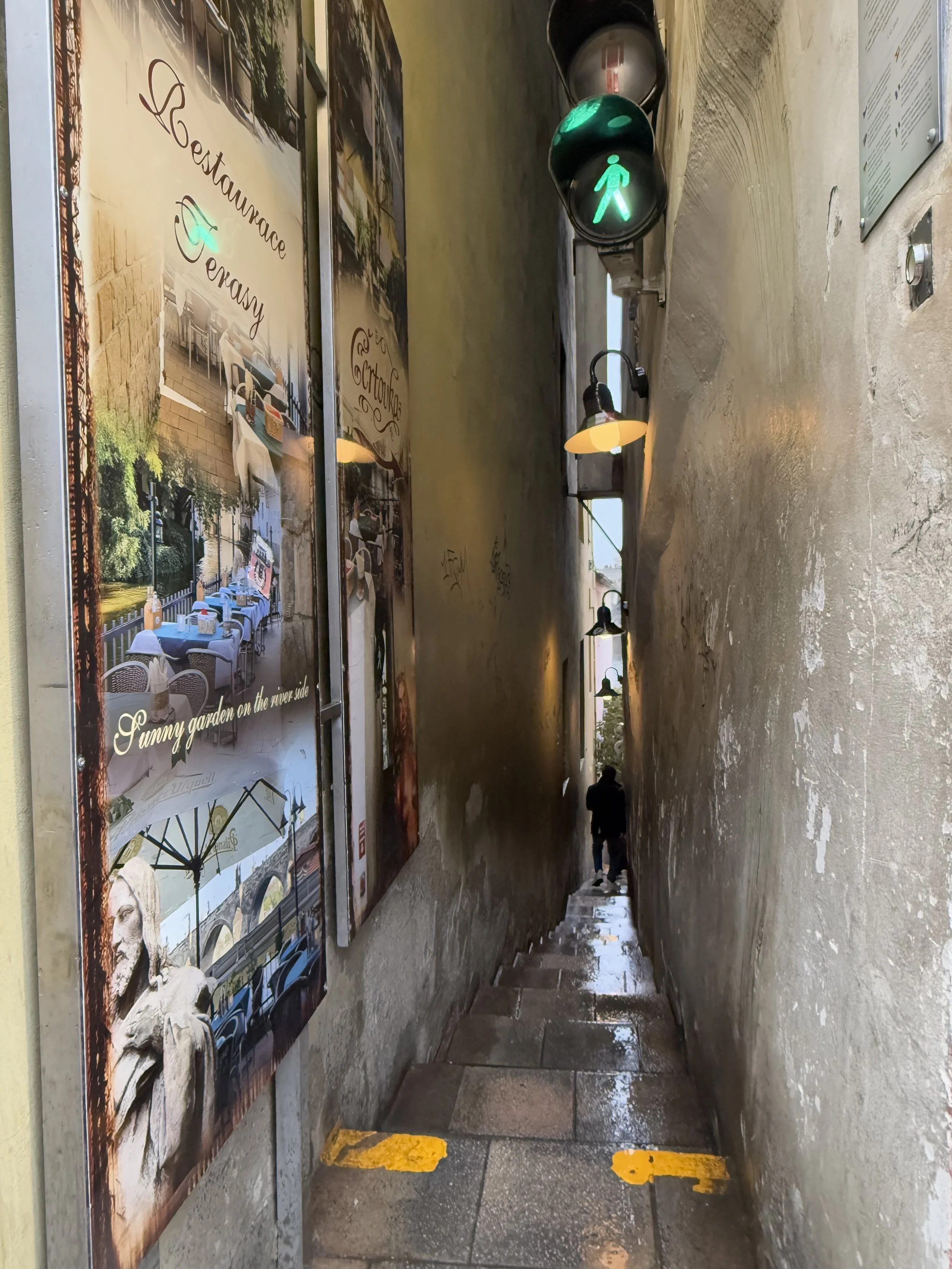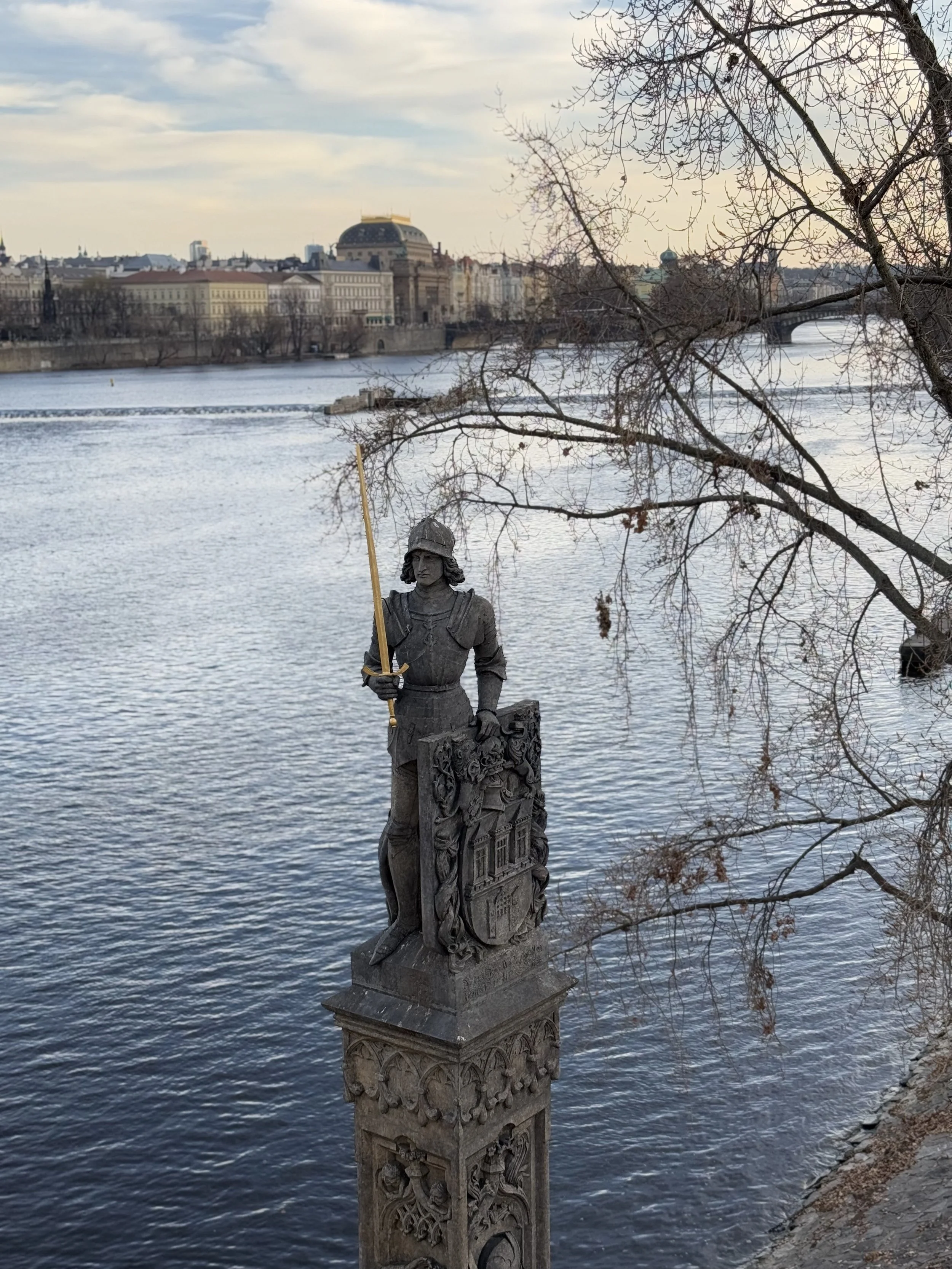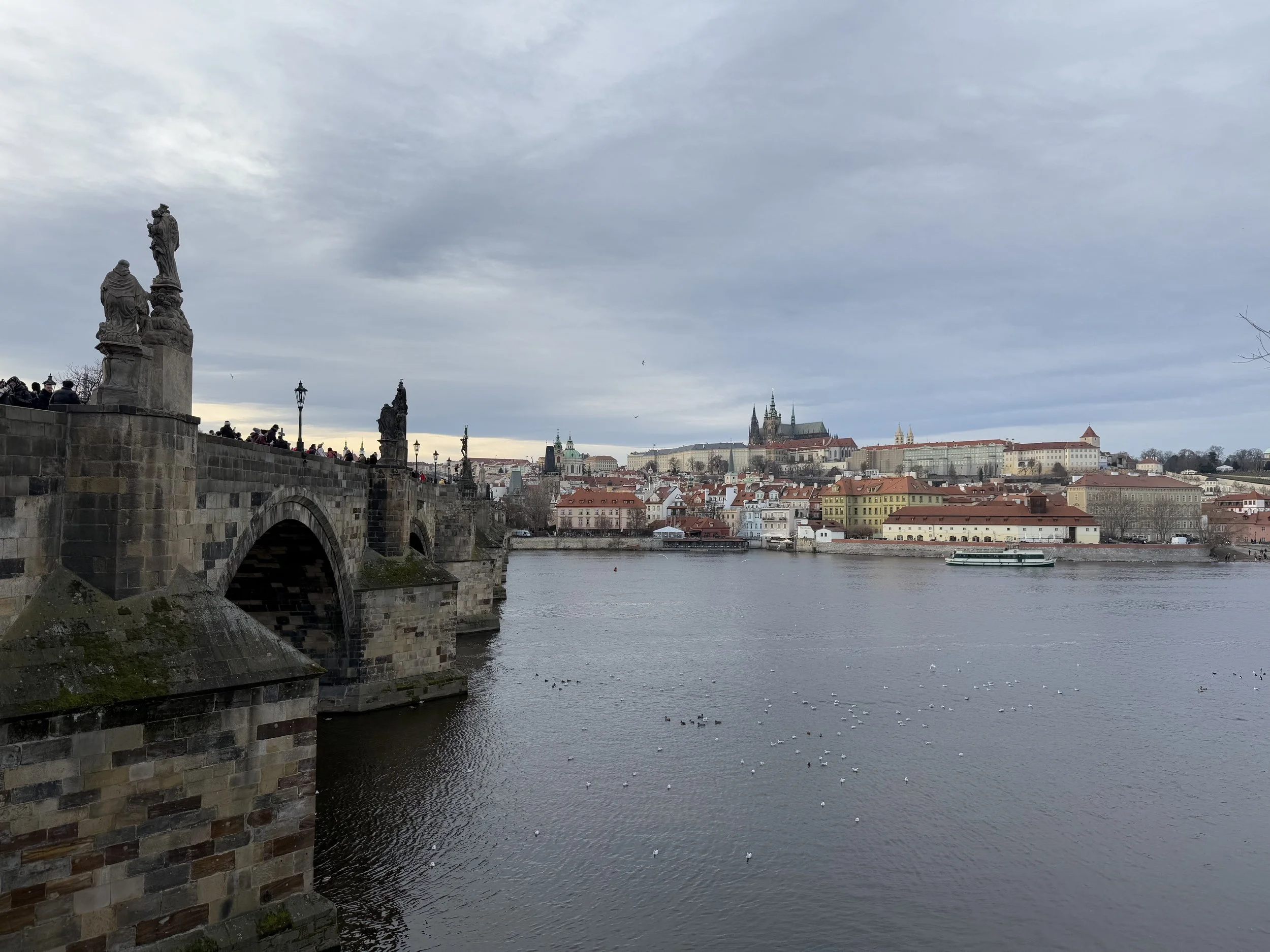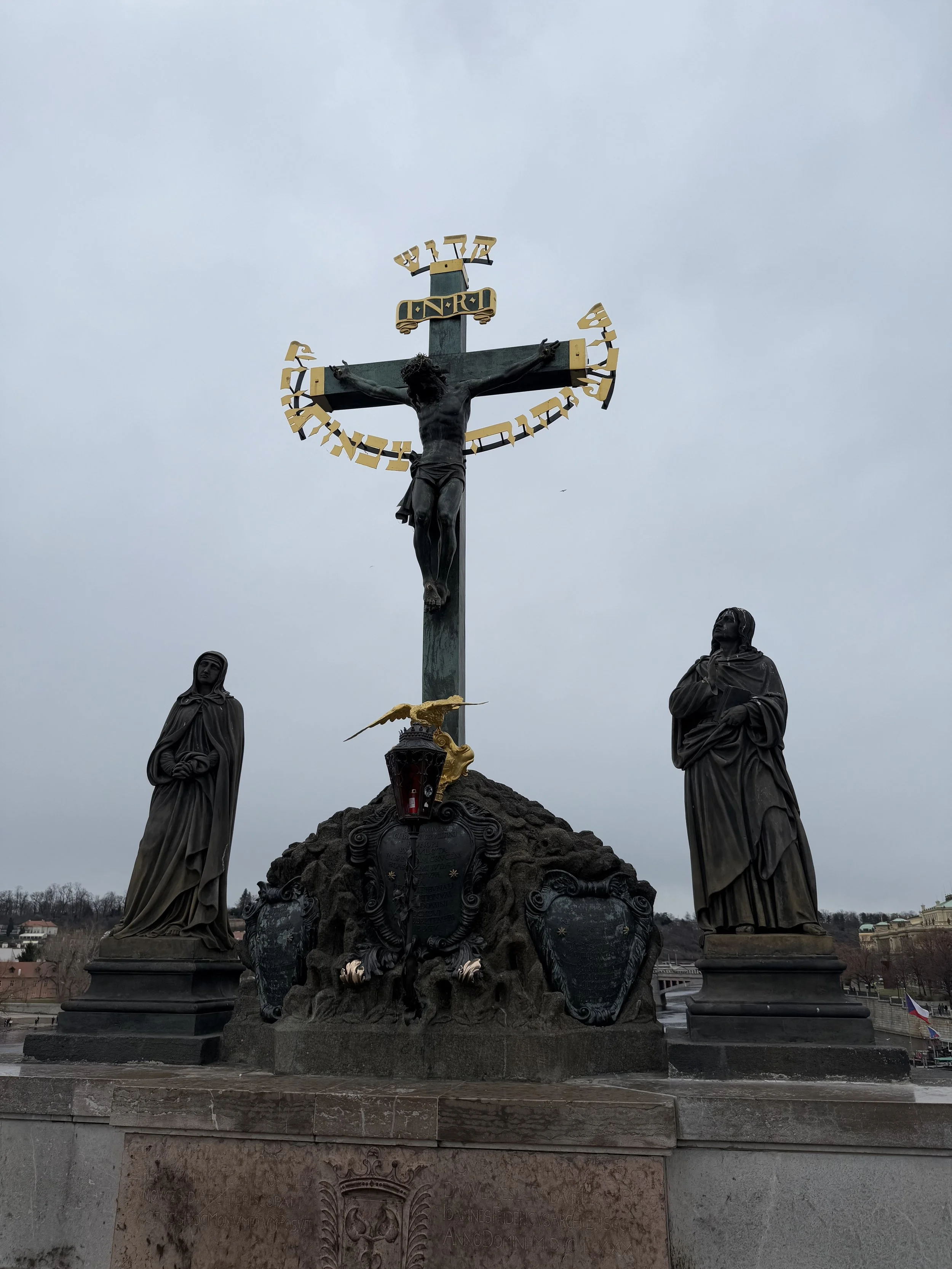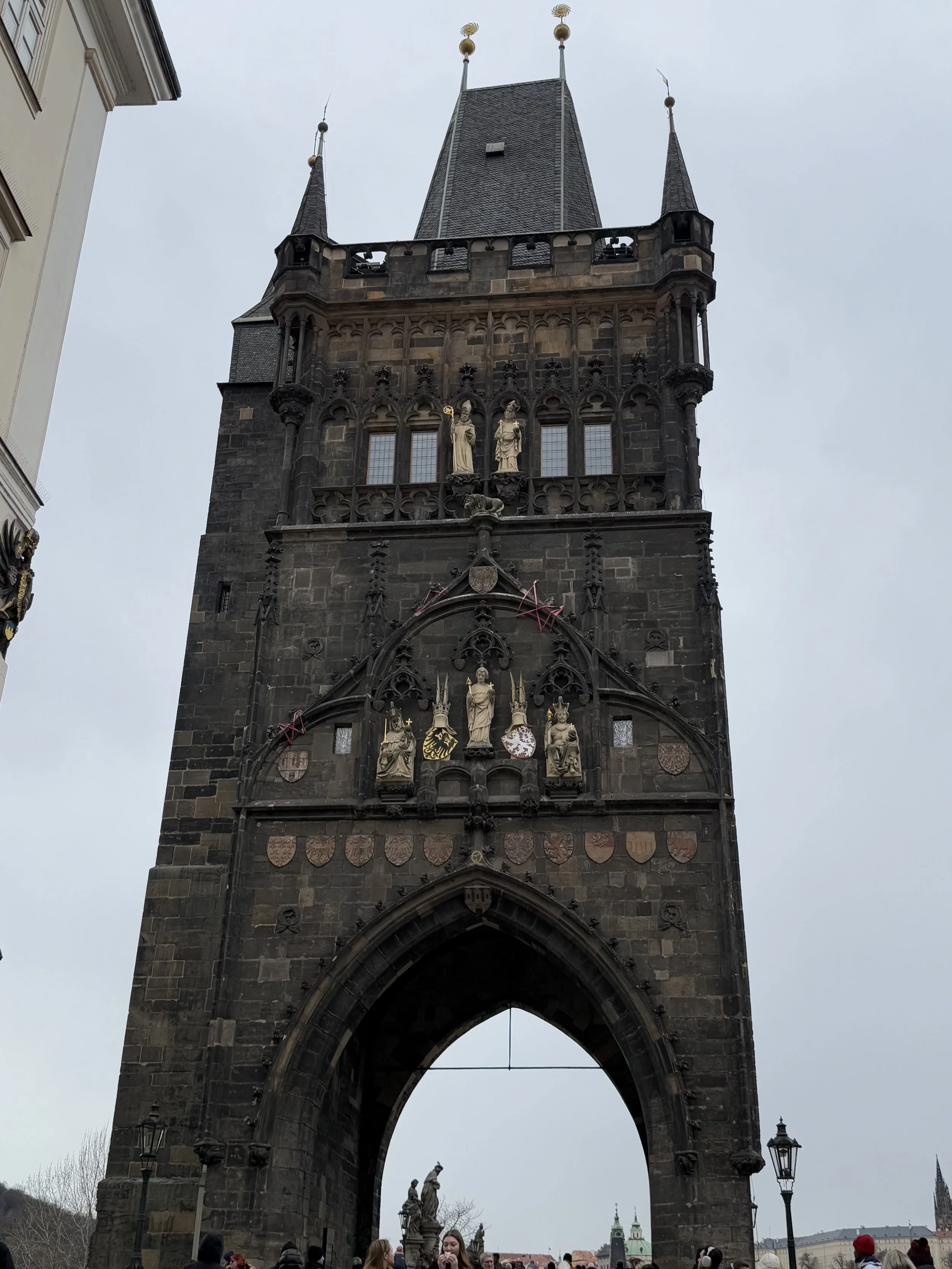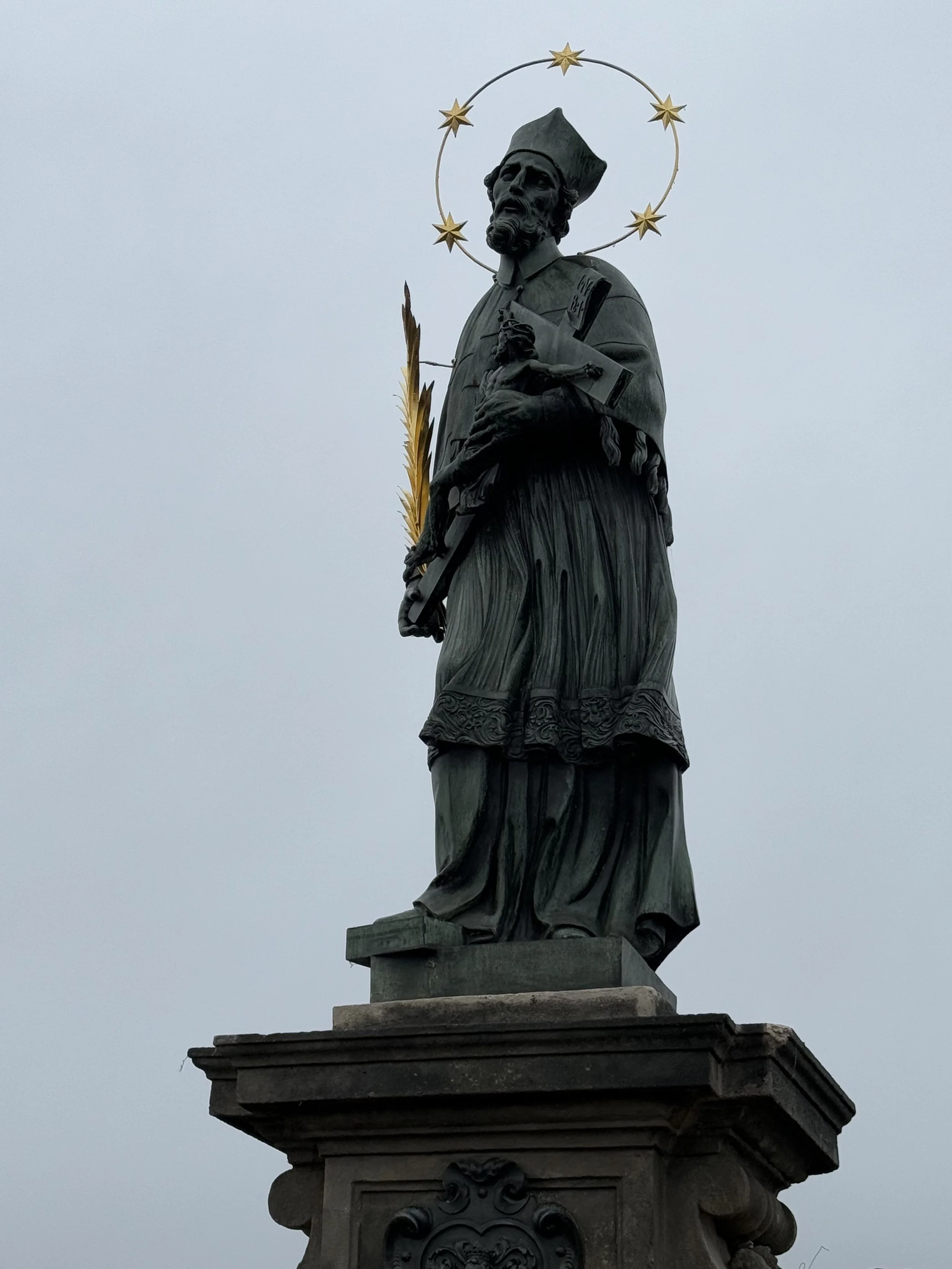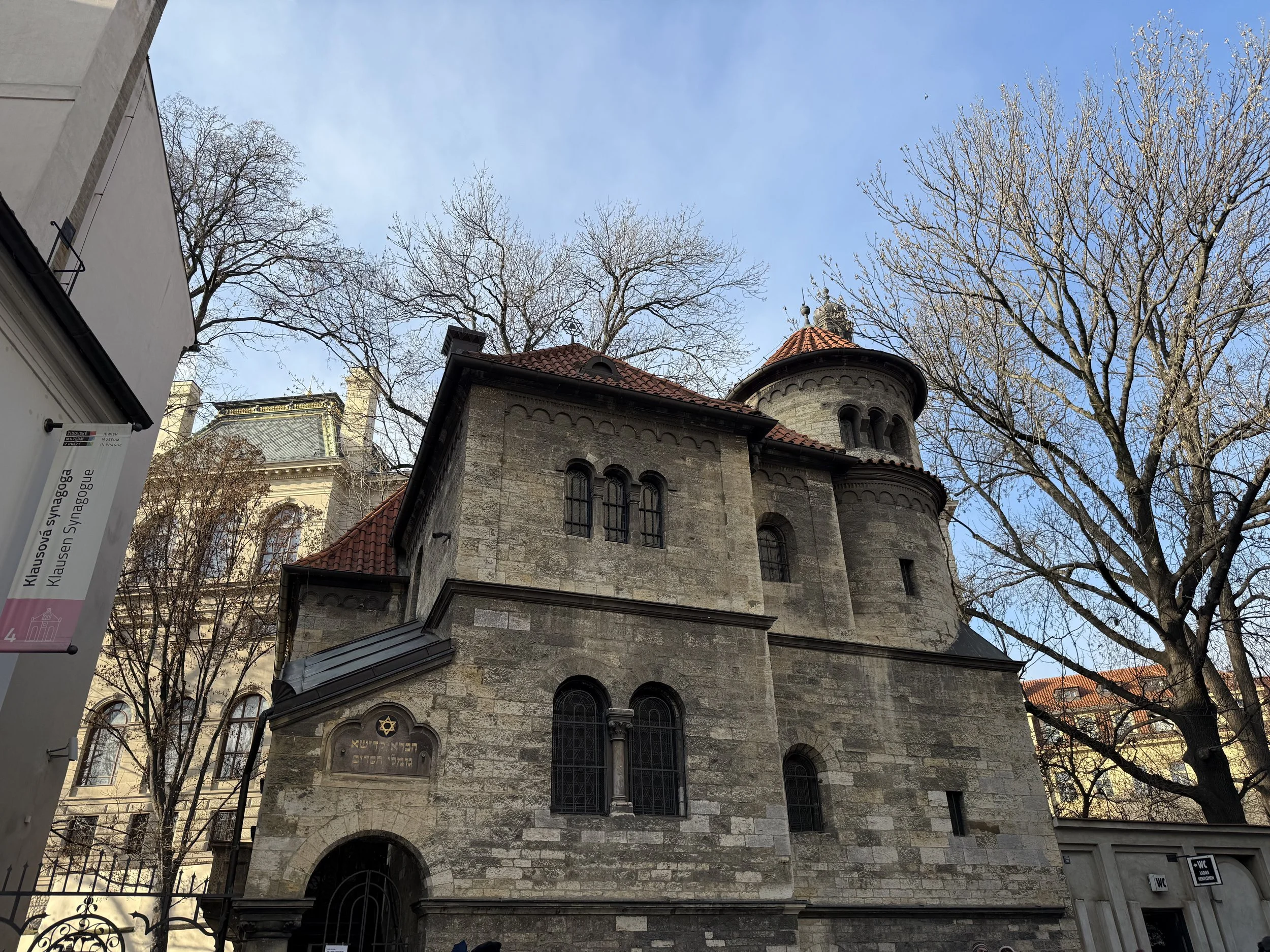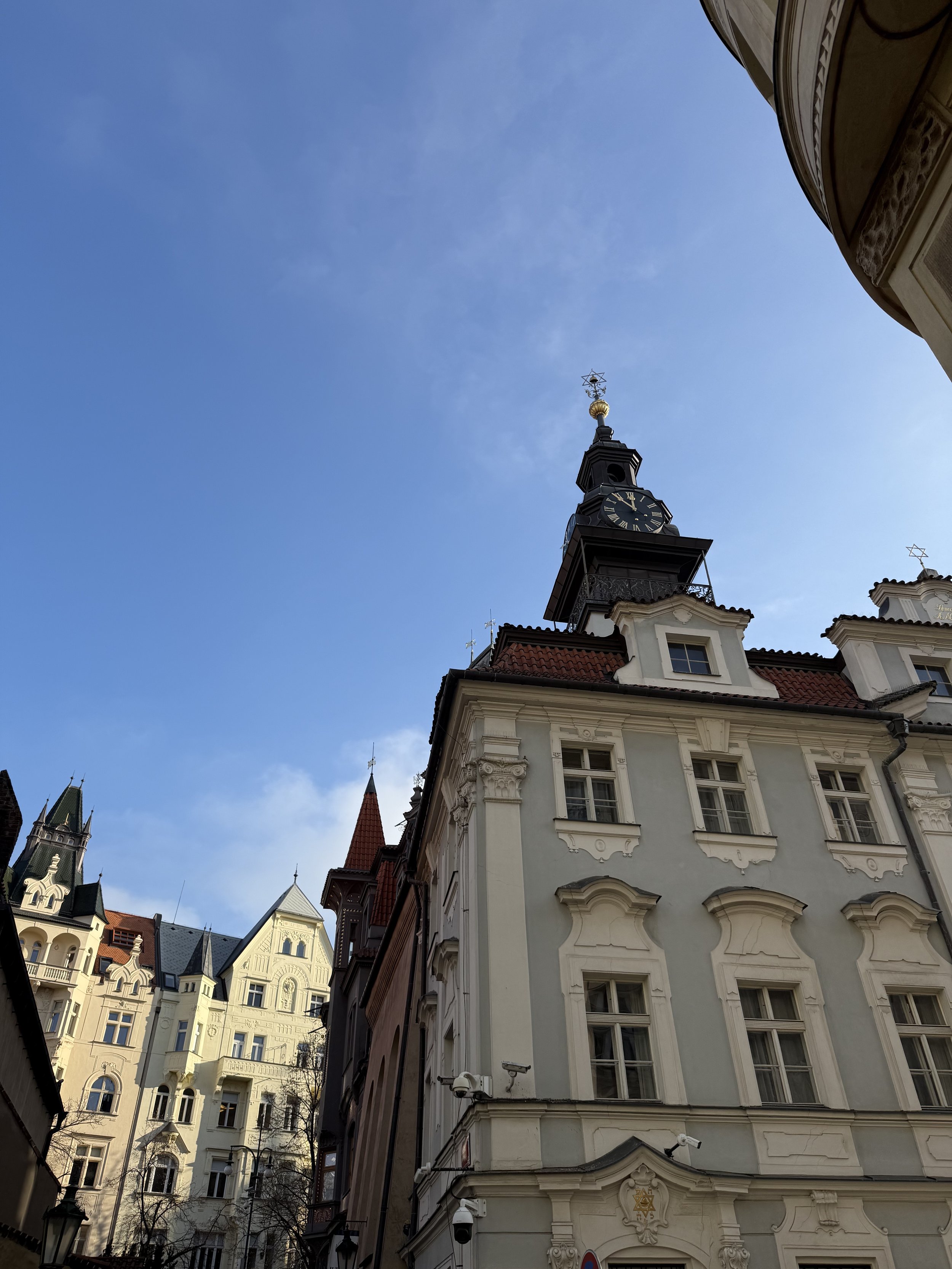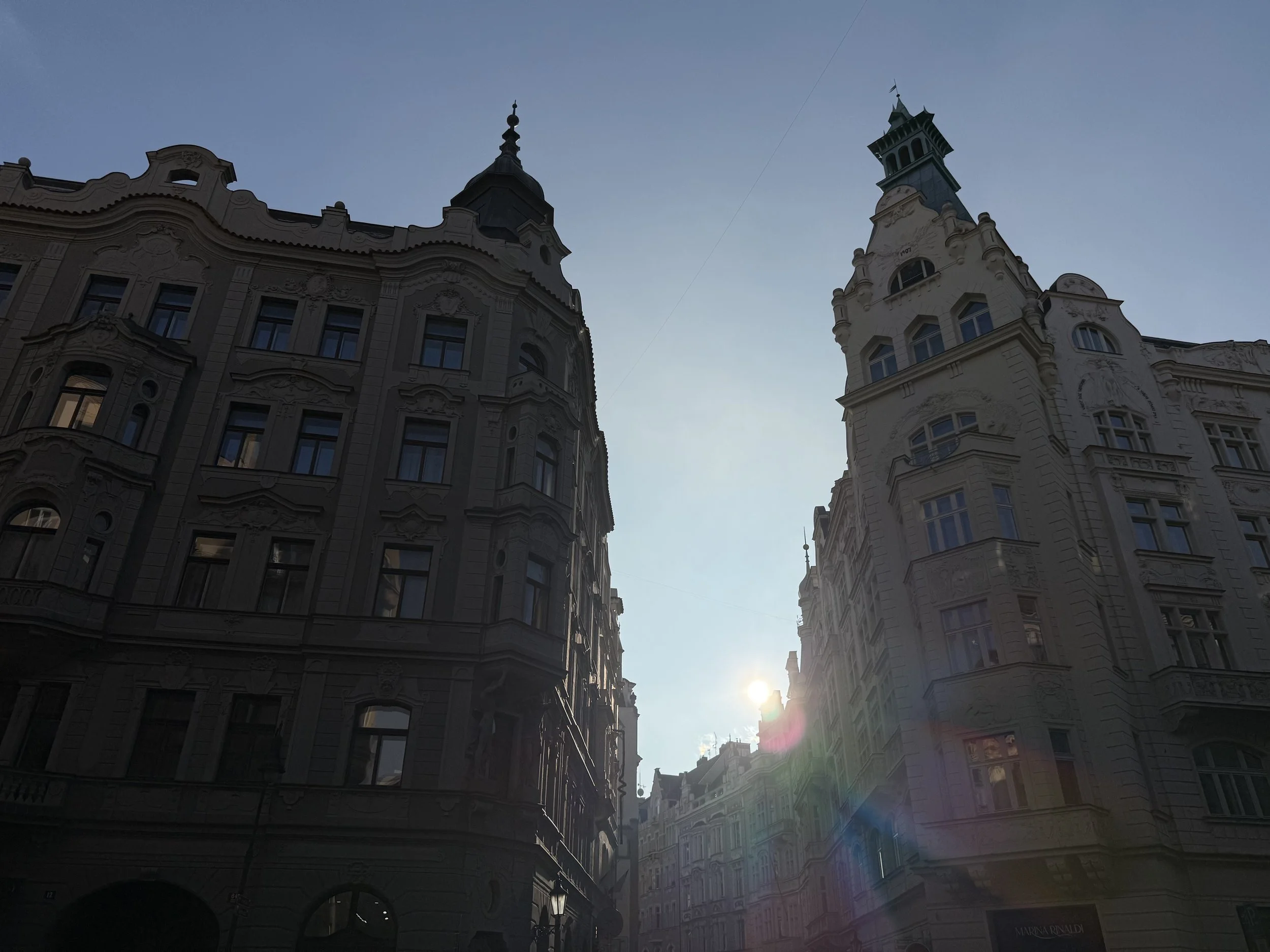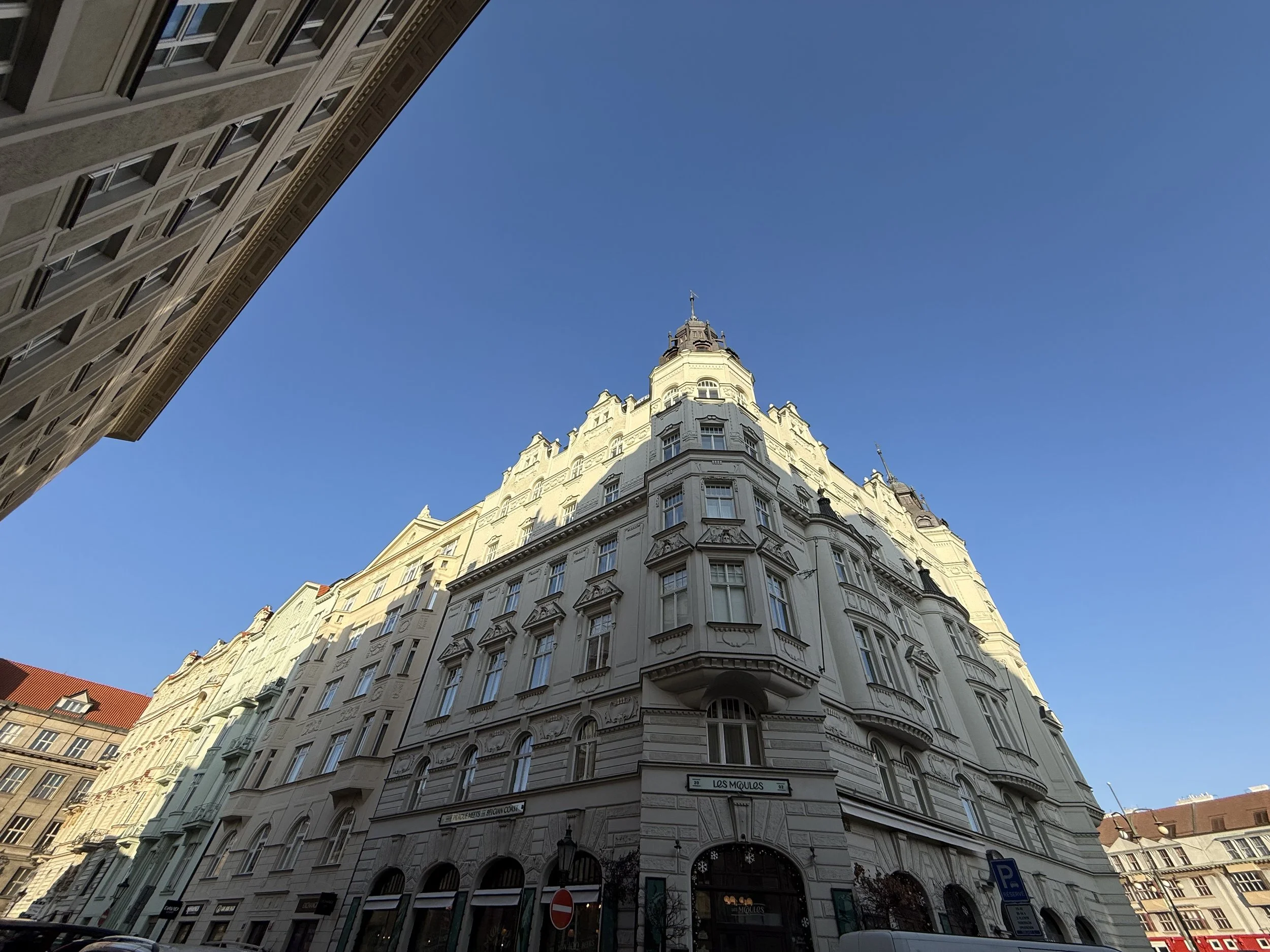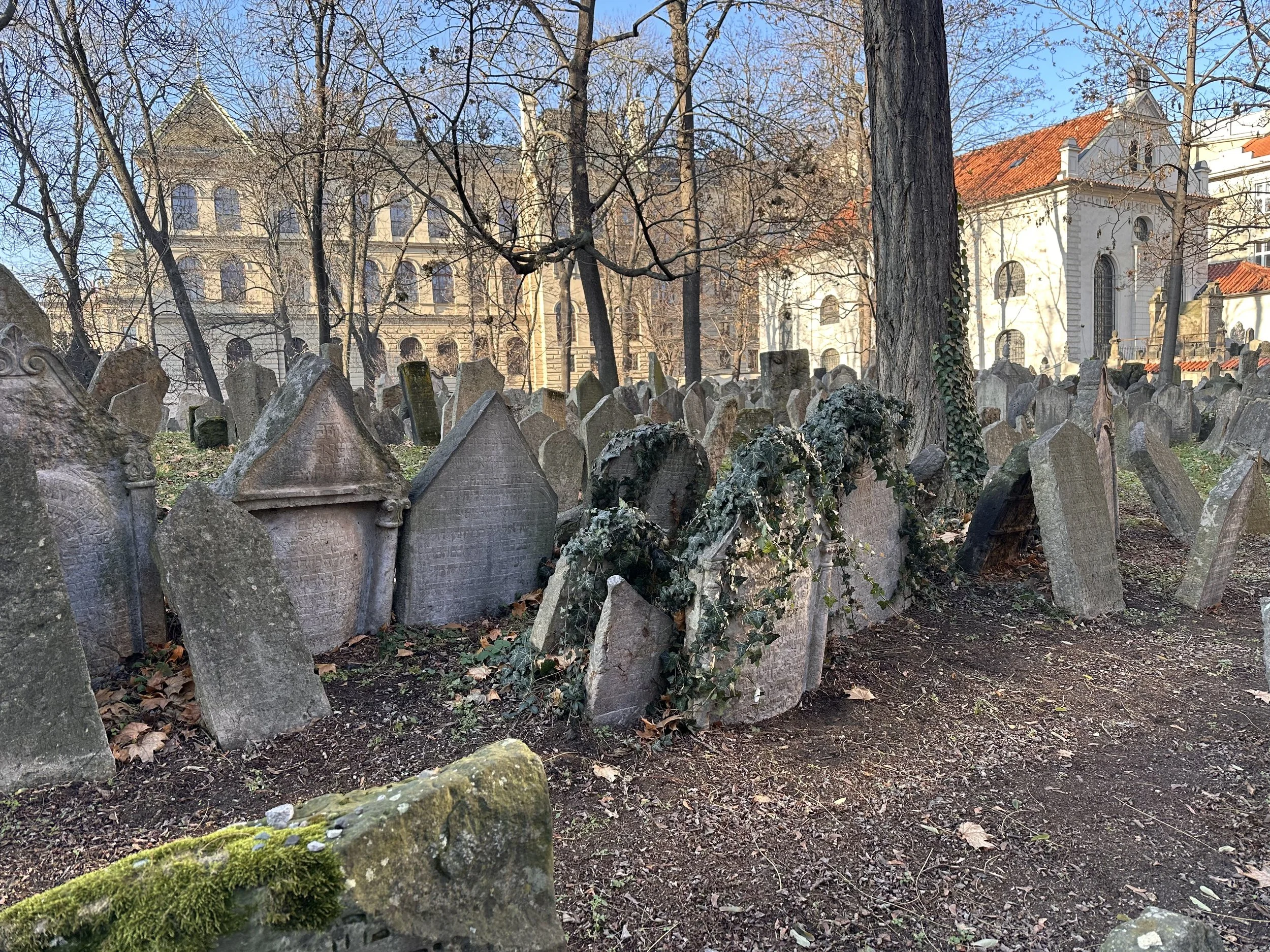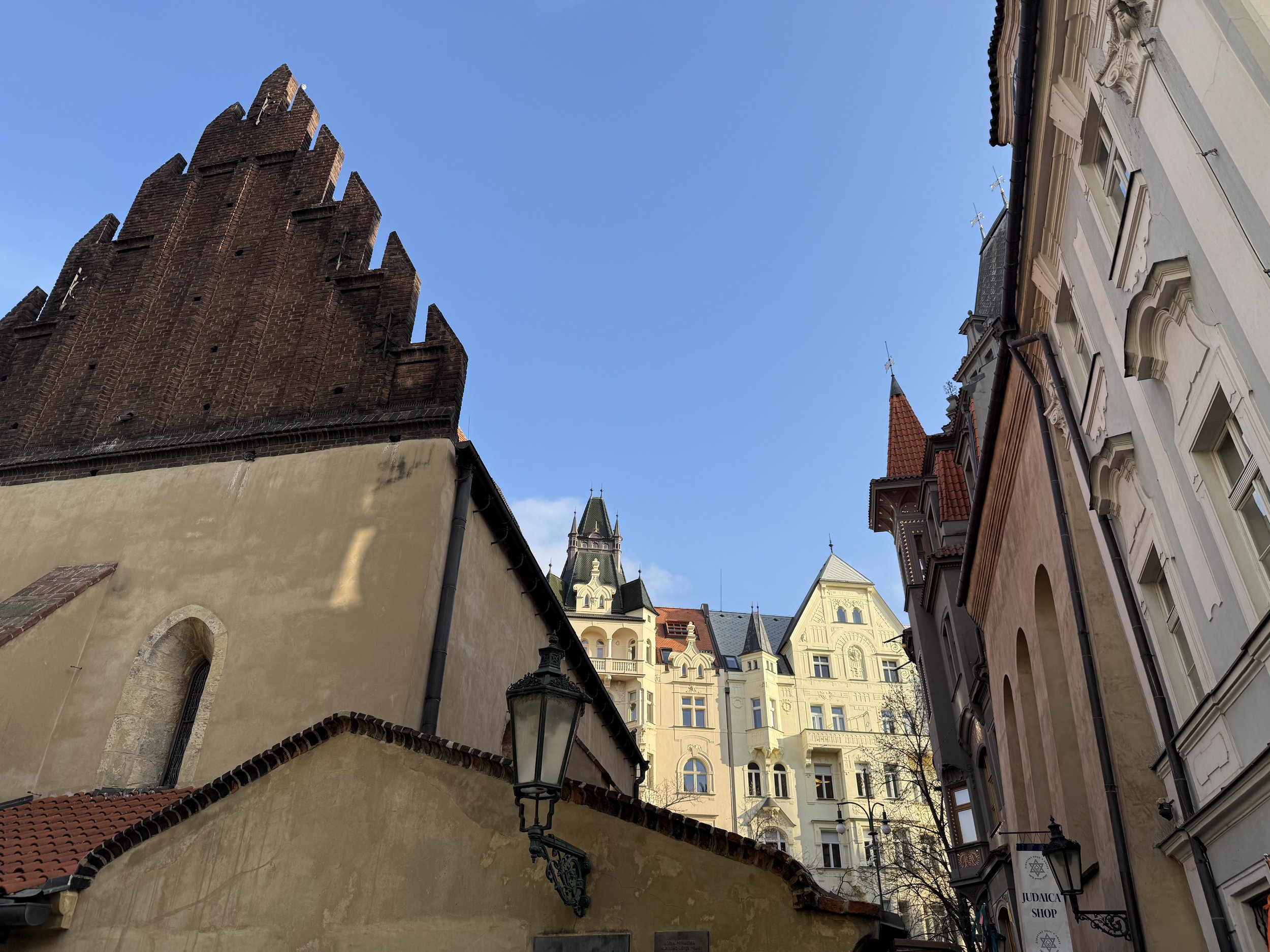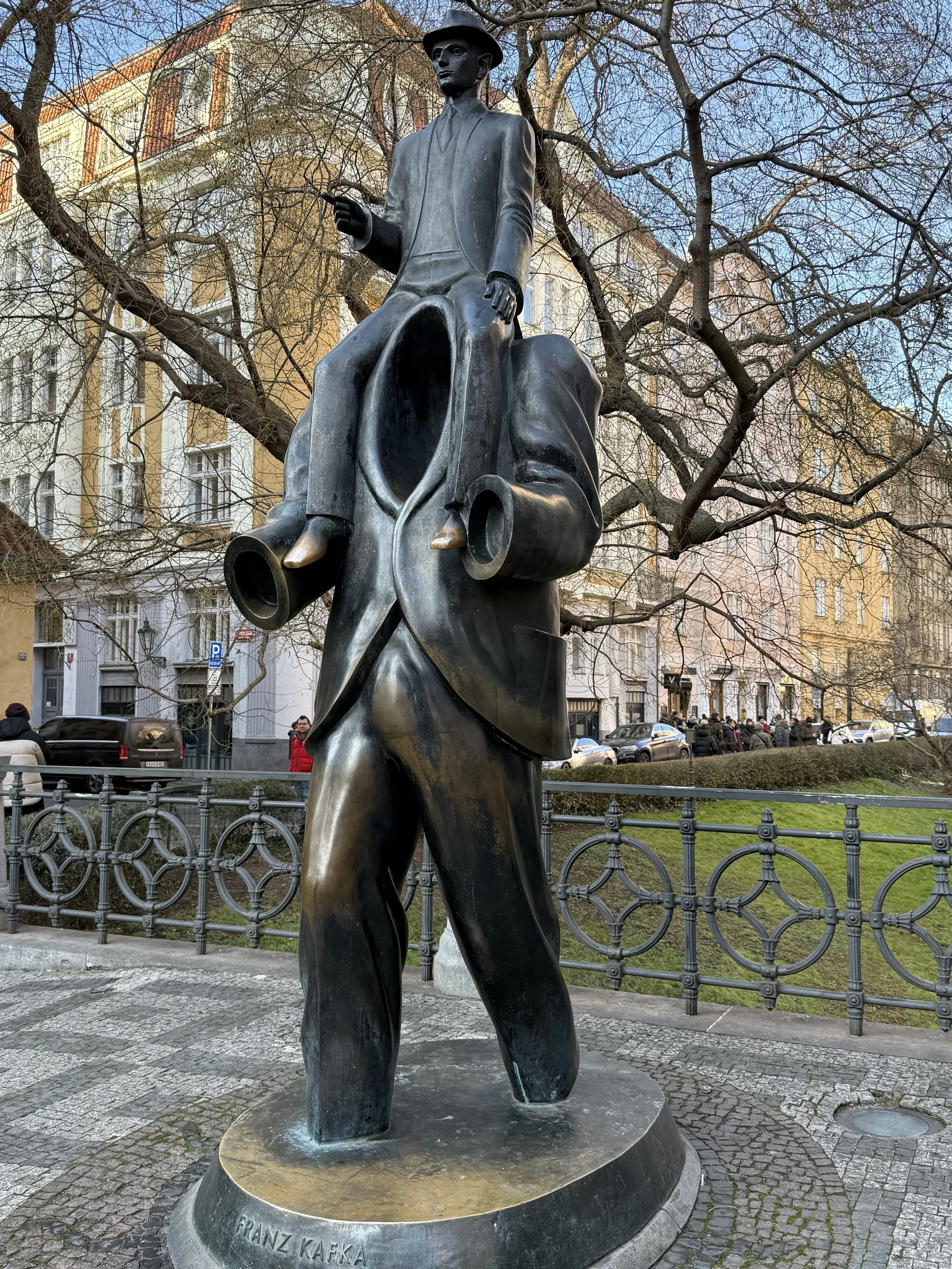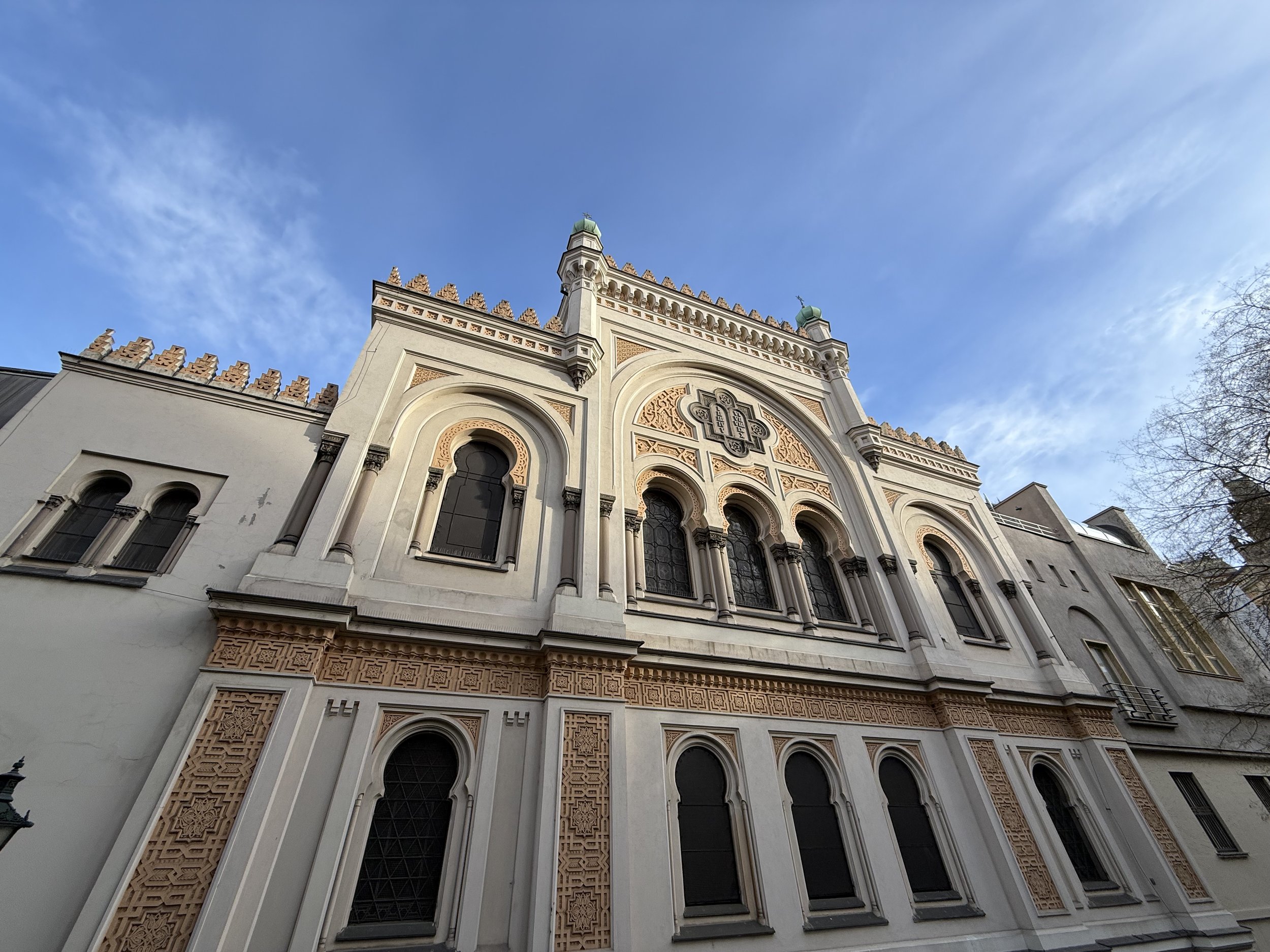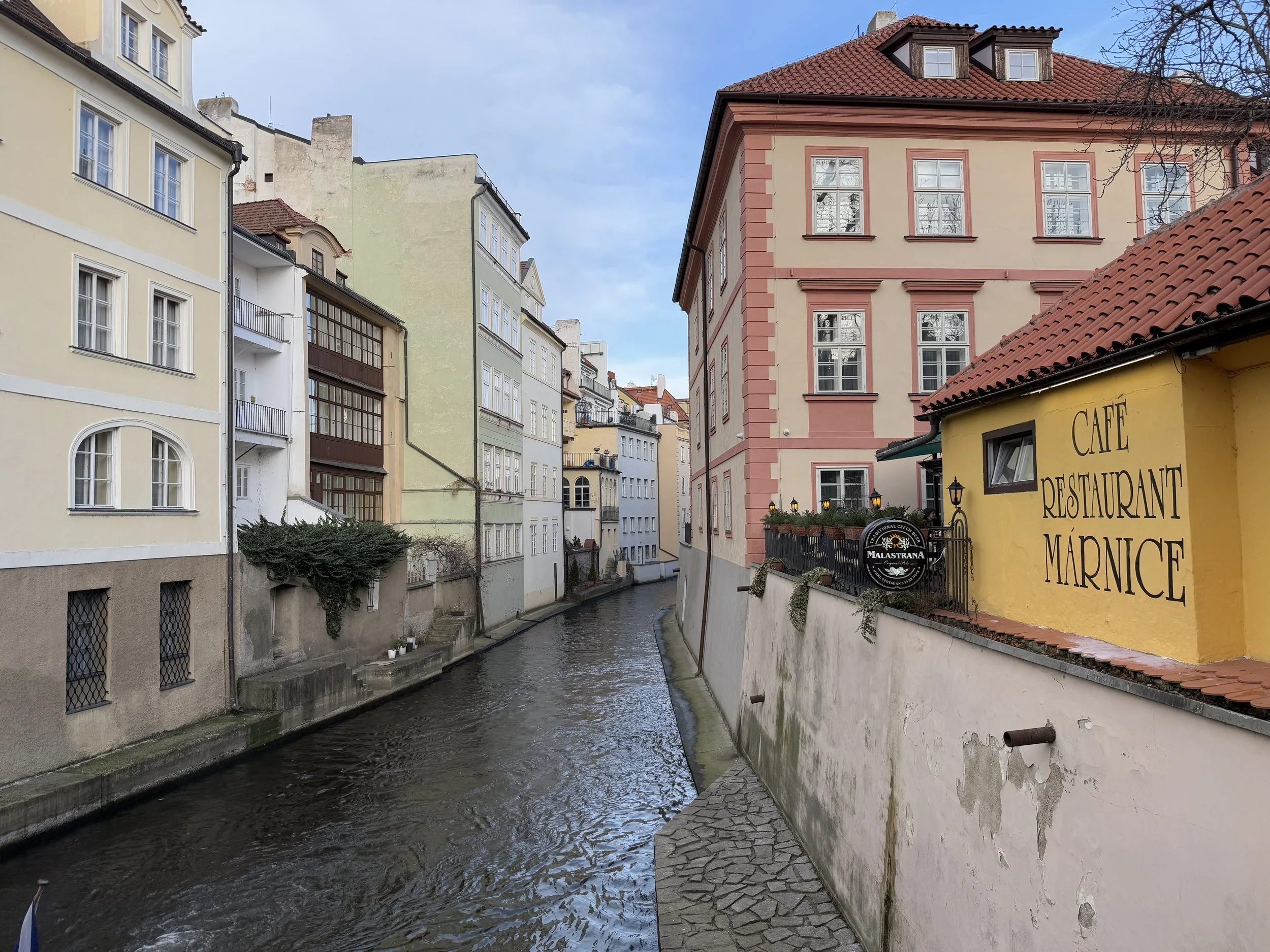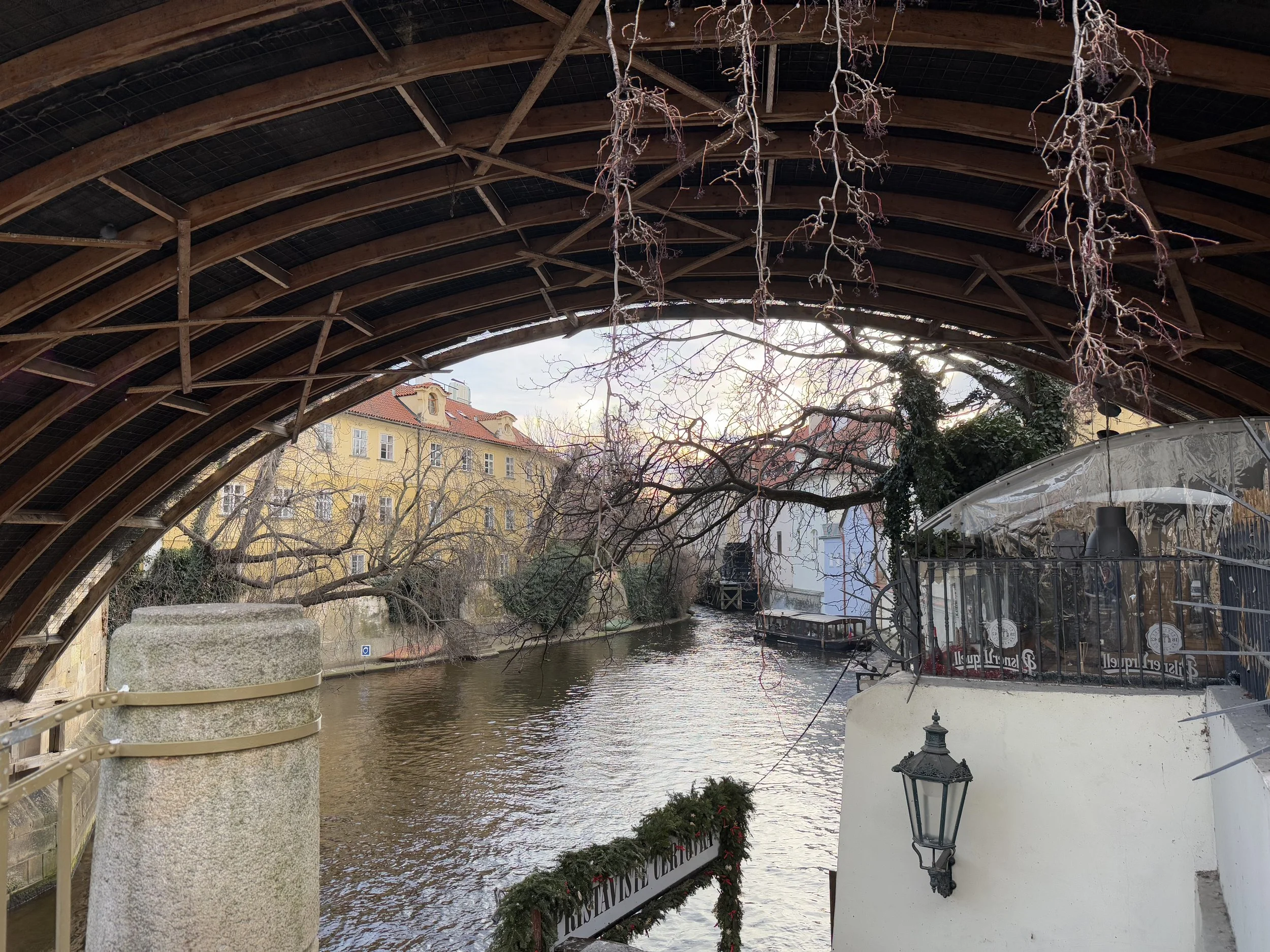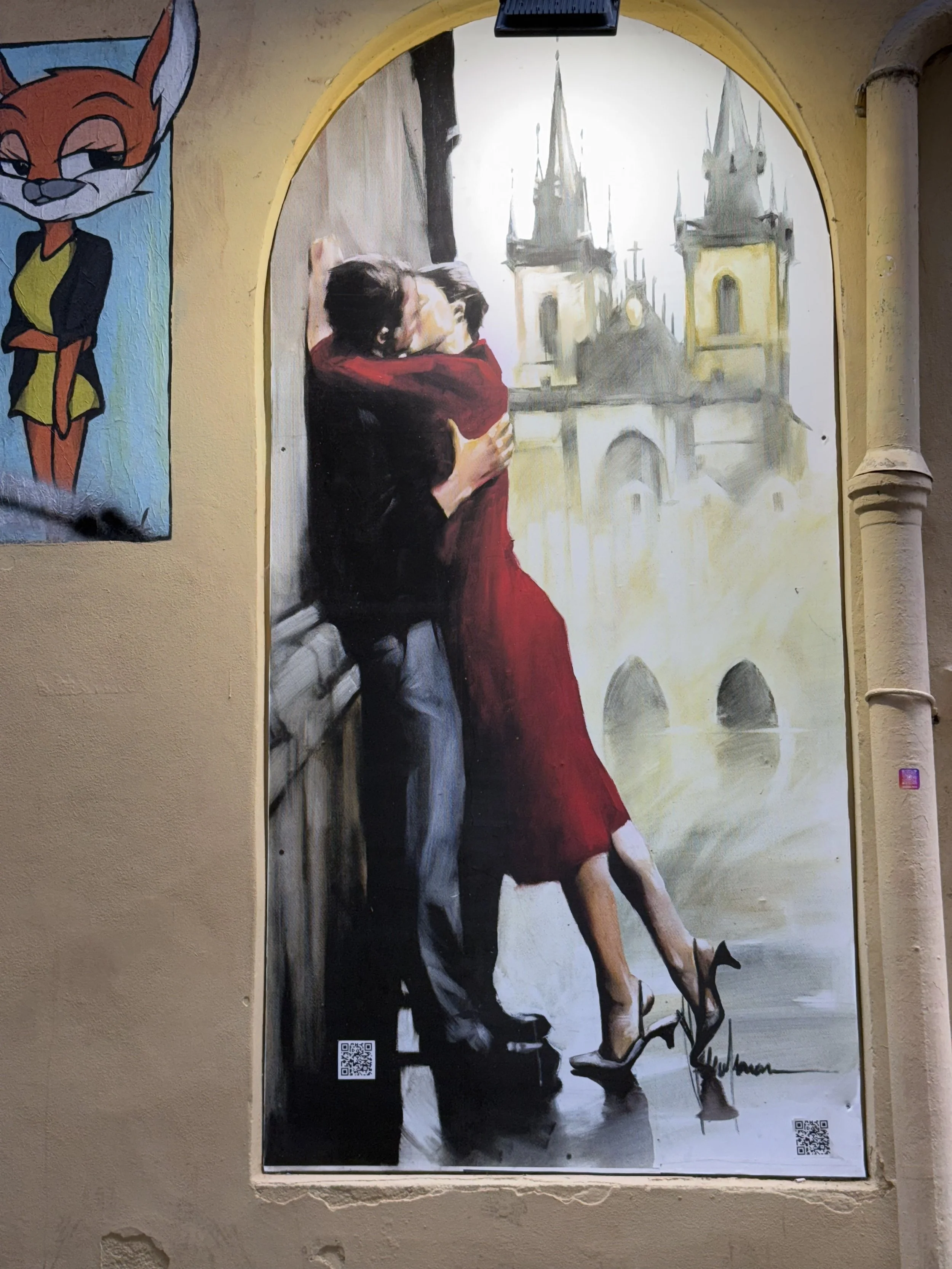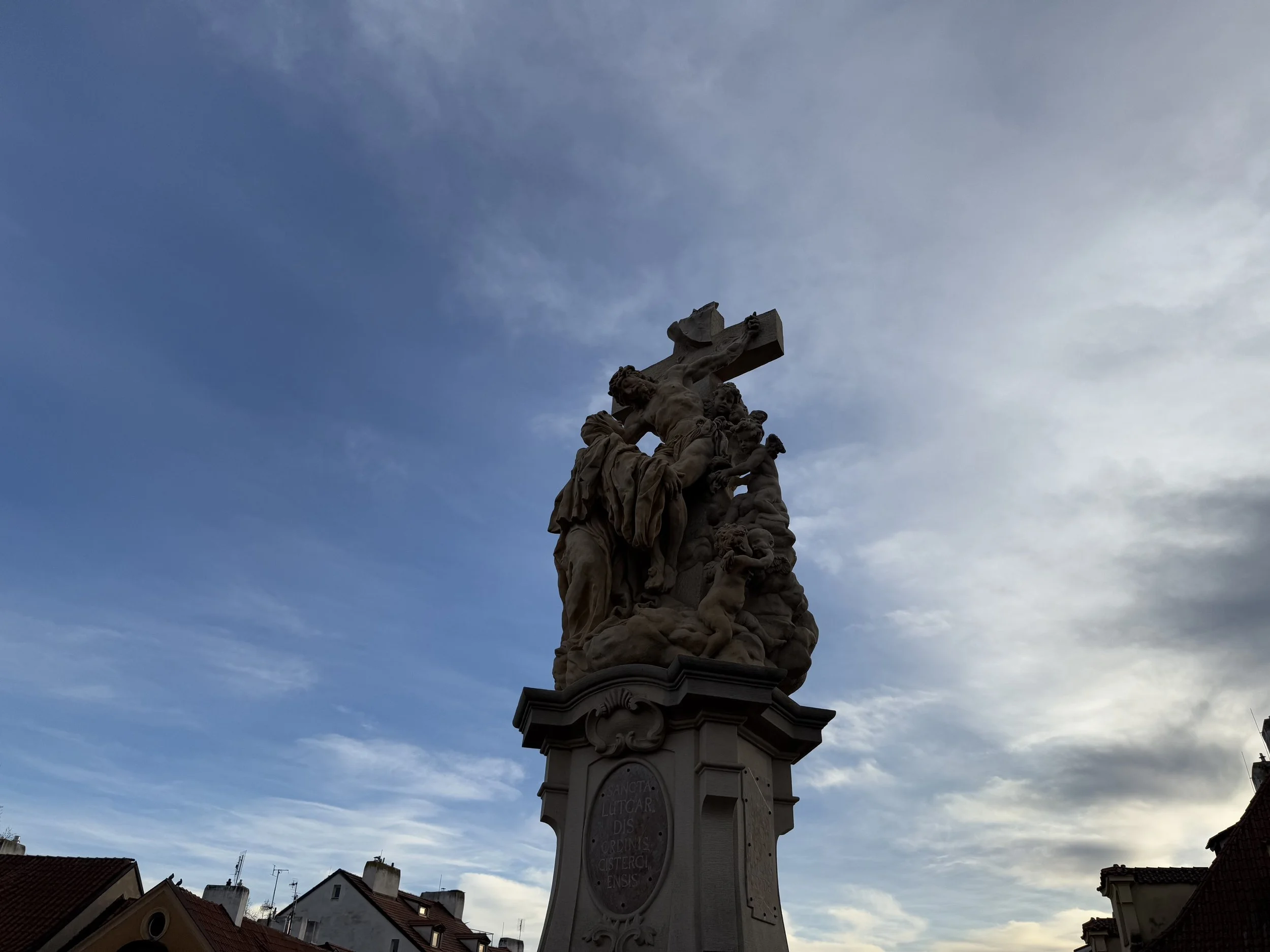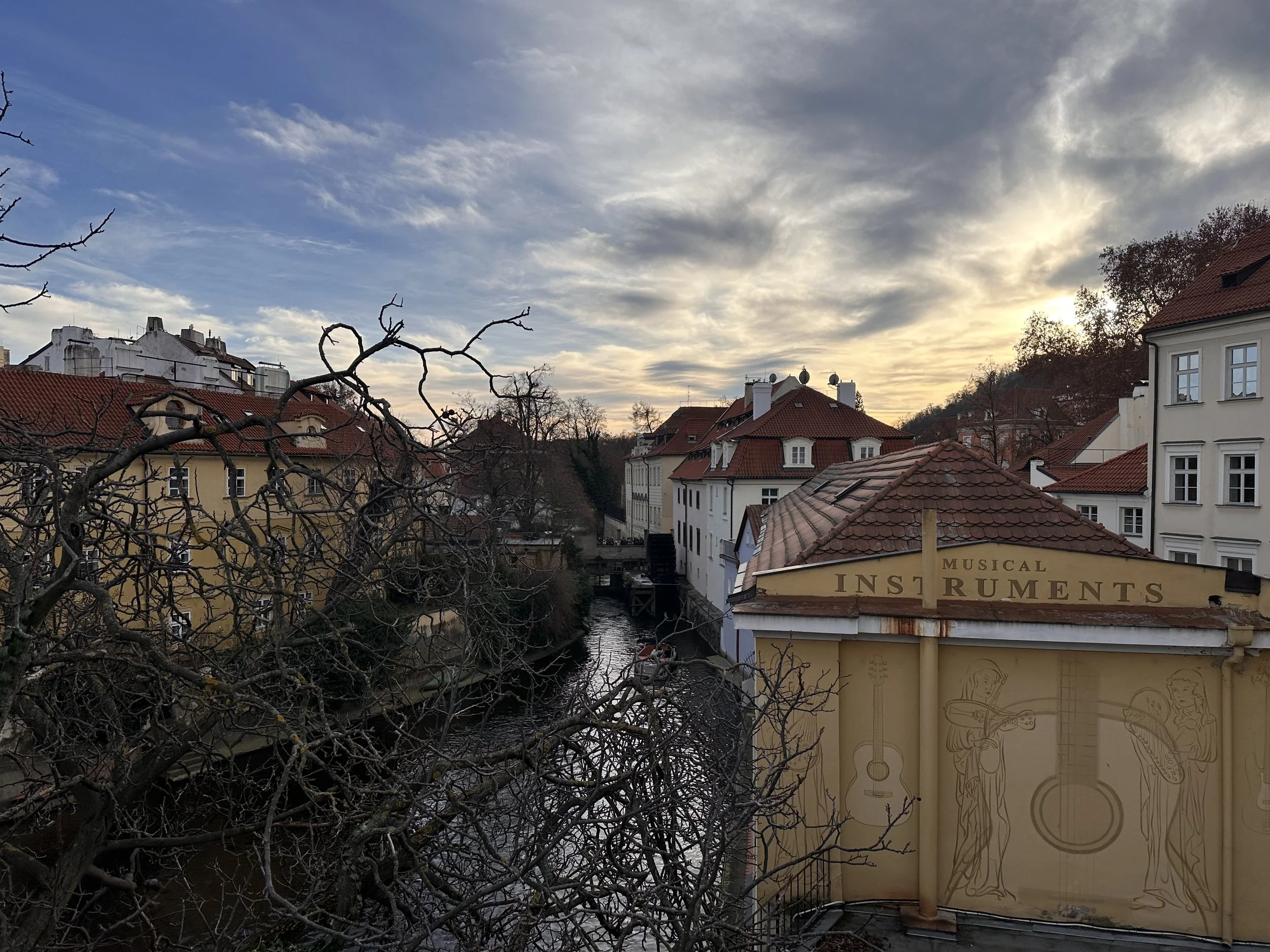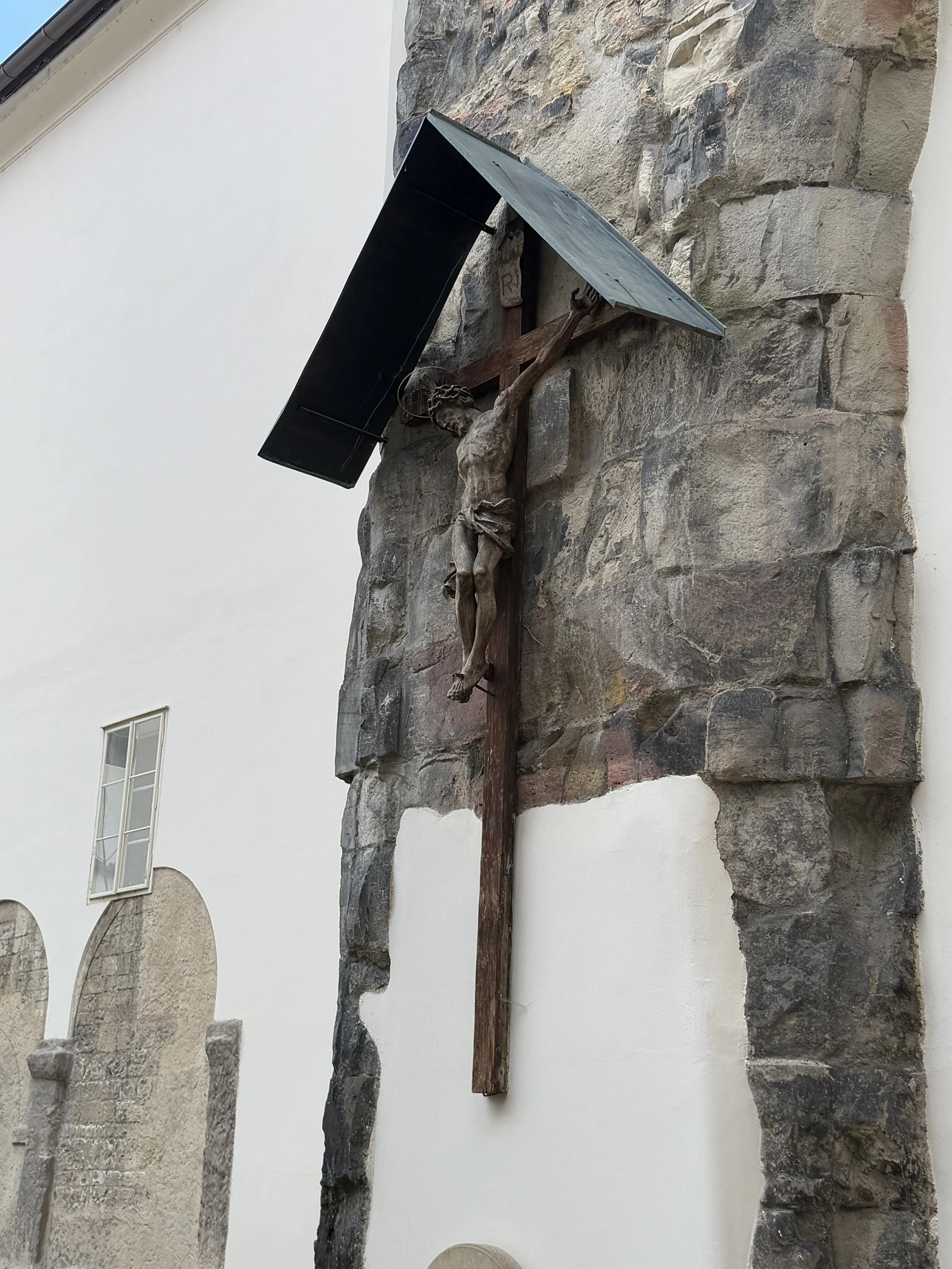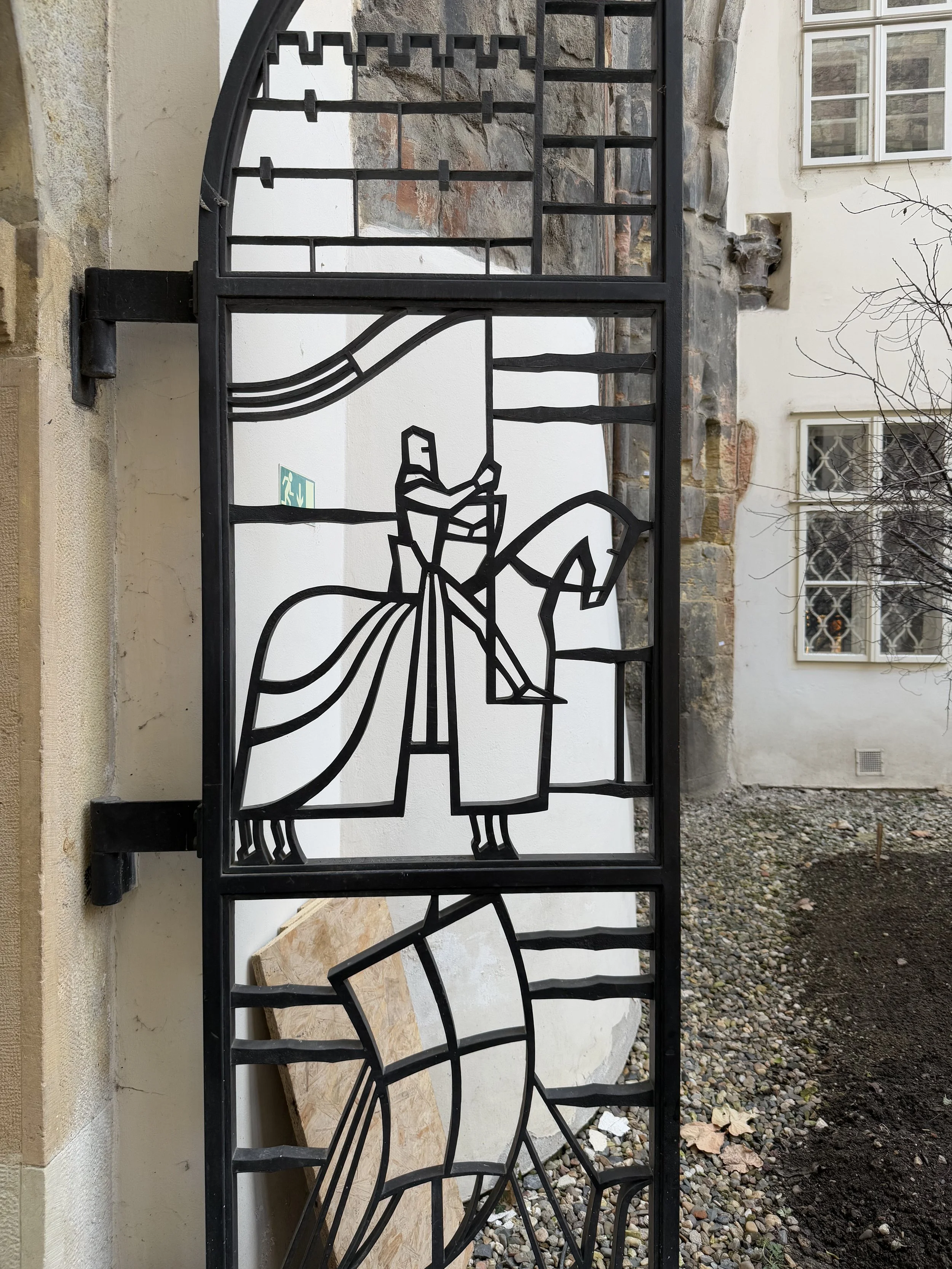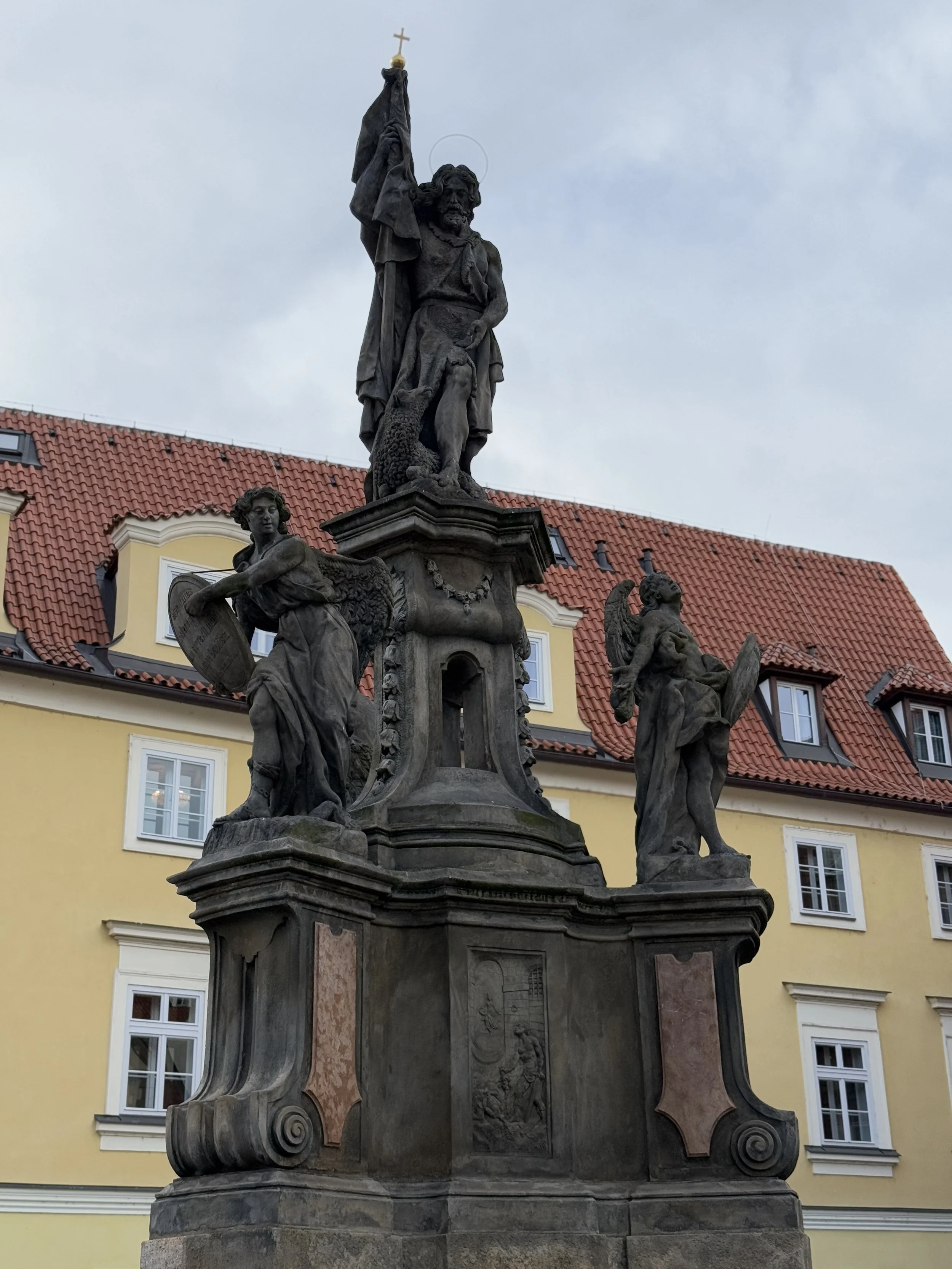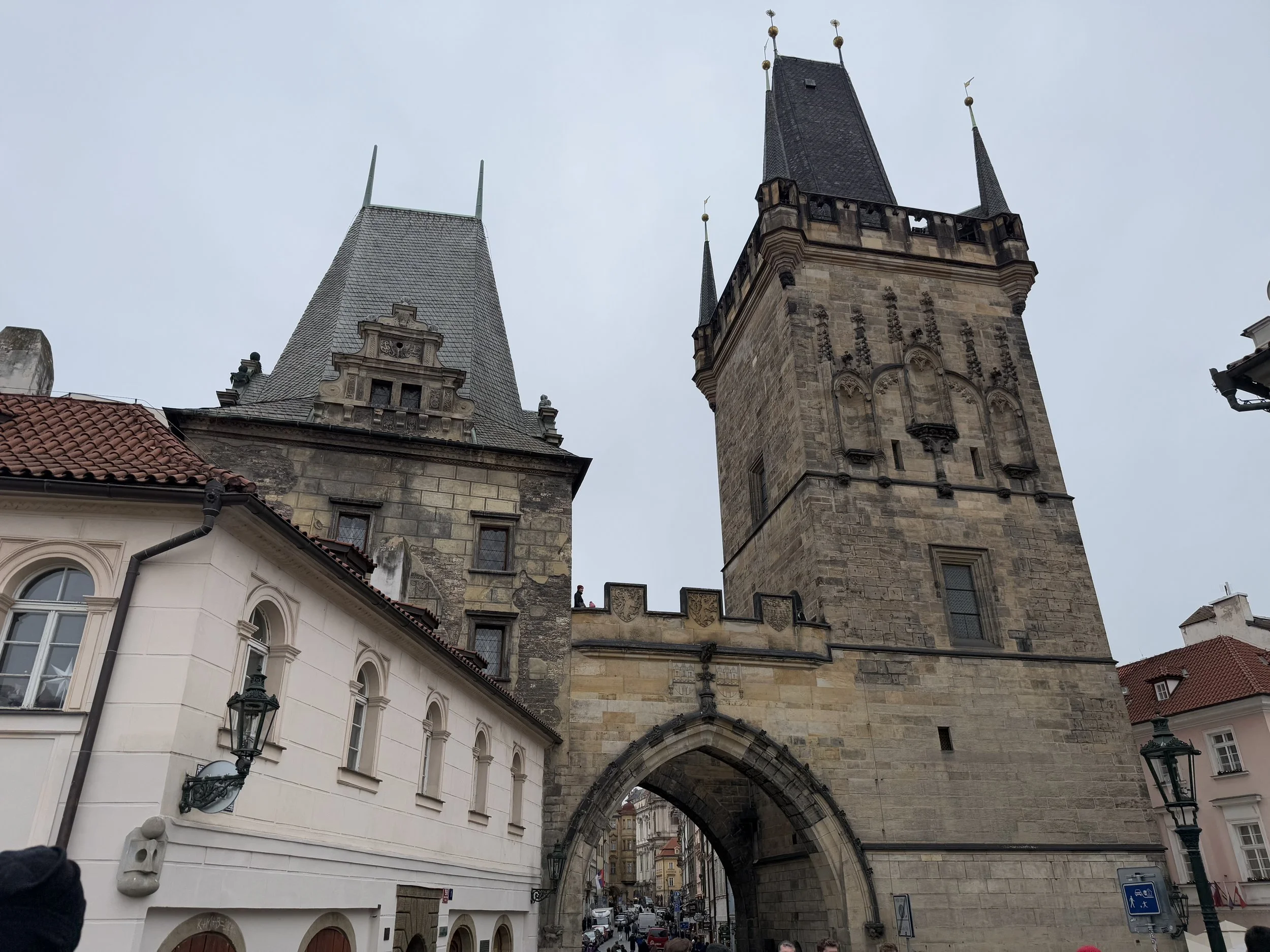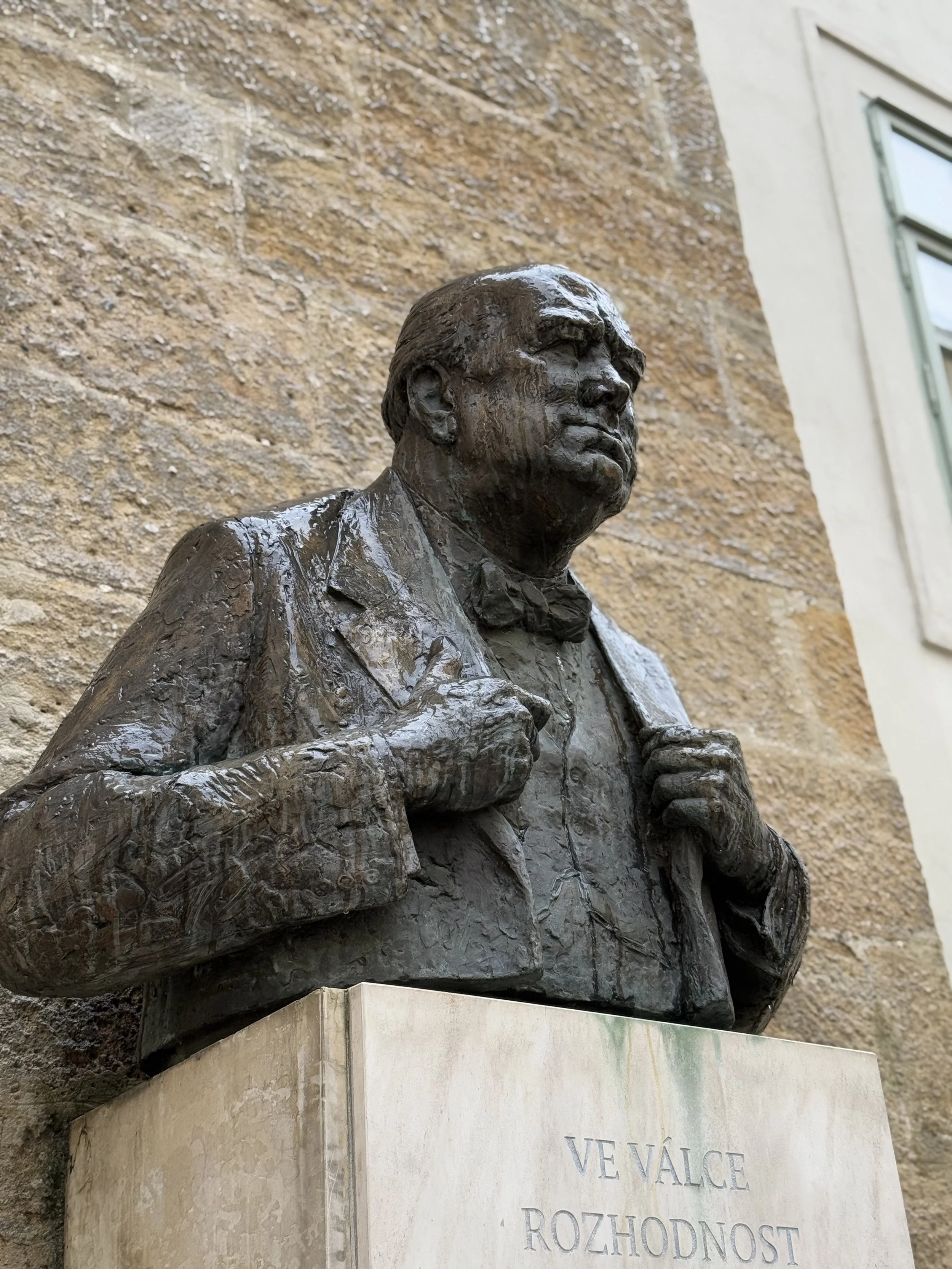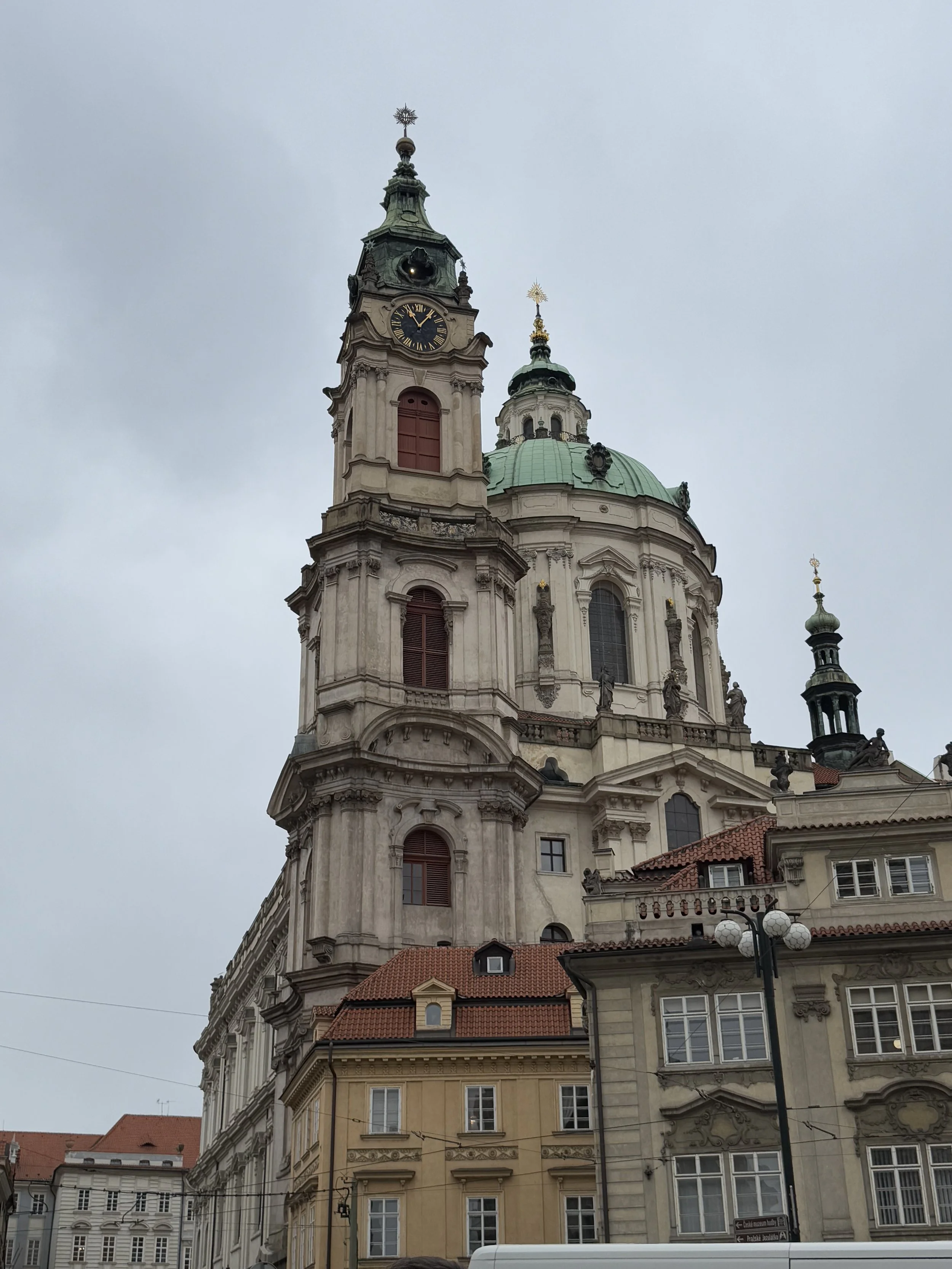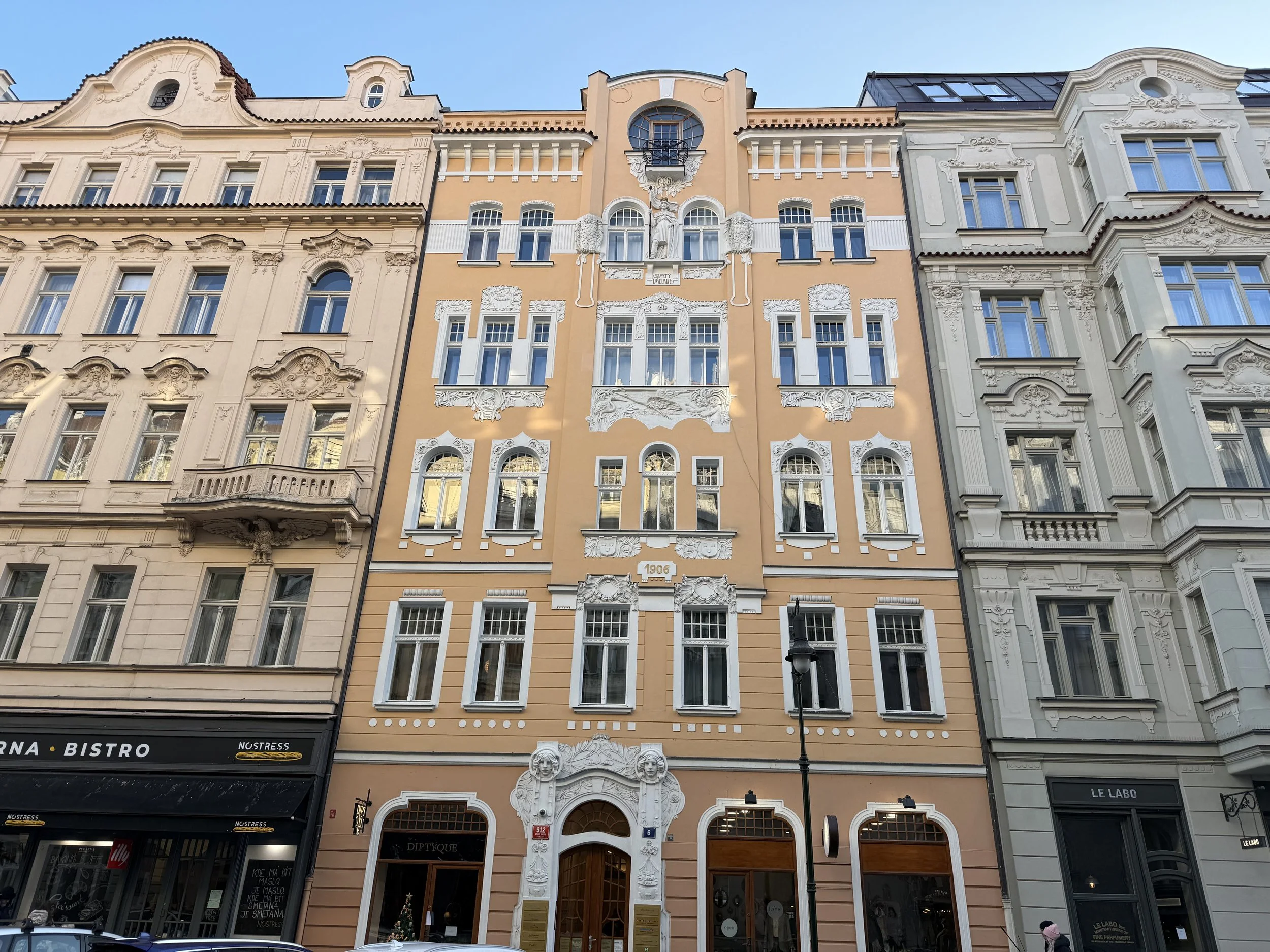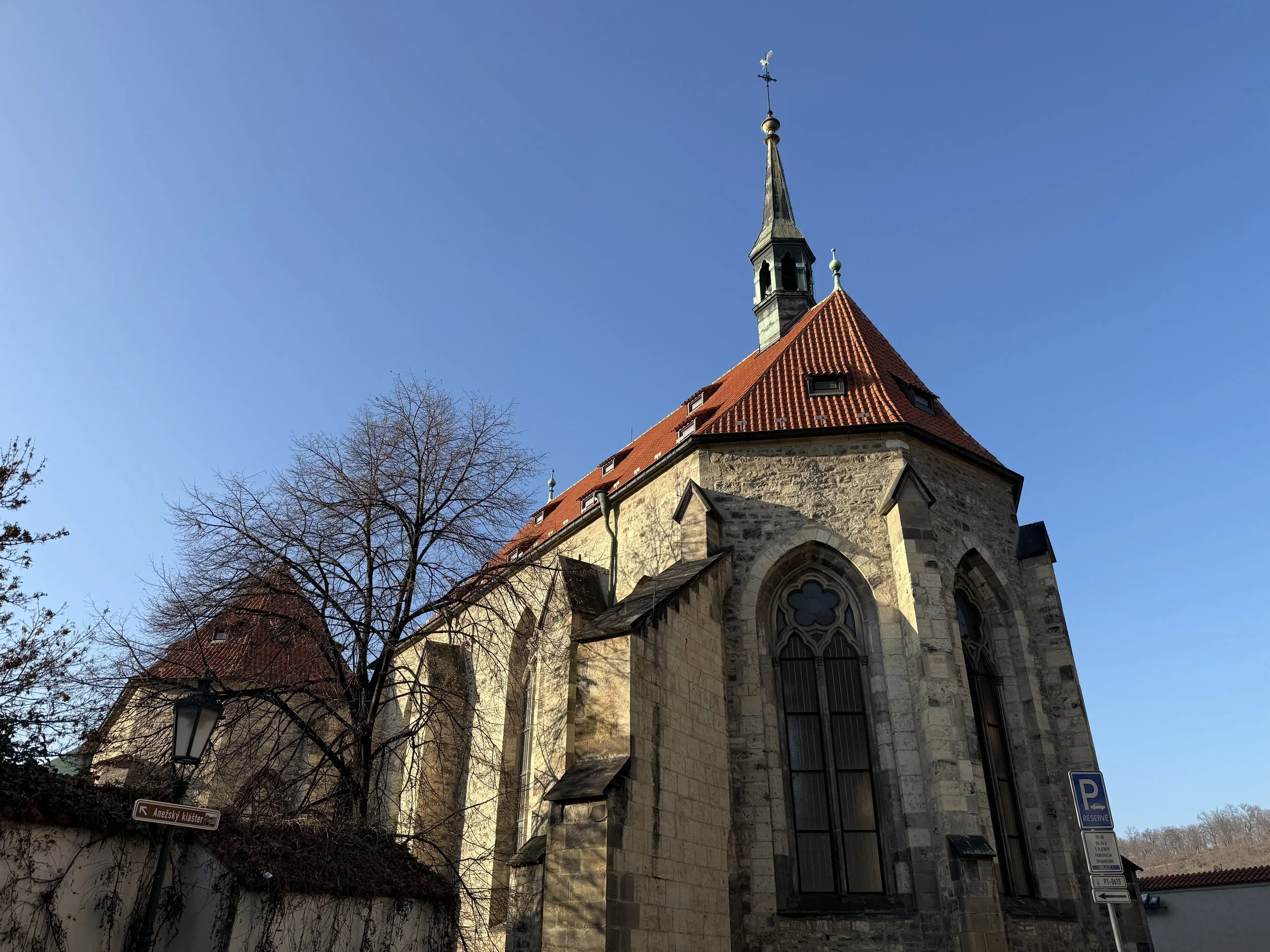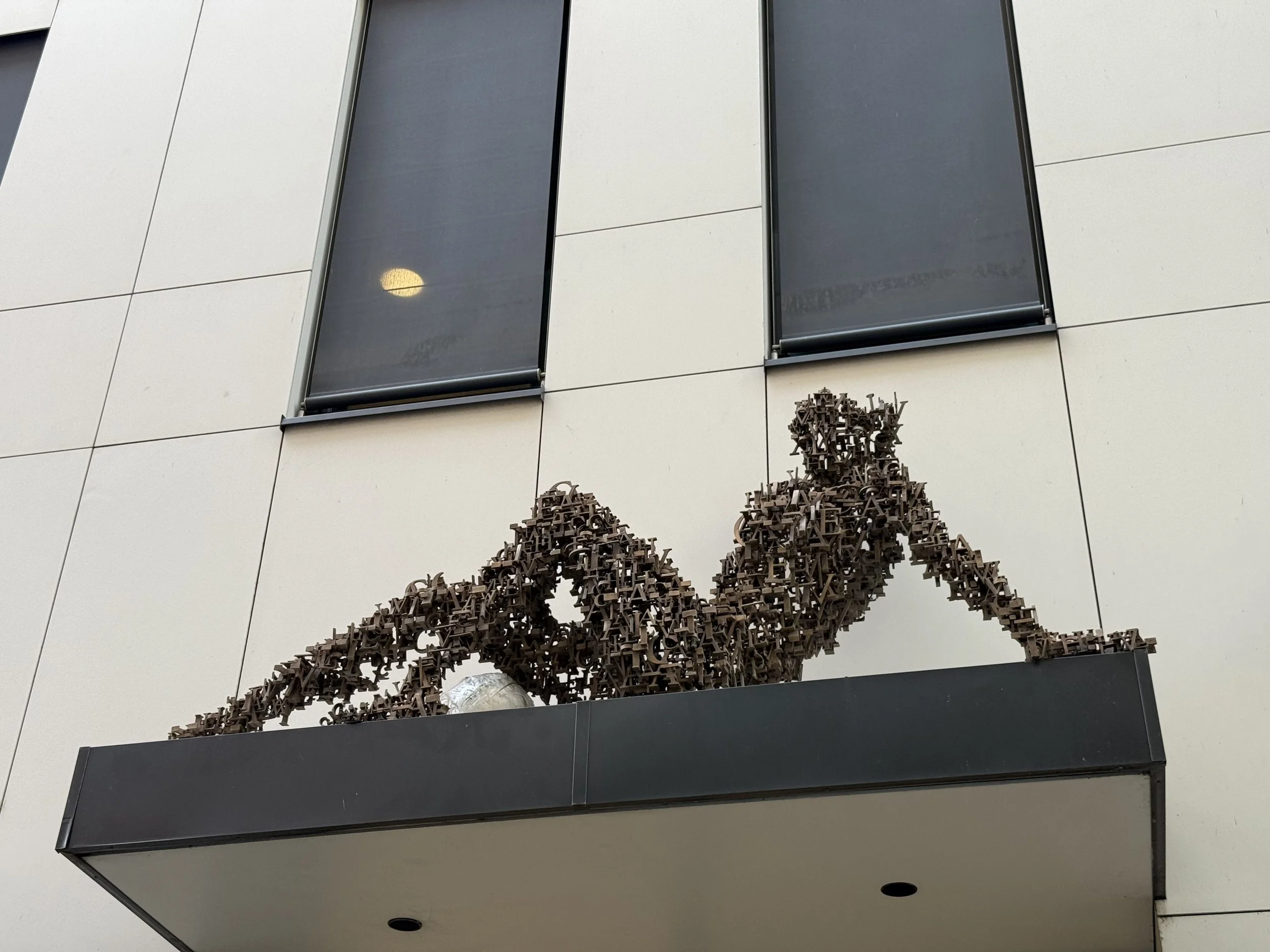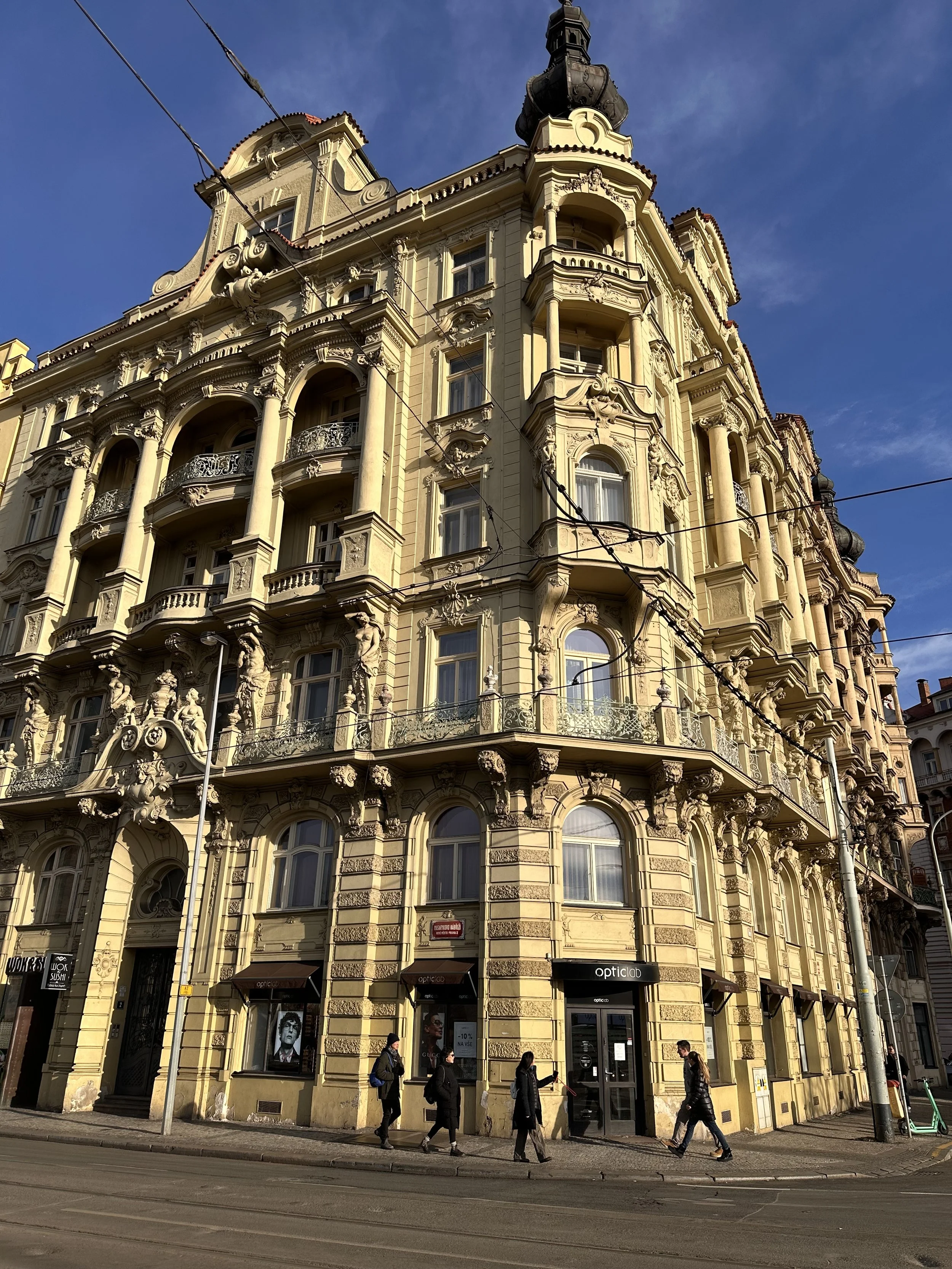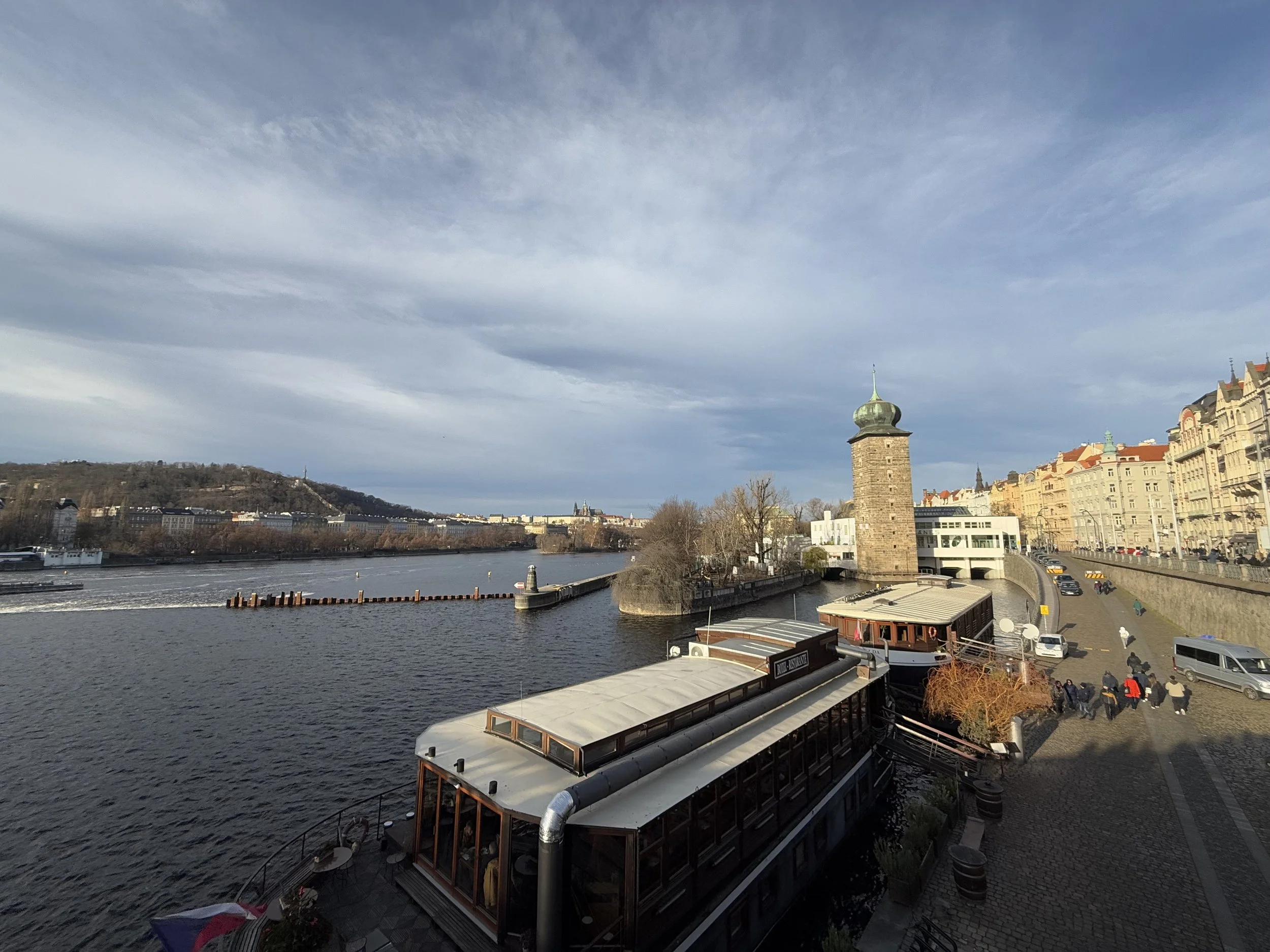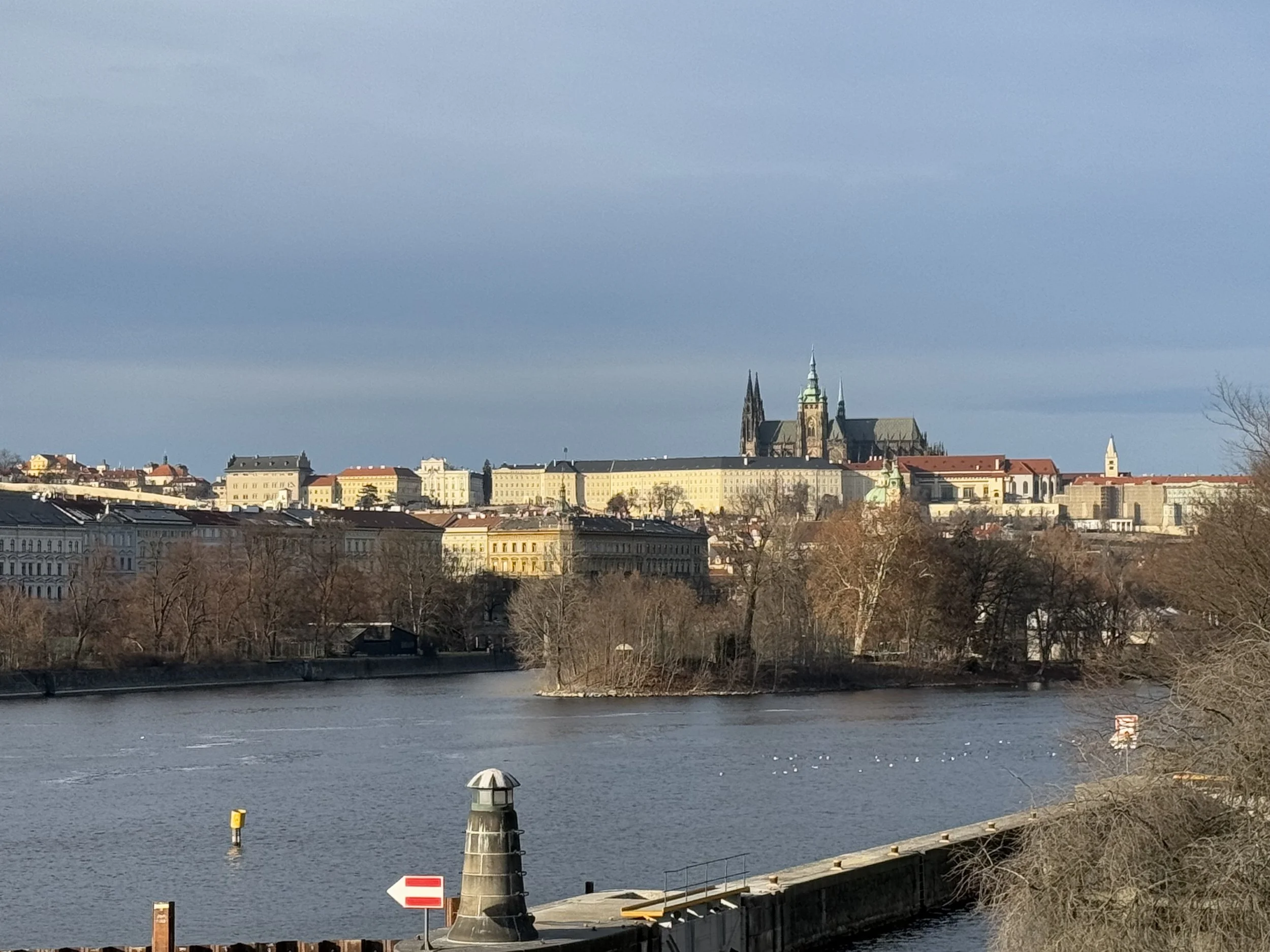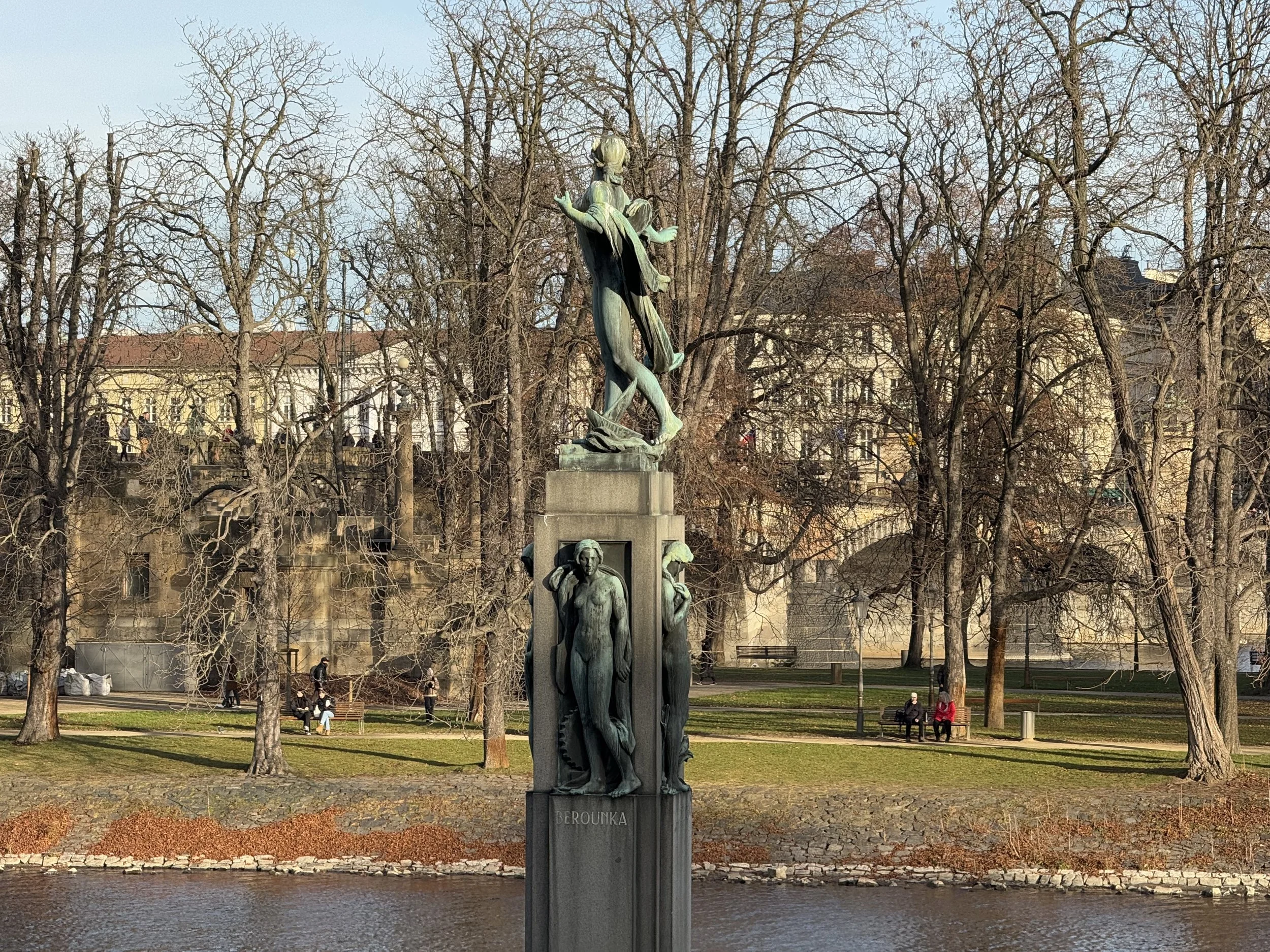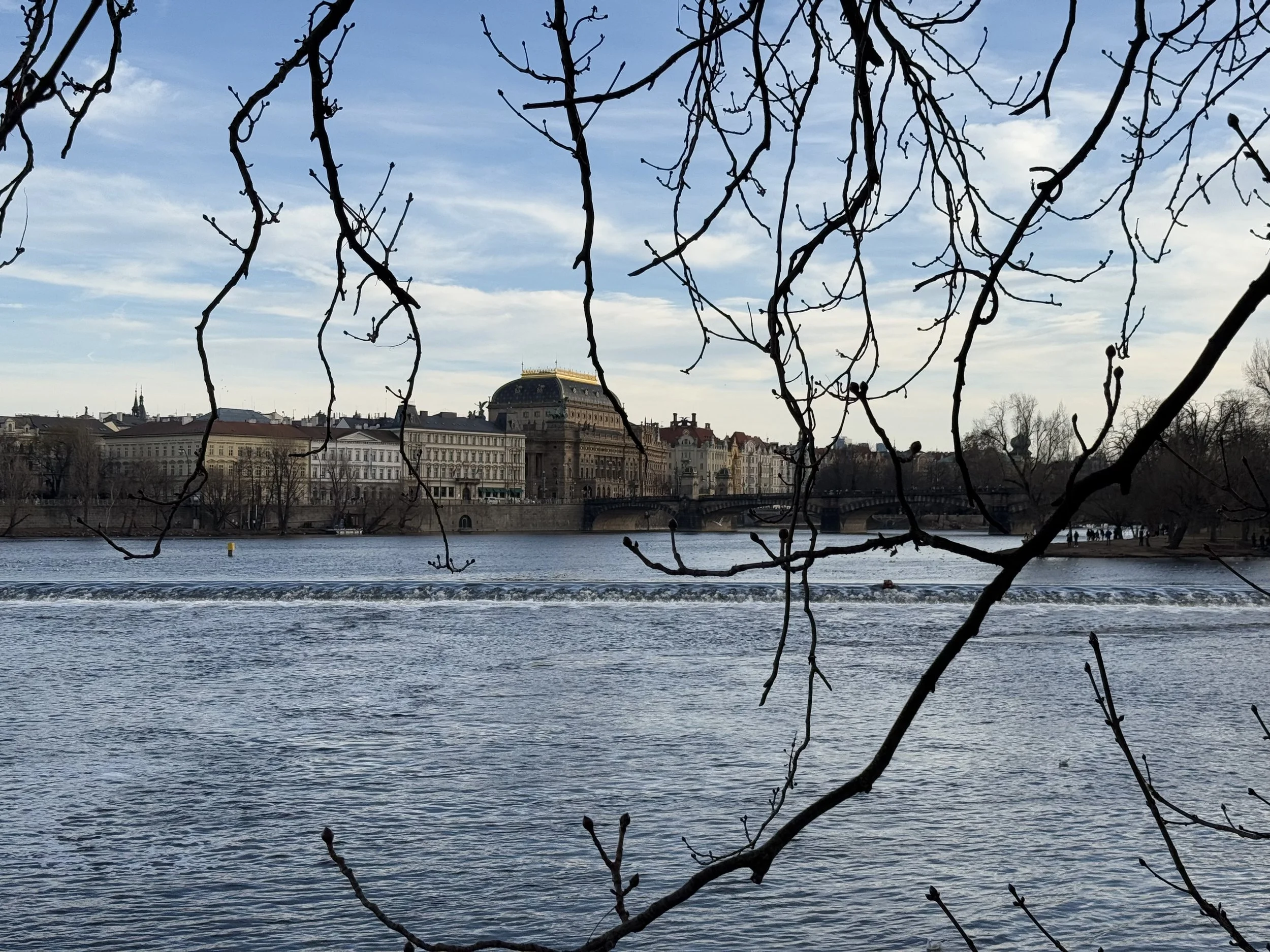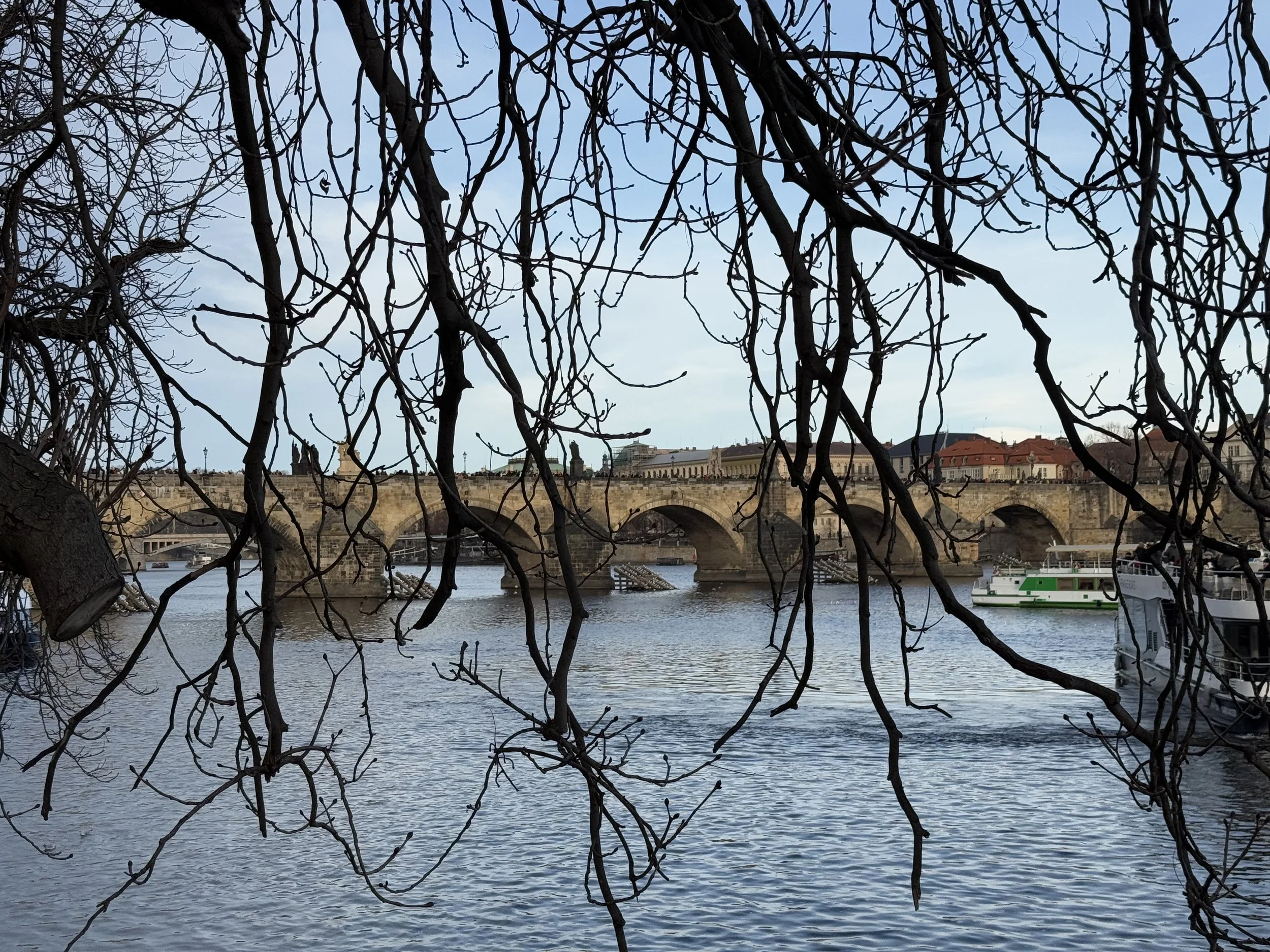Exploring Prague, Cezch Republic
How many nights needed in this city: 3-4 nights
Prague is a city of beauty. Everywhere you look, preserved baroque architecture beautifully blends with medieval history. Granite mosaic-paved sidewalks meet cobblestone streets. Gothic churches tower over luxurious apartments and stores. And, let’s not forget the infamous Charles Bridge, which literally connects these two worlds.
In the four nights we had in Prague, we not only saw it “all”, but also rang in the New Year at the Christmas markets - something we highly recommend.
The below information is a complete guide of the best places to stay, the top rated places to dine and drink, and all there is to see and do. We’ve also included transportation tips, as well as a summary of the history of this incredible city!
Jump To:
Where to Stay
The Old Town Square & Parizska Apartments (Top-rated)
Nestled in the most “luxurious street in Prague”, which is just across from the Old Town Square, is the historical Parizska Apartments.
From the moment you walk through the heavy wooden door, you realize you’re not just entering the building to your temporary home, you’re also stepping into a time machine, walking on original tile from 1902. When you enter into your apartment (we had the Parizska apartment), you see how elegantly blended historical aspects of the apartment are (the wooden floors for one) with the more modern conveniences that make it comfortable.
Since we were staying there over New Year’s, it was the perfect location to celebrate from the large windows overlooking the street, as well as the square!
We highly recommend these apartments to anyone looking to be somewhat away from the usual touristy crowds, while also being close to so much!
Other recommendations
Where to Dine & Drink
Nové Město
Bassotto
A 100% gluten free eatery in Prague new town. They offer pizzas and more. Lactose free and vegan also avaliable.
Ekant Indian Restaurant
Serving Indian dishes.
My Raw Cafe
The perfect 100% gluten free and vegan breakfast spot in Prague. You can grab anything from crepes to acai bowls.
Next Door by Imperial
Elegant dining room featuring an open kitchen turning out international, high-end plates.
Portfolio
They place emphasis on the best-quality raw ingredients and focus even more than before on supporting local farmers. They tend to lean towards seafood-based dishes.
Pytloun Skybar & Lounge
Serving a large menu of grilled items, both meat and seafood, as well as cocktails, on a rooftop overlooking the old city.
Vallmo Restaurant
Country-chic venue offering carefully sourced, high-end dishes, plus vegan options.
Prague 1
Alcron
Contemporary restaurant serving innovative, plant-forward food using underappreciated ingredients.
George Prime Steak
Per their site, “George Prime Steak is the premier, quintessential American-style steakhouse located in the heart of Prague’s Old Town neighborhood. Our mission is to serve up the perfect prime steak every time. From the selection of the highest quality beef to the way we present the final steak to you, we aim to make our steakhouse one of the best.”
Restaurant Alma
Every ingredient used is from local, sustainable, organic farms or is grown by them. They are also a zero-waste restaurant.
Restaurant Mlýnec
Contemporary Czech restaurant with a stylish feel, large windows & live jazz evenings.
Prague 2
Bassotto
A cozy gluten-free bakery with a wine bar in the center of Prague.
Bilá Krava
Per their site, “We will transport you to the friendly atmosphere of the French countryside. You will taste steaks made from aged beef from Czech breeders, lamb from our farm in Myštěvs and fruit spirits from our Radlík Distillery.”
Danu Restaurant & Wine Cellar
A wine restaurant focused on central European foods and wine.
Mezi Srnky
A small breakfast menu with gluten free bread available.
Staré Město
A dedicated gluten-free Italian restaurant.
Babiccina Spiz
A dedicated gluten-free bakery.
Field
A Michelin-starred restaurant serving upscale, creative cuisine & a wide variety of wines, served in a polished atmosphere.
Hemingway Bar
La Degustation
A Michelin-starred restaurant with a modern menu, inspired by dishes from 19th-century Czech cuisine.
La Veranda
Colorful restaurant & bar sourcing its ingredients from as close to the city as possible.
Mediterranean Restaurant & Bistro Antonio Sandev
A cute little shop and eatery with a medetarranian twist. Gluten free, vegetarian and vegan options avaliable.
The Alchemist
Elegant, light-filled venue featuring a carved wood bar & plush seating offering classic cocktails.
V Zátiší
Global fine-dining cuisine served in a luxurious restaurant with striking decor.
Venue
There are several gluten free and vegan brunch options here, which are clearly marked on the menu. Great reviews online too.
Other Areas
Cukrárna Buchta (Prague 6)
Another 100% gluten free bakery with everything you could need. The reviews are exceptional.
Dejvická 34 (Prague 6)
A Michelin-starred restaurant serving a mix of Czech and Italian dishes, showcasing some top quality imported ingredients.
Grand Cru (Petrská čtvrť)
Per their site, “Experience a symphony of taste in the paradise of experiential gastronomy. Chef Svatopluk Hemmer prepares menus here with love for detail and quality ingredients. The restaurant, set in an elegant and pleasant environment with a relaxed atmosphere, is an ideal place for evenings with friends or business partners. All of this is complemented by an exceptional wine cellar, from which everyone can truly choose.”
La Farma (Vinohrady)
Per their site, “The name La Farma is closely related to the farmer, but we also sneaked the foreign language member La into the name, as our cuisine is not orthodox Czech, but the menu also includes dishes from international cuisine. If we leave out the foreign language translation, it can sound like La - playful, light, relaxed... and that's exactly what La Farma is.”
Prague to Detenice Medieval Castle, Brewery and Dinner Experience
Welcome to Dětenice, where the Middle Ages come to life! Join us for an unforgettable experience filled with history, flavors, and adventure. Discover the charm of the Baroque Castle and visit the Local Brewery, brewing beer since 1307 and taste homemade beer. End your day at the medieval tavern with unlimited consumption of local beer and wine, complemented by an authentic medieval dinner. Let yourself be enchanted by live period music, artist performances, and a fire show. Don't miss this unique opportunity to experience the Middle Ages in all their splendor.
St. Martin (Malá Strana)
An inexpensive restaurant in the heart of Prague centre, which caters for gluten free and vegetarian options. They have both a traditional and international menu.
Terasa U Zlaté studně (Malá Strana)
16th-century building with views over the city's rooftops hosting an upscale fine-dining restaurant.
The Eatery
Upscale choice highlighting seasonal fare & refined dishes in a chic setup with an open kitchen.
Things to See & Do
Day Trips
Cesky Krumlov Private Tour from Prague
Skip the hassle of public transport on this private guided tour from Prague to Český Krumlov, exclusively for you and your party. Get picked up from your Prague hotel and head into southern Bohemia, making a stop in Česke Budejovice, home of the original Budweiser beer, before arriving in Český Krumlov. Feel free customize the tour to your preferences as you explore the hilly cobblestoned streets of the town, a UNESCO World Heritage Site, with your guide.
Bohemian and Saxon Switzerland National Park Day Trip
Immerse yourself in the nature of Northern Bohemia on this day trip to Bohemian Switzerland National Park. This small-group tour takes you north of Prague to the border of the Czech Republic and Germany and puts you smack in the middle of Central Europe's most beautiful landscapes. When booking, choose from multiple tour trail options, including one that lets you sail on a gondola-style boat down the river and walk along the Elbe River.
Half-Day Tour From Prague To Terezín Concentration Camp
See Czechoslovakia’s tragic holocaust history firsthand on a 5-hour, guided tour of Terezín that includes round-trip transport from your Prague hotel by limousine. Visit the site with a local guide for a personalized experience, as you take in the Small Fortress, the Big Fortress, the Ghetto Museum, and other Terezín sites.
Karlštejn Castle and Koneprusy Caves Tour
Breaking out from Prague to experience Bohemia’s scenery and culture independently involves arranging your own transport and tickets. This day trip eliminates the time and effort: with a minivan whisking you to the stalactite- and stalagmite-filled Koněprusy Caves, flooded Big America Canyon, and a Bohemian tavern for lunch and beer, and visit Karlstjen Castle.
Kutna Hora Private day trip
Experience the UNESCO World Heritage-listed attractions of Kutna Hora in the company of a dedicated guide on this private tour from Prague. Between pickup and drop-off, everything is taken care of for you in advance, including most entrance fees and lunch.
The Best Of Saxon Switzerland From Prague: Bastei Bridge & Dresden City
Combine nature, culture, and history on this guided tour from Prague to Saxon Switzerland National Park and Dresden. Admire the hilly peaks of Saxon Switzerland around the Elbe valley southeast of Dresden in Saxony, Germany, then discover the most important landmarks in Dresden, including the Royal Palace, the Zwinger Old Master Gallery, and the Frauenkirche (Church of the Virgin Mary).
Winery Tour
Prague has a history of winemaking dating back to medieval times but many travelers don’t realize that there are still vineyards in the city. On this private tour, you'll visit local vineyards and wine cellars, will learn all about the winemaking process, and will sample a selection of regional wines. Hotel pickup and private transfers are included, so you can enjoy wine tasting without having to worry about transport.
Historical Exploration
Clementinum & Baroque library
Clementinum’s history dates from the existence of a chapel, dedicated to Saint Clement, in the 11th century. A Dominican monastery was founded in the medieval period, which was transformed in 1556 to a Jesuit college. In 1622, the Jesuits transferred the library of Charles University to the Clementinum, and the college was merged with the University in 1654. The Jesuits remained until their suppression in 1773, when the Clementinum was established as an observatory, library, and university by the Empress Maria Theresa of Austria.
The National Library was founded in 1781 and from 1782, the Clementinum was a legal deposit library. In 1918, the newly established Czecho-Slovak state took over the library. Since 1990, it has been the National Library. It is the second largest complex of buildings, next to Prague Castle.
Medieval Underground Tour
Go underground and explore the fascinating dungeons and chambers of the medieval city. Listen to chilling tales of executions and freedom struggles, and learn more about Prague than you would wandering around by yourself.
Municipal House
Opened in 1912, Obecní dům (Municipal House) stands on the site of the former Royal Court Palace, the King’s residence between 1383 and 1485. In 1918, it was the site of the proclamation of the new independent state of Czechoslovakia. Today, it houses a concert venue, three restaurants, the oldest bar in Prague, and some of the most beautiful art nouveau architecture around. It also frequently hosts exhibits such as pieces from Museum of Decorative Art.
Museum of Communism
A museum dedicated to presenting an account of the post–World War II communist regime in Czechoslovakia, with a focus on Prague.
Nuclear Bunker Museum
Uncover Prague's communist history on this small-group tour that combines a walk through the city with visits to important sites. You'll visit the StB Holding Cells, a former secret police building; the Velvet Revolution Memorial, and a nuclear bunker hidden underground, all while learning about Prague's Soviet era.
Old Town Square
The Old Town Square was founded in the 12th century as the central marketplace for Prague.
Over the centuries since, on the instruction of kings, wealthy merchants and the Church, grand buildings of Romanesque, Gothic and Baroque styles were erected around the marketplace. Below the square, dungeons were built to house prisoners - a labyrinth of chambers and tunnels that beared witness to the dark stories of political intrigue and treachery associated with the square.
Built in the 14th century, the astronomical clock (Pražský orloj) is a complicated mechanism that shows several different versions of time. At the top of every hour, the clock puts on a brief show: a skeleton rings his bell, twelve apostles walk by, a rooster crows, and then the clock chimes. It has had to be modified, destroyed, and repaired numerous times since its “birth”.
NOTE: Legend has it that the builder, Mikuláš from Kadaň, was treated poorly during this process and broke the clock while also ending his life. They believe the clock is cursed and anyone that has tried to fix it has experienced similar fates (insanity or death).
The Prague Christmas Markets are open daily at the Old Town Square and Wenceslas Square. A 'winter wonderland' awaits, for visitors to soak up the festive atmosphere, browse the stalls for hand-crafted goods, and enjoy Christmas carols, hearty food, and local drinks.
While many stalls accept cards, others prefer cash, both in CZ and EU denominations.
TIP: We came here for New Year’s and it certainly didn’t disappoint. Bands and DJs filled the square with music, the food and drink stalls were aplenty… and so were the illegal fireworks.
The Old Town Hall dates back to 1338, when it became the seat of the administration of the Old Town of Prague. Inside, a number of historical interiors have retained their original appearance to this day, inlcuding the Old Council Hall from the early 15th century, which is one of the most picturesque Gothic interiors in Europe. The complex of medieval cellars, which is located under the Old Town Hall, is even older than the town hall itself – its Romanesque part is a beautiful work of 12th century architecture.
An elevator takes you most of the way to the top, making this the easiest tower to visit in Prague. The next portion of the “climb” can be done with another short elevator ride or a 5-minute walk up a large, spiraling ramp. Then, it is one final climb up a narrow, metal spiral staircase. Your reward: 360° views of Prague.
From 1652 to 1918, the city used a shadow cast by a Marian column that fell directly upon the meridian of 14°25’17″ East each day to tell high noon. The the meridian column is gone (it was torn down by a mob in 1918), the time strip in the stones is still there.
Since the 14th century, Týn Church has been the church for this part of the city, though wasn’t fully completed until 1511. It was controlled by the Hussites for 200 years until 1620 when recatholicization started. Since the 1880s, it has gone through periods of renovation.
NOTE: You are not allowed to take pictures inside, though the word is, it’s best viewed from the outside anyway.
Olšany Cemetery
In the 17th century, it was considered unhygienic to bury the corpses of plague victims within city limits, so a large cemetery was designated in 1680 for this very purpose. When plague struck again a century later, Emperor Joseph II enacted a series of hygiene reforms and Olšany became the city’s official cemetery. It was continually used up until the 20th century, when a number of elaborate art nouveau grave monuments made the cemetery a place for sightseers, not just mourners.
FUN FACT: Olšany Cemetery is the largest in Prague and one of the largest in Czechia. It is said that over 2 million people are buried here in over 60,000 grave sites.
Petrin Tower
The Petřín Lookout Tower is a steel-framework, 208 ft.-tall tower on Petřín Hill in Prague, built in 1891. It resembles the Eiffel Tower and was used as an observation tower, as well as a transmission tower. Today, it is a major tourist attraction.
NOTE: You can take a funicular ride up Petrin Hill or climb 299 slightly wobbly wooden steps to the top.
From the outside, this building resembles a small castle but inside, it’s a labyrinth made of mirrors. First, you'll make your way through the maze to the diorama of the battle of the Praguers against the Swedes at the Charles Bridge, in 1648, then through the "hall of laughter" where warped and twisted mirrors will change your appearance in crazy ways.
An astronomical observatory on Petřín Hill, in the center of Prague, founded in 1928 and named after Slovak astronomer, Milan Rastislav Štefánik. Nowadays, the observatory specializes in astronomy and related natural sciences.
PRague Castle
Built in the 9th century, Prague Castle has long served as the seat of power for kings of Bohemia, Holy Roman emperors, and presidents of Czechoslovakia. As such, the term "Prague Castle" or simply the "Castle" or "the Hrad" are often used as metonymy for the president and his staff and advisors. The Bohemian Crown Jewels are kept within a hidden room inside it.
According to the Guinness Book of Records, Prague Castle is the largest ancient castle in the world, occupying an area of almost 750,000 sq. ft. The castle is among the most visited tourist attractions in Prague, attracting over 1.8 million visitors annually.
All Saints' Church is a chapel located in the Prague Castle and was originally consecrated in 1185 and a Romanesque building, built. The oldest parts of the building you can see today are from the 14th century.
Along the north side of the castle, there is a wild glen called Jelení příkop (the Deer Moat), originally part of the Castle’s fortification and later, a private hunting ground for the king. While the royal stock of stags (and even a few bears) is gone, the Deer Moat is now a public park, easily traversed, via stone steps, paved paths, swinging timber walkways, and a 275-foot pedestrian tunnel that runs underneath the famous Powder Bridge.
Lobokowicz Palance was built in the second half of the 16th century by the Czech nobleman, Jaroslav of Pernštejn and completed by his brother, Vratislav of Pernštejn, the chancellor of the Czech Kingdom. It was opened to the public for the first time on April 2, 2007 as the Lobkowicz Palace Museum. Set in 22 galleries, the museum displays a selection of pieces from the Lobkowicz Collections, including works by artists, such as Antonio Canaletto, Pieter Brueghel the Elder, Lucas Cranach the Elder, and Diego Velázquez, as well as decorative art, military and hunting paraphernalia, musical instruments, and original manuscripts and early prints of composers including Beethoven and Mozart.
The Lobkowicz Palace is the only privately owned building in the Prague Castle.
The Old Royal Palace’s history dates back to the 12th century and was designed in the Gothic and Renaissance styles. Its Vladislav Hall is used for inaugurations, which makes it the most important representative hall in the country. It is also home to a copy of the Czech crown.
Built between 1538 and 1560, Ferdinand I commissioned the Summer Palace for his wife, Anne Jagiellonica. The garden surrounding it was founded simultaneously with the palace.
Upon its completion, the palace was not regularly used until Rudolf II converted its first floor into an astronomical observatory and used the palace to accommodate his guests. After Rudolf II's death, the palace was again unused for over 30 years. Afterwards, it served as a military base for Swedish soldiers in the Thirty Years War. For over 100 years, an artillery laboratory was based on the grounds until the governor Karl, Count Chotek of Chotkow and Wognin, evicted the artillery. After that, it went through periods of reconstruction and became an exhibition hall.
Founded in 920, St. George's Basilica is the oldest surviving church building within Prague Castle. It was prominent during the time of Christianity. It wasn’t until the 1780s when Jospeh II disbanded the monastic orders, allowing the Army to take over, which caused the basilica to fall into heavy disrepair. It eventually was restored.
Around the year 925, Prince Wenceslas (Václav) founded a Romanesque rotunda, which after 1060, was converted into a basilica with three naves and two steeples. The importance of the church grew especially after the establishment of the Prague bishopric in 973 and the founding of the body of canons - the St. Vitus chapter, which later became an important cultural and administrative institution. In 1344, Charles IV began the construction of a Gothic cathedral. By the 16th century, is was finished with a Renaissance view gallery and a helmet. Later in the 18th century, the older helmet was replaced by a new dome. It was not until the latter half of the 19th century that the Union for the Completion of the Cathedral began the repair of the original part and the completion of the Cathedral in Neo-Gothic style. The church was solemnly consecrated in 1929. Its interior was subjected to adaptations even in later years.
Originally built in the 16th century to house Rudolf II's castle guards, Golden Lane takes its name from the goldsmiths that lived there in the 17th century.
Golden Lane consists of small houses, painted in bright colors in the 1950s. Many of the houses are now souvenir shops, and there is a museum of medieval armory within the former 14th-century fortification, accessible from Golden Lane.
There is a fee to access this portion of the castle.
Powder Tower
Built in 1475, the Powder Tower is one of the original 13 city gates in Old Town, Prague. It was originally intended to be an attractive entrance into the city, instead of a defensive tower. The foundation stone was placed by Vladislav II (who was to receive the tower as a coronation gift), though work ceased soon after, due to riots, causing Vladislav II to flee. He returned in 1485 to live back in Prague Castle, where he lived for the rest of his life. However, the tower would not see a coronation ceremony again until 1836.
In the 17th century, the gate was used to store gunpowder hence the name “Powder Tower” or “Powder Gate”. It suffered considerable damage during the Battle of Prague. The sculptures on the tower were replaced in 1876.
Rotonde Saint-Martin
Built in the second half of the 11th century, the rotunda of St. Martin is the largest preserved rotunda in Prague, and has escaped demolition several times in its history.
During the Thirty Years’ War it was used as a gunpowder store. The cannonball embedded in the façade to the right of the window is a reminder of the Prussian rampage in 1757. The rotunda is now used for religious purposes by the Vyšehrad ecclesiastical chapter.
SPECULUM ALCHEMIAE MUSEUM
Sitting underground, under one of the oldest houses in Prague, is a laboratory where alchemists were attempting to create an elixir of youth. This underground lair dates back to the time of King Rudolf II. The laboratory was discovered after a flood in Prague in 2002 and the space has been turned into a small museum. You can tour this museum with a guide and learn about its fascinating history.
Wallenstein Palace
Constructed from 1624 to 1630, Wallenstein Palace is the first secular building in Prague in the early Baroque style. It was built for the overly ambitious Albrecht von Wallenstein, a powerful Czech nobleman who wanted to have a palace that rivaled the Prague Castle.
Over 20 houses, six gardens, two brickworks, and a sizable plot of land were razed to make way for the construction of the palace. The sheer size of the property made it monumental. However, it suffered considerable damage when the Swedes confiscated items such as artworks and sculptures in 1648. Since then, the palace has been modified several times but has kept its historic appeal.
This strictly geometrically-designed, early Baroque garden was created in parallel with the construction of the Wallenstein Palace, from 1623 to 1629. At first sight, one's eyes are drawn to the massive sala pavilion, which at the time of its construction, was unprecedented. In summer, the garden is the venue for concerts and theatrical performances.
The Grotto - Dripstone Wall (Open April - October)
In The Grotto (one of many baroque-style gardens), aspects of real and artificial elements of nature co-mingle, creating an eerily unreal landscape. Here, grotesques were allowed to reign supreme, including imagery of snakes, monsters, and random, distorted faces, while an aviary provided a crucial acoustic element.
One such aspect is the Dripstone Wall that, from a distance, seem to be dripping skulls. Closer investigation reveals the wall is made from a haunting, uncanny assemblage of stalactite-like rocks. Signs along the wall note that if one stares hard enough, it’s possible to make out human and animal faces peering out from within the wall’s recesses.
FUN FACT: Other strategically placed clues note that the wall may contain secret passageways, winding through its interior, accessible only by those bright enough to discern the pattern of access. Throughout nearly 500 years of existence, no one seems to have found a way in.
Religious History
Basilica of St. Peter & St. Paul
Founded in 1070–1080 by the King Vratislaus II of Bohemia, the Romanesque basilica suffered a fire in the year 1249 and has been rebuilt in Gothic and later, in neo-Gothic style. The basilica features an impressive stone mosaic above its entry, and its twin 58 m towers can be seen atop a hill to the south from along the Vltava River in central Prague.
Behind the church, there is a large park, as well as Vyšehrad cemetery, the final resting place of many famous Czechs, including author Karel Čapek and composer Antonín Dvořák. In 2003, the church was elevated to basilica by Pope John Paul II.
Shoulder Blade of St. Valentine
It is believed that this relic of St. Valentine was brought to Prague in the 1300s by Holy Roman Emperor Charles IV, who lived in Vyšehrad, the castle that houses the church. St. Valentine’s bone is now on permanent display, and is celebrated with at a mass every February 14th.
Church of St. Adalbert
The Church of St. Adalbert was built in 1925–1927 as part of the new building of the Archbishop's Seminary and the Faculty of Theology at Charles University.
After the closure of universities during the German occupation, the seminary was evicted and the building housed the Ministry of Posts. After the rise of communism, the building was confiscated from the church again and served various purposes. At the turn of the 1970s and 1980s, the sacral architecture of the church was radically and insensitively rebuilt so that the church could serve as a lecture hall.
Today, it is used for prayer services.
Jerusalem Synagogue
Built in 1906, the Jerusalem Synagogue was initially named in honor of the silver Jubilee of Emperor Franz Joseph I of Austria, and was built as a replacement for three synagogues (the Zigeiner, the Velkodvorská, and the New), destroyed between 1898 and 1906.
Although built as a Reform synagogue (with an organ and a choir), it is nowadays used by the more traditional (Modern Orthodox) members of the Prague Jewish community, aligning itself officially with Orthodox Judaism.
NOTE: This was built outside of the Jewish Quarter.
St. Francis of Assisi Church
The present day church was built in the Baroque style in 1679-1688 to the designs of the architect Jean Baptiste Mathey.
It replaced an earlier Gothic church, built in the 1250s-70s, a sizeable part of which remains beneath the current structure, due to the ground level around St. Francis rising some 5 meters between the 13th and 17th centuries.
The church organ was made in 1702 and is the second oldest in Prague. Wolfgang Amadeus Mozart, Antonín Dvořák, and Josef Seger have all played this organ.
Today, the organ is played during Mass and classical music concerts.
St. James the Greater
St. James the Greater was originally built in the 13th century for the Franciscans in the Gothic architecture style. The foundation of the original church was related to the acquisition of the relics of Ottokar I of Bohemia. It was destroyed by fire in 1689. Shortly after, it was rebuilt in Baroque architecture style, which included over 20 altars. In 1702, an organ was installed. In 1974, the church was granted the honorary title of minor basilica by Pope Paul VI.
Count Jan Vratislav of Mitrovice
Count Vratislav of Mitrovice, Bohemian Chancellor of Holy Roman Emperor Joseph I, died in Vienna in 1712, though his remains were transferred to Prague in 1714 after the completion of the magnificent baroque tomb by Johann Bernhard Fischer von Erlach.
According to local lore however, Count Vratislav was buried alive in the 1700s. He wailed and moaned for three days, but the parishioners thought it was his ghost haunting the church. When the tomb was opened several years later, his body was found outside of his coffin.
Thief’s Arm
As you enter the church, take a look to your immediate right. Up by the ceiling, you’ll see a withered black arm dangling by a meat hook. Legend has it that a thief tried to steal the jewels off the statue of the Virgin Mary. When he touched them, the statue reached out, grabbed his arm and held him there until the parishioners (many of whom happened to belong to the nearby butchers’ guild) discovered him. They couldn’t free the thief from the statue’s grasp so they were forced to amputate. As soon as the limb was severed, the statue dropped the arm and immediately returned to her normal pose. The arm was hung from a meat hook in the narthex as a remembrance and a warning and has been there ever since.
St. Nicholas Church (Old town square)
The Church of Saint Nicholas is a Baroque church in the Lesser Town of Prague. It was built between 1704 and 1755 on the site where formerly, a Gothic church from the 13th century stood, which was also dedicated to Saint Nicholas. It has been described as the greatest example of Prague Baroque.
Strahov Monastery & Library
Built in 1140 and rebuilt numerous times since, due to the ravages of various wars, the Strahov Monastery is the second oldest monastery in Prague. However, what captures the attention of those that come to Prague is the library within its walls.
The library is divided into two major halls: the Baroque Theological Hall, containing 18,000 religious texts, and the grand Philosophical Hall, containing over 42,000 ancient philosophical texts. The libraries hold many rare volumes, are masterfully frescoed, and contain 17th-century geographical globes.
NOTE: You must go with a group and you will need to make arrangements in advance for the library visit. To book a tour, click here.
The Arts & Sciences
Dox Museum
Opened in 2008, DOX Centre (Museum) is the largest independent institution focusing on contemporary art in the Czech Republic. A former factory in Prague's Holešovice district, the museum has become an example of cutting-edge contemporary architecture. Exhibition areas, the DOX+ multifunctional hall, the Gulliver Airship, a design shop, a bookstore, and the Fine Art Archive are all experiences you can have there. In addition, they offer a program that spans genres, where art, literature, theatre, and music.
Attached to the Dox Museum, this “airship” is a gathering and reading space for people to hunker down with a book or discuss literature, related to the DOX Museum’s mission to encourage critical thinking about social issues.
Estates Theatre
The Estates Theatre was built during the late 18th century in response to Enlightenment thought regarding general access to the theatre, and theatres, themselves, demonstrating the cultural standards of a nation. The Estates Theatre was designed by Anton Haffenecker and built in a little less than two years for the aristocrat, Franz Anton von Nostitz-Rieneck.
The Estates Theatre has undergone several changes in its history. It first acquired the name ‘Royal Theatre of the Estates’ in 1798 when it was purchased by the Bohemian Estates. With the opening of the Provisional Theatre in 1862, the Czech ensemble left and the Theatre of the Estates was dedicated to a solely German ensemble, then renamed ‘Deutsches Landestheater’ (Provincial German Theatre). In 1920, it was taken from the Germans and through until 1948, regained the name ‘Theatre of the Estates’, and became affiliated with the National Theatre. In 1948, the theatre was renamed the Tyl Theatre (after dramatist J.K. Tyl) and would be known as such until 1990 when, at the end of an eight-year reconstruction project, it became known again as the ‘Estates Theatre’.
Cloak of Conscience
Right out front, there is a headless sculpture called “Cloak of Conscience”. Though the sculpture was created as a symbol for hope and peace, it’s allegedly haunted: visitors have claimed faces in the figure’s empty cloak have appeared in photos that have used flash photography.
Franz Kafka Museum
The Franz Kafka Museum in Prague is dedicated to the author, Franz Kafka. The museum hosts a number of first edition Kafka books. The exhibit was first displayed in Barcelona in 1999 in a three-part exhibition, exploring famous authors' relationships to their cities. The Kafka exhibit was called "The City of K.: Franz Kafka in Prague" and the two other exhibits explored James Joyce and Dublin, and Fernando Pessoa and Lisbon. The exhibition then moved to New York City's Jewish Museum in 2002 before its permanent installment, which opened in the summer of 2005, in the Herget Brickworks building in the Malá Strana district of Prague.
Gallery of Steel Figures
Per their site, “Welcome in the Steel Figure Gallery, the only tourist attraction in the world where you can find sculptures inspired by characters from cartoons, science fiction movies, politicians, music stars, animals, and sculptures inspired by the most expensive hits of the automotive world. Autorobots, Steel Man or the Hunter were made of elements derived from recycling of steel scrap.”
Head of Franz Kafka
Built in 2014 by David Černý, the Head of Franz Kafka is a kinetic sculpture is nearly 35 ft. tall and made of 42 rotating stainless steel panels, weighing 24 tons in total. Each layer is mechanized and rotates individually by way of 21 motor modules and over 3,280 feet of cables.
The head stops at the perfect spot twice an hour for 15 minutes, then resumes rotations which last 15 minutes. The entire choreography lasts a total of 40 minutes, during which the head moves on 15 different occasions.
The programming of the sculpture's movements can be changed and the artist can create new choreographies. It does require a lot of maintenance.
HOW TO GET THERE: It is located at the front of the Quadrio business center, directly above the Národní třída metro station.
Kabourek
In Czech folklore, vodník is a water goblin similar to the vodyanoy of Slavic mythology: a green frog-like creature covered with algae, oftentimes dressed in flamboyant fashion. Some are good-natured, some are mischievous tricksters, while some are more malicious and may drown humans who wander near their territories. Either way, they love beer and locals would provide water buckets for them to stand in so that they could drink at Prague’s old pubs.
In Prague, it is said that a total of forty vodníci dwell in the Vltava, nine of whom call the Čertovka “home”. Kabourek, as the water goblin of the Grand Priory Mill is known, is one of them. In the past, he would help local fishermen find their day’s catch and keep their boats from danger, receiving tobacco in return.
The statue of Kabourek was created in 2010 by local sculptor Josef Nalepa, who was frustrated with the tourists’ tradition of leaving love locks in Malá Strana, which he believed was ruining the neighborhood’s beauty. His depiction of Kabourek is as a grumpy old goblin, who, like his creator, hates the silly tradition and would not hesitate to pull insolent lovers into the Devil’s Stream.
HOW TO FIND: Cross Charles Bridge and head towards the John Lennon Wall in the Malá Strana district. Continue walking to make your way across the island of Kampa. If you take that route, chances are, you’ll be passing over the Čertovka, or the Devil’s Stream. This is where Kabourekl can be found.
Kampa Museum
Museum Kampa is a modern art gallery in Prague, showing Central European, and in particular, Czech work. The pieces are from the private collection of Meda Mládek, wife of Jan V. Mládek. The museum opened in 2003 and is housed in the Sova's Mills on the eastern bank of the Kampa Island on the River Vltava.
Kunsthalle Praha
Kunsthalle Praha is a brand-new art space on Prague's cultural map. Founded by The Pudil Family Foundation as a non-governmental organisation and non-profit platform, its aim is to connect the Czech and international art scenes.
London Booster
The London Booster is a mechanical sculpture created to commemorate the 2012 Summer Olympics in London. It is a 1958 double decker bus transformed into an athlete, with a pair of muscular arms and a sculpted bottom. At 3pm, everyday, the bus is poised to “boost” itself by doing actual pushups on a hydraulic lift system.
Man Hanging Out
First created in 1996, the work known as “Zavěšený muž” (“Man Hanging Out”) is the vision of Czech sculptor, David Černý, whose work can actually be found all across Prague. Many of Černý’s works are seen as somewhat deliberately provocative, and this one is no different. The dangling Sigmund Freud is about intellectualism in the 20th century and Černý’s uncertainty about it.
HOW TO FIND: Look up at the intersection of Husova and Skorepka.
Mucha Museum
A museum dedicated to the life and work of the world-famous Art Nouveau artist, Alphons Mucha (1860–1939), is located in the Baroque Kaunitz Palace in the city center. A selection of about 100 works, consisting of paintings, drawings, pastels, sculptures, photographs, and personal items providing a unique insight into the world of the author of posters for Sarah Bernhardt. The museum includes a café and a gift shop with Mucha-inspired motifs.
Museum of Czech Cubism
The permanent exhibition in the Museum of Cubism covers the period from 1910 to 1919, showcasing sofas, dressing tables, coat hooks, desks, tables, chairs and sideboards, as well as tea and dinner services, glassware, and paintings. If you want to try whether a cubist chair is comfortable, you are invited to do so. Two cubist chairs stand ready for you to find out. They are replicas and if interested, you can buy them from Modernista, a design shop on the ground floor of the House of the Black Madonna.
Museum of Decorative Arts
Founded in 1885, the Prague Museum of Decorative Arts is housed in a Neo-Renaissance edifice, built from 1897 to 1899, after the designs of architect Josef Schulz. It opened in 1900 with exhibitions on the first floor. The museum's rich collections include decorative and applied arts and design work, ranging from Late Antiquity to the present day, with focus on European objects, particularly arts and crafts created in the Bohemian lands. The impressive interior of the permanent exhibition, "Stories of Materials," offers visitors an excursion into the history and development of decorative arts in the disciplines of glass, ceramics, graphic art, design, metal, wood and other materials, as well as objects such as jewellery, clocks and watches, textiles, fashion, toys and furniture.
Periodic Table of Charles University
The chemistry department at Charles University in Prague has an interactive periodic table that includes real samples of elements. The table is located in a large, illuminated display case that's connected to an interactive screen. The screen displays information about the elements and lights up the cases in different colors, based on their properties. The table was installed in early 2019.
Retro Museum
Retro Museum maps design, trends, and everyday life in the 1970s and 1980s in Czechoslovakia. It covers more than 2,000 square meters and is divided into 15 exhibits. You will find all icons of the 70s and 80s - from siphons and nets, through yellow portable Tesla, "céčka", and Emgetonky, to typical furniture from UP Rousínov or Hikoru Písek. This is complemented by a unique collection of tape recorders from the 80s.
In the main part of the museum, there is a replica of a block of flats with the original kitchens, including all Tesla appliances and used items, a fully furnished living room, a bedroom, and a children's room full of "mončičáci". There are also other exhibits that focus on the communist period, engineering feats, clothing, and more.
Rozhledna Doubravka
Built in 2018, this three-legged lookout tower was designed by Professor Ing. Martin Rajniš and his team from Hut Architecture. Made of acacia wood, the structure stands 75 ft. tall with 98 steps leading to the top. At the summit, Prague and the surrounding areas can be seen for miles.
Signal Festival (Seasonal)
Signal Festival is a four-day "festival" of light art and emerging technologies in Prague. Held annually in October, lighting designers from the Czech Republic and abroad create lighting installations in streets and public spaces across the city, including famous historical landmarks. Think of it as a family-friendly EDM/Burning Man light show.
The National Museum (NÁRODNÍ MUSEUM)
The National Museum is a public museum dedicated to natural scientific and historical collections of the Czech Republic, its history, culture and people, among others. The museum was founded in 1818 by Kašpar Maria Šternberg.
The National Museum houses nearly 14 million item from the areas of natural history, history, arts, music and librarianship, which are located in dozens of museum buildings.
The main hall of the National Museum is located on Wenceslas Square in downtown Prague. Built in neo-renaissance style in 1891, the building underwent significant restoration from 2011 to 2018 to mark the centennial of the Czech and Czechoslovak declaration of independence. Due to its dominance over the busiest intersection of Prague, the National Museum building carries a significant national importance. As such, it frequently serves as a focal point for protests, rallies, gatherings and public events.
The State Opera
In the late 1880s, the German community in Prague built a new theatre in response to the recent construction of the Czech National Theatre, as well as owing to the necessity for a larger venue, as the then German Estates Theatre (100 years old) no longer met the ever-increasing staging requirements. The Neo-Renaissance building with a Neo-Rococo interior décor, designed by the Vienna-based architects Ferdinand Fellner and Hermann Helmer, did not outshine the National Theatre in terms of the artistic expression, yet it had a larger stage and a higher seating capacity than any other theatre venue in Prague, which still holds true today.
Unique Experiences
Completed in 1996, after four years of build time, the seven-story “Dancing House” is “home” to a hotel, restaurant, and rooftop bar. Co-architect, Frank Gehry, dubbed it “Fred and Ginger,” calling to mind the elegance and wit of the famous film couple. Some local residents, not so enamored with the radical design, dubbed it “The Drunk House,” calling to mind a boozy Saturday night along the Vltava River.
Grotta
Grotta is unusual artificial cave with arcade promenade in Prague. Built by millionaire Moritz Gröbe between 1871 and 1888, Grotta consists of romantic rocks, narrow corridors, a fountain with a statue of Neptune, and several floors of almost mysterious spaces and terraces.
KarEl Zeman Museum
Karl was known for his artistic abilities in stop-motion animation. Through his filmmaking, Zeman brought such fantastical stories as Jules Verne’s books and Baron Munchausen’s adventures, to life. One of his most famous films, Journey to the Beginning of Time, features a variety of prehistoric creatures as a group of teenage boys travel back in time. In 2013, a museum was opened in his honor.
Prague Carnival (Seasonal)
Held each February, Carnevale Praha is the largest carnival celebration in the Czech republic. Every year, the streets of the Old Town come alive with music, folk dances and mask parades. The attractions of the festival include concerts, shows, balls, art exhibitions, theatre performances, as well as public and private parties. Numerous carnival events and celebrations for kids take place across the city. Enjoy never-ending feasting, opulent balls and special menus of the Prague´s best restaurants.
The Lennon Wall
When John Lennon was killed in 1980, this wall was covered with memorial graffiti overnight. Every night the police would paint over the graffiti and the next day it would reappear. John Lennon’s ideas gave the Czech people hope during communist rule, so this wall became a symbol of freedom.
Vinárna Čertovka
Considered the narrowest street in Prague, this 19.6-inch-wide path is really more of a staircase than a proper street. Only one person at a time can squeeze through the thin passageway, which cuts between two houses, in one of the city’s most historic neighborhoods. There’s absolutely no room for two pedestrians approaching from opposite ends to pass one another, which led to a traffic light being installed. With the push of a button, a walker can alert anyone waiting at the other end that they’re planning to pass through.
HOW TO GET THERE: The narrow street is located in Malá Strana, the city's oldest neighborhood.
Walking Tours
Charles Bridge is a medieval stone arch bridge that crosses the Vltava river in Prague. Its construction started in 1357, under the auspices of King Charles IV, and finished in the early 15th century. The bridge replaced the old Judith Bridge, built 1158–1172, that had been badly damaged by a flood in 1342. This new bridge was originally called “Stone Bridge” or “Prague Bridge”, but has been referred to as "Charles Bridge", since 1870.
As the only means of crossing the river Vltava until 1841, Charles Bridge was the most important connection between Prague Castle and the city's Old Town and its adjacent areas. This land connection made Prague important as a trade route between Eastern and Western Europe.
NOTE: The bridge is currently undergoing a 20-year process of structural inspections, restoration, and repairs. The process started in late 2019, and is expected to cost 45–60 million CZK (US$1.9–2.6 million).
Bradáč
At the Old Town end of Charles Bridge, Bradáč, or the “Bearded Man,” is a 12th century small stone head that juts out of the riverfront wall with a frown on his face. It served as a flood warning marker for theJudith Bridge (which washed out in 1342), then the Charles Bridge. It is said that if the water reached his beard, it was a sign to evacuate the Old Town. The beard has “seen” a few floods in its days.
HOW TO FIND: One has to pass under the Old Town Bridge Tower, northeastern section, and look back to where the Boat Museum is located.
Completed in 1380, the Old Town Bridge Tower was conceived as a triumphal arch through which the Kings of Bohemia would march on their coronation procession, from the Old Town, up to Prague Castle. It also served a military purpose, forming part of the fortification system of Prague, built to protect the Old Town against northern invaders.
TIP: Climb the 138 steps inside the tower to reach the gallery, for a bird's-eye view over Charles Bridge.
In 1393, St. John of Nepomuk was thrown from the bridge and then a statue was erected in his honor. Look for the bronze statue of a saint with a golden halo around his head (it will most likely be surrounded by a group of people).
FUN FACT: Touching the Charles Bridge here brings good fortune and ensures a return visit to Prague.
Jewish Quarter
While there is evidence for early 10th century settlement of the area, the torrid history of the former Jewish Ghetto began in the 13th century, when Jewish people were ordered to vacate their homes and settle in this one part of town.
Over the centuries, with Jews banned from living elsewhere in Prague, and with new arrivals expelled from Moravia, Germany, Austria, and Spain even more people were crowded in to the quarter. To add to this, inhabitants of the ghetto had to endure structural changes enforced at the whim of the emperor or whichever ruler exercised control over them - the latest of which occurred in 1893-1913, when many buildings were flattened and the layout of the streets was remodeled. The area even survived Nazi occupation in the 20th century as Adolf Hitler intended to preserve the Jewish Quarter as a “Museum of an Extinct Race”. To this end, the Nazis plundered Jewish artifacts from other occupied territories and brought them to the Jewish Quarter, to form part of the museum.
Fortunately, over the centuries, most of the significant historic buildings were saved from destruction, which have formed the best preserved complex of historical Jewish monuments in Europe.
The Old Jewish Cemetery is among the oldest surviving Jewish burial grounds in the world and along with the Old-New Synagogue, it is the most important site in this Jewish town. The National Geographic magazine lists it among the top ten cemeteries to visit around the world.
Founded in the first half of the 15th century (the earliest tombstone dates back to 1439), the last burial took place 348 years later. Although the cemetery was expanded several times over the centuries, it was still not big enough to meet the needs of the town as space was scarce. This meant bodies were buried on top of each other, with graves layered up to 10 deep. There are about 12,000 tombstones in the cemetery, many decorated with animal and plant motifs.
Built in 1270, the Old New Synagogue or ‘Altneuschul’ holds the belief that the building contains stones from the Temple of Solomon in Jerusalem. Over 750 years later, it is still being used as a house of prayer and is the oldest surviving synagogue in Europe.
This is the newest synagogue in the Jewish Quarter. It was built on the same site as the oldest synagogue. This synagogue gets its name because it was built in Moorish Revival Style. There is a permanent exhibition about the history of Jews in Bohemia from the 1780’s until after World War II.
TIP: Don’t miss the statue of Franz Kafka - a Jewish novelist - right outside of the synagogue.
Wandering Around
Certovka/KAMPA
Built by the Knights of Malta in the 12th century, the Čertovka (Devil's Canal), aka “Little Prague Venice” is a canal that’s situated in the Lesser Quarter (Malá Strana), separating the island called Kampa from the rest of Lesser Town. It was modified in the Middle Ages by the Lesser Town Hospitallers to regulate the flow of water for mills , three of which have survived to the present day.
Prague 1
Prague 1 includes most of the medieval heart of the city. All of Staré Město (the Old Town) and Josefov (the Jewish Quarter) are in the district, as are most of Malá Strana (the Little Quarter), Hradčany and Nové Město (the New Town). Tiny parts of Holešovice and Vinohrady (the State Opera and new building of the National Museum) round out the district. The district has remained intact since its creation in 1960.
Most of Prague 1 is a UNESCO World Heritage Site. Almost all of Prague's major tourist sites, including Prague Castle, Old Town Square, the Charles Bridge and the above-mentioned Jewish Quarter, are in the district. The Parliament of the Czech Republic and the offices of the government are in Malá Strana, while the main building of Charles University is in Staré Město.
Prague 5
Prague 5 is one of the largest districts of Prague, located at the west side of the Vltava river. It was the first district in Prague that offered free wireless internet connection to its citizens.
This district is growing more important since the reconstruction of Anděl on Smíchov, which includes thousands of offices and a large shopping mall. It’s very accessible and a beautiful walk!
How to Get Around
Airport Transport
Use Welcome Pickups to get to/from the airport as they are far more reliable than Ubers and are much cheaper (and honest) than taxis. For the same price as an Uber (€31), you will get a private driver with excellent English and knowledge of Prague. We used them in Paris and it was wonderful.
TIP: Make sure to download WhatsApp to communicate with them the day of.
Public Transport
Traveling around Prague is super easy as the city has one of the best transportation systems in Europe. There are several types of tickets in Prague. The good thing is that you can use one ticket for traveling by metro, tram, bus, boat, or even funicular (which will take you to Petrin Hill). You can purchase tickets for 30 min. up to 72 hours to use these services (click here for more info). They can be purchased at any metro station, via a kiosk or ticket office.
NOTE: You MUST validate your ticket before getting on any transportation. This means scanning it/showing it where required.
Renting a Car
We advise renting one as Prague is very walkable. In addition, other day trips you may want to take can either be taken by train or with a tour group. Why? One, Prague has heavy, unpredictable traffic that requires an experienced driver. Two, if you choose to drive through any neighboring countries, you will need an international driver’s permit to do so. Third, it will require third-party liability insurance AND fire insurance (the latter of which is oftentimes included). Fourth, there is not much parking available around the city.
Rideshare
Uber is legal in Prague and much less expensive than a taxi (see below), so if you don’t want to take public transport/need to get somewhere quickly, Uber is the way to go.
Taxis
Taxis are considered a luxury in Prague and oftentimes, the drivers have a very bad reputation for frequently swindling their passengers. It is said that a taxi driver once even charged the Mayor of Prague extra! While there are some honest ones out there, there is a rather long list of things to look for before hopping in the backseat. Our advice - take Uber - it’s almost always cheaper and safer!
A History Summary
Paleolithic age - The region is believed to be first settled, then.
1306 B.C. - The city was founded as Boihaem by an ancient king, Boyya.
5th and 4th century B.C. - A Celtic tribe appeared in the area, later establishing settlements, including the largest Celtic oppidum in Bohemia, Závist, in a present-day south suburb Zbraslav in Prague, and naming the region of Bohemia, which means "home of the Boii people".
Last century B.C. - The Celts were slowly driven away by Germanic tribes.
5th and 6th century AD - The Germanic tribes, living in Bohemia, moved westwards and, probably in the 6th century, the Slavic tribes settled the Central Bohemian Region.
7th - 9th centuries - The Czech tribes built several fortified settlements in the area, most notably in the Šárka valley, Butovice and Levý Hradec.
End of 9th century - Prague Castle began construction.
10th century - Prague fort was founded.
973 - Under Duke of Bohemia Boleslaus II the Pious the area became a bishopric.
1170 - At the site of the ford in the Vltava river, King Vladislaus I had the first bridge built (called, “Judith Bridge”, in honor of his wife).
1257 - Malá Strana ("Lesser Quarter") was founded in Prague on the site of an older village in what would become the Hradčany (Prague Castle) area.
1270 - The Old New Synagogue was built (and still stands today).
1344 - 20th century - Vitus Cathedral was built.
14th century - Charles IV, Holy Roman Emperor and the king of Bohemia of the new Luxembourg dynasty, transformed Prague into an imperial capital. There were 70,000 inhabitants by 1470. He designed and had built, the New Town, and built Charles Bridge. And, in 1347, he founded Charles University, which remains the oldest university in Central Europe.
1389 - During the reign of King Wenceslaus IV, a period of intense turmoil ensued. During Easter 1389, members of the Prague clergy announced that Jews had desecrated the host (Eucharistic wafer). The clergy encouraged mobs to pillage, ransack and burn the Jewish quarter. Nearly the entire Jewish population of Prague (3,000 people) was murdered.
1342 - The Judith Bridge was washed out, due to a flood.
1344 - Prague was elevated to archbishopric.
1360 - The “Hunger Wall” was built, during the famine. This wall was meant to provide workers jobs and food.
1402 - 1420 - Jan Hus, a theologian and rector at the Charles University, preached in Prague. The challenge was that his sermons began leaning towards radical reformation to undo the corruptness of the church. He was burned at the stake in 1415. However, four years later, mass riots broke out over political and religious strife, resulting in the Hussite War, which ended in 1420, in the Battle of Vítkov Hill.
1576 -Holy Roman Emperor Rudolf II, elected King of Bohemia in 1576, chose Prague as his home. He lived in the Prague Castle, where his court welcomed not only astrologers and magicians, but also scientists, musicians, and artists. Rudolf was an art lover as well, and Prague became the capital of European culture.
1618 - 1648 - A second large riot prompted the Thirty Years’ War and ended up with a switch back to Catholicism and 2/3 of the population, gone. Ironically, Jewish inhabitants made up the 1/4 of what was left.
1689 - A great fire destroyed much of Prague, though it was quickly rebuilt.
1713 - 1714 - A major outbreak of plague hit Prague one last time, killing 12,000 to 13,000 people.
1744 - Frederick the Great of Prussia invaded Bohemia. He took Prague after a severe and prolonged siege in the course of which a large part of the town was destroyed.
1745 - Empress Maria Theresa expelled the Jews from Prague, though reversed her decision three years later. The population never recovered.
1757 - The Prussian bombardment destroyed more than one quarter of the city and heavily damaged St. Vitus Cathedral. One month later, Frederick the Great was defeated and forced to retreat from Bohemia.
1771 - The population increased to 80,000 inhabitants. Many rich merchants and nobles enhanced the city with a host of palaces, churches and gardens full of art and music, creating a Baroque city renowned throughout the world to this day.
1784 - Under Joseph II, the four municipalities of Malá Strana, Nové Město, Staré Město, and Hradčany were merged into a single entity.
1817 - A first suburb, Karlín, and twenty years later, the population exceeded 100,000.
End of WWI - Czechoslovakia was formed. Prague was chosen as its capital, and Prague Castle as the seat of president Tomáš Garrigue Masaryk.
1930 - The population had risen to 850,000 people.
1939 - Hitler ordered the German Army to enter Prague and from Prague Castle, proclaimed Bohemia and Moravia a German protectorate.
1942 - Prague was witness to the assassination of one of the most powerful men in Nazi Germany—Reinhard Heydrich—during Operation Anthropoid, accomplished by Czechoslovak national heroes, Jozef Gabčík and Jan Kubiš. Hitler ordered bloody reprisals.
1945 - In February 1945, Prague suffered several bombing raids by the US Army Air Forces. 701 people were killed, more than 1,000 people were injured, and some buildings, factories, and historic landmarks were destroyed. By May of 1945, several thousand Czechs were killed in a four-day street battle with the Germans. Nearly 50,000 Germans fled after that.
1945 - 1991 - Czechoslovakia was under Soviet Communist rule.
1955 - 1962 - The world's largest Stalin Monument was unveiled on Letná hill in 1955 and destroyed in 1962.
1967 - Students demonstrated at Strahov, which spurred the new secretary of the Czechoslovak Communist Party, Alexander Dubček, to proclaim a new deal in his city's and country's life, starting the short-lived season of the "socialism with a human face".
1968 - The Soviet Union repressed these reforms through the invasion of Czechoslovakia and the capital.
1991 - Communist rule ended.
1992 - The Historic Centre of Prague and its monuments were inscribed as a cultural UNESCO World Heritage Site.
1993 - Prague became the capital city of the new Czech Republic.
1995 - High-rise buildings began to be built in Prague in large quantities.
2002 - Prague suffered from widespread floods that damaged buildings and its underground transport system.
December 2023 - A mass shooting took place at Charles University in central Prague. In total, 15 people were killed and 25 injured. It was the deadliest mass murder in the history of the Czech Republic.
